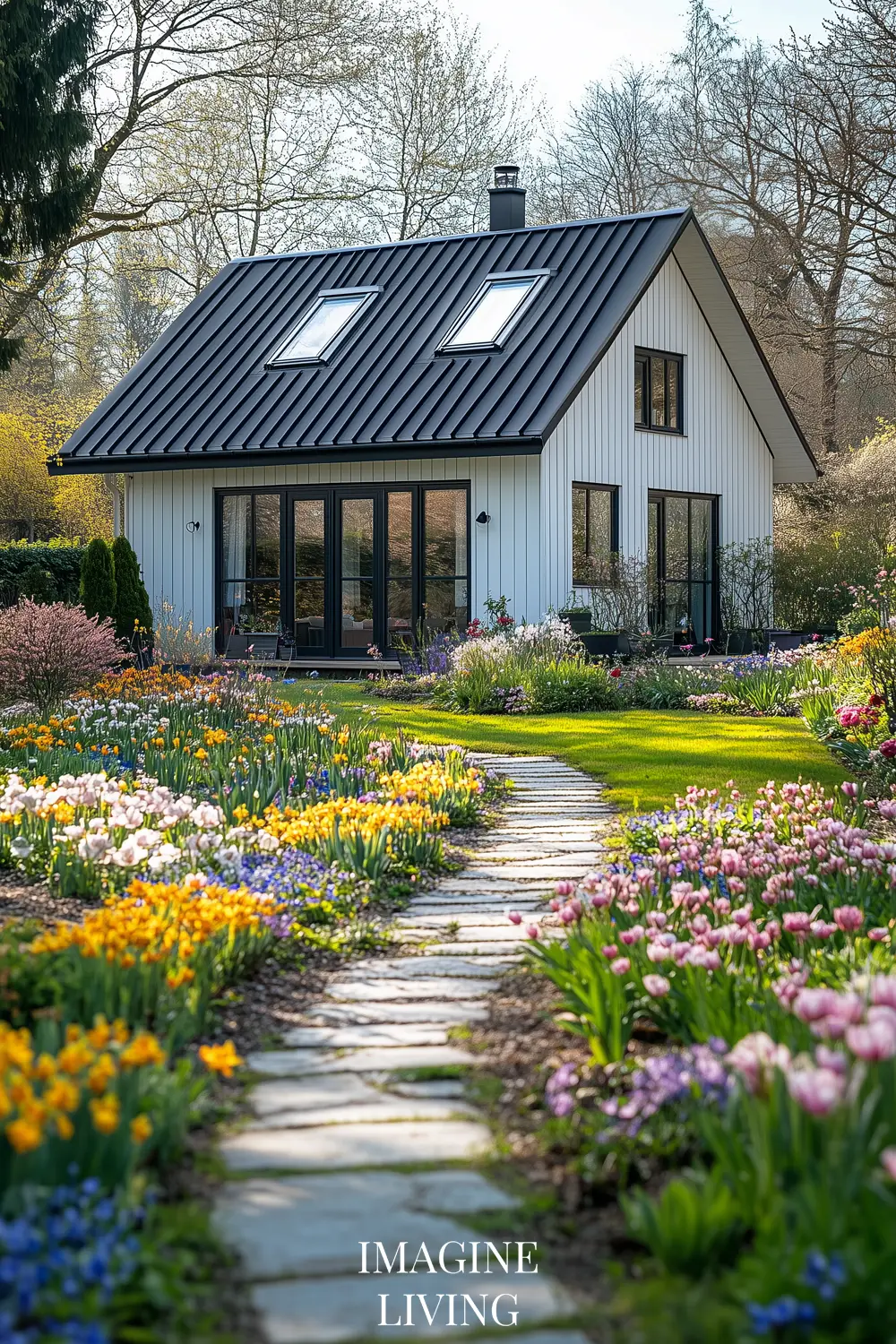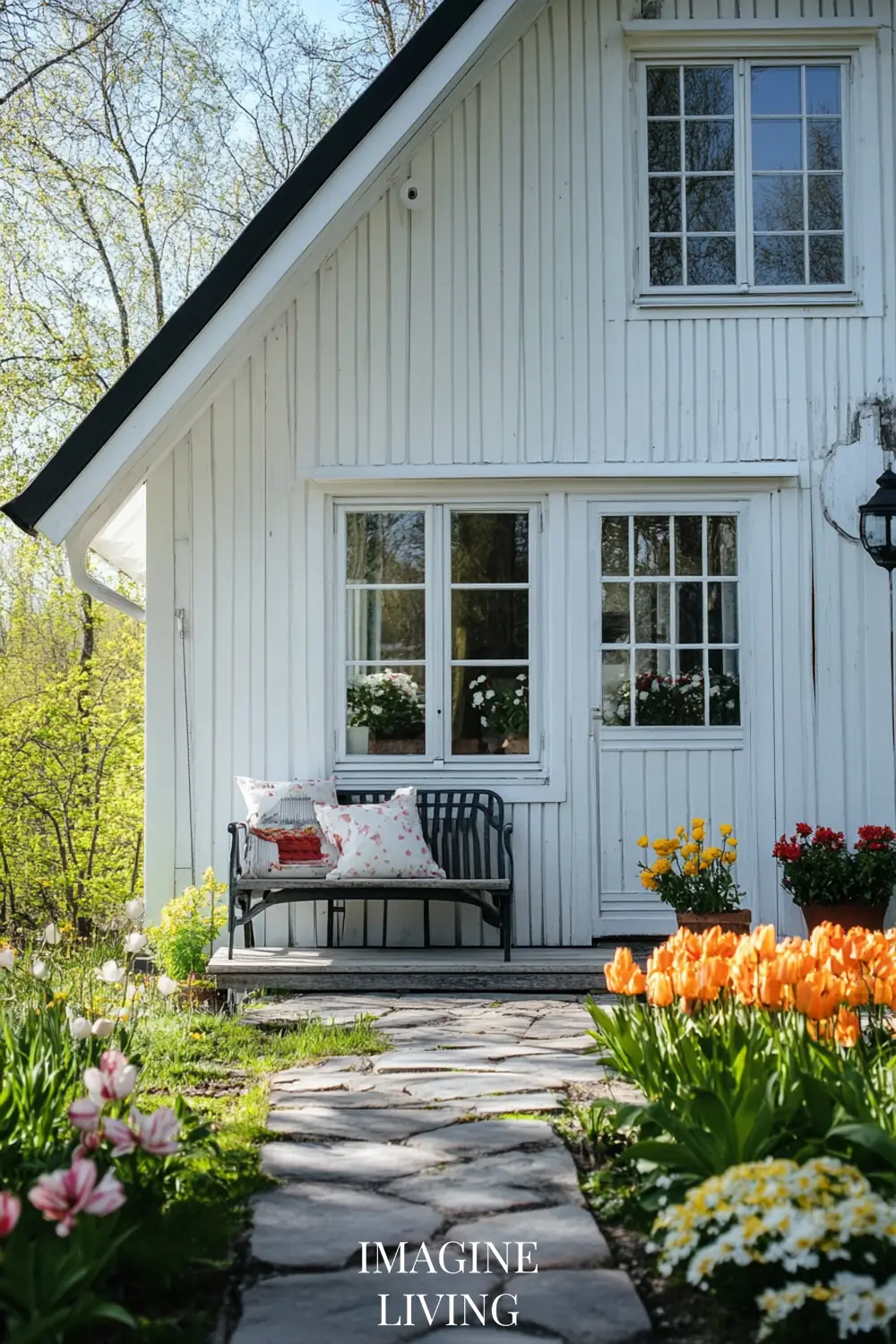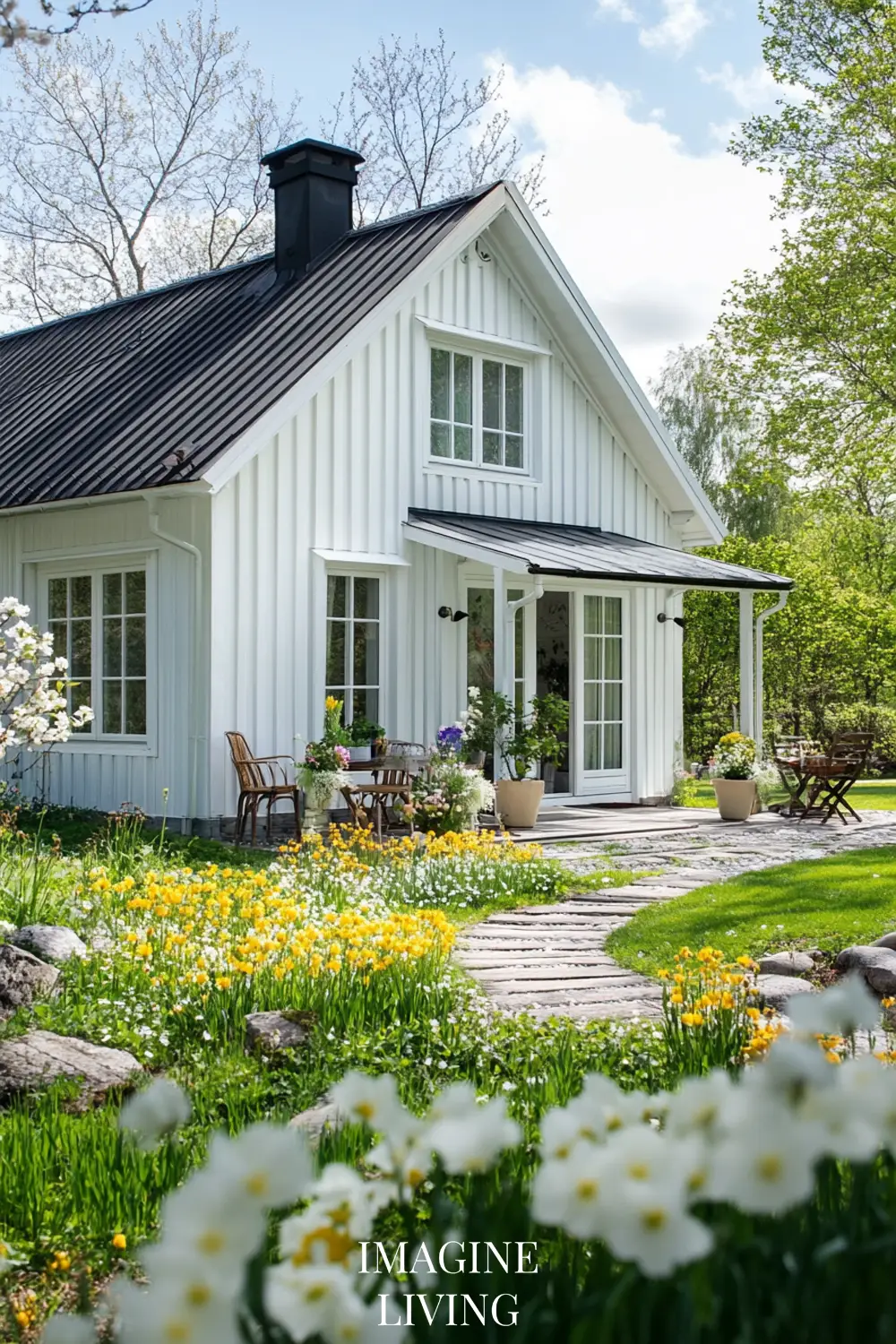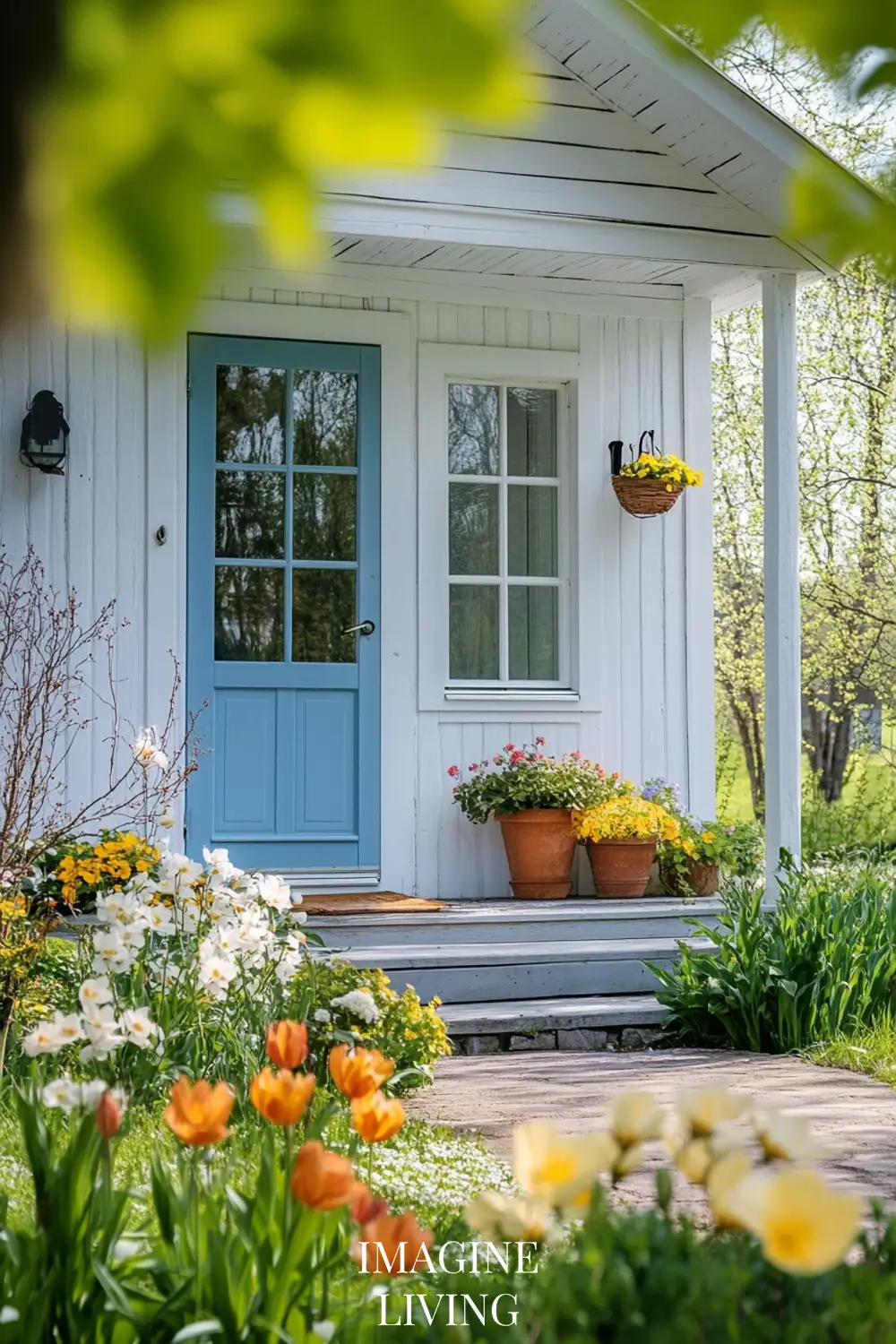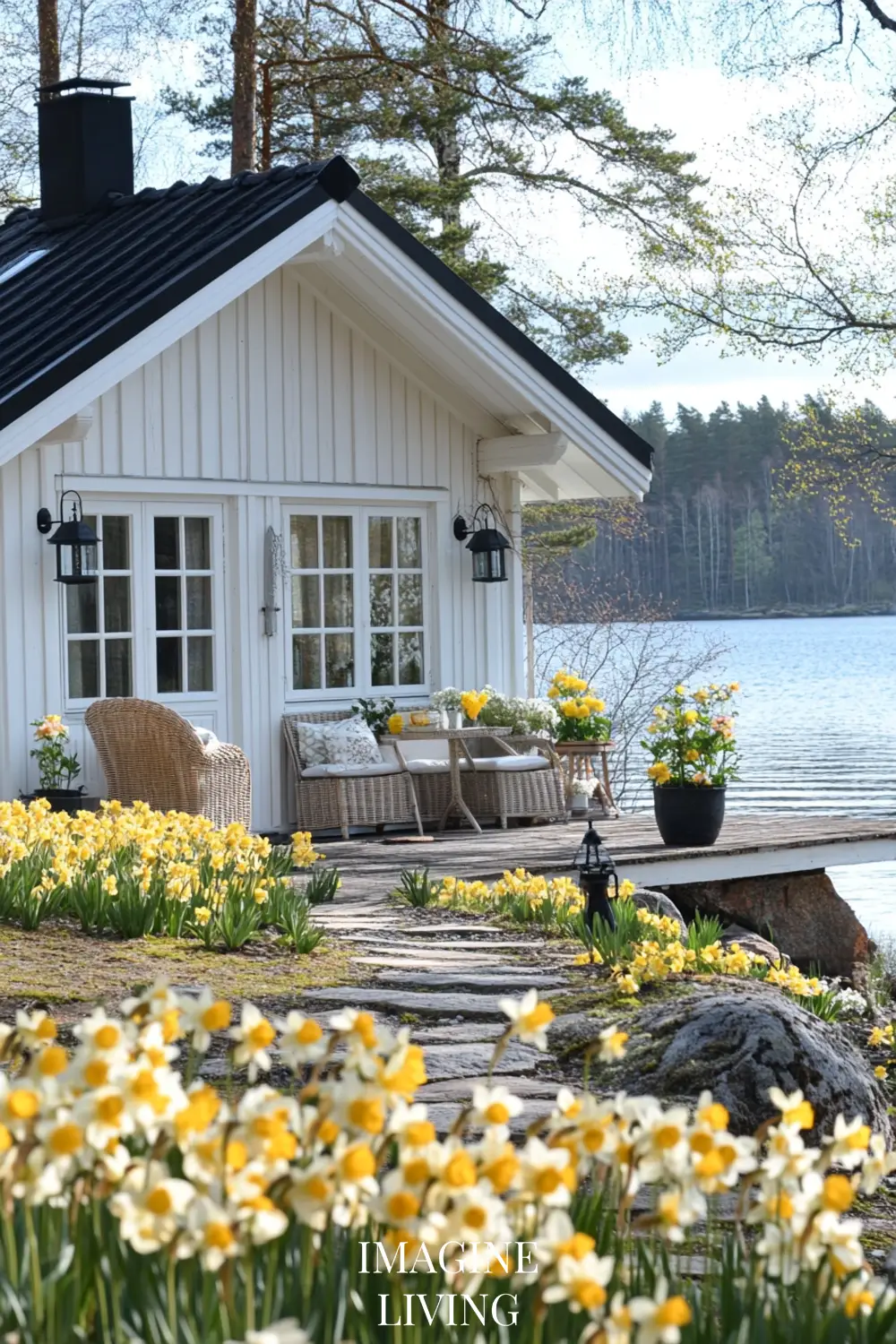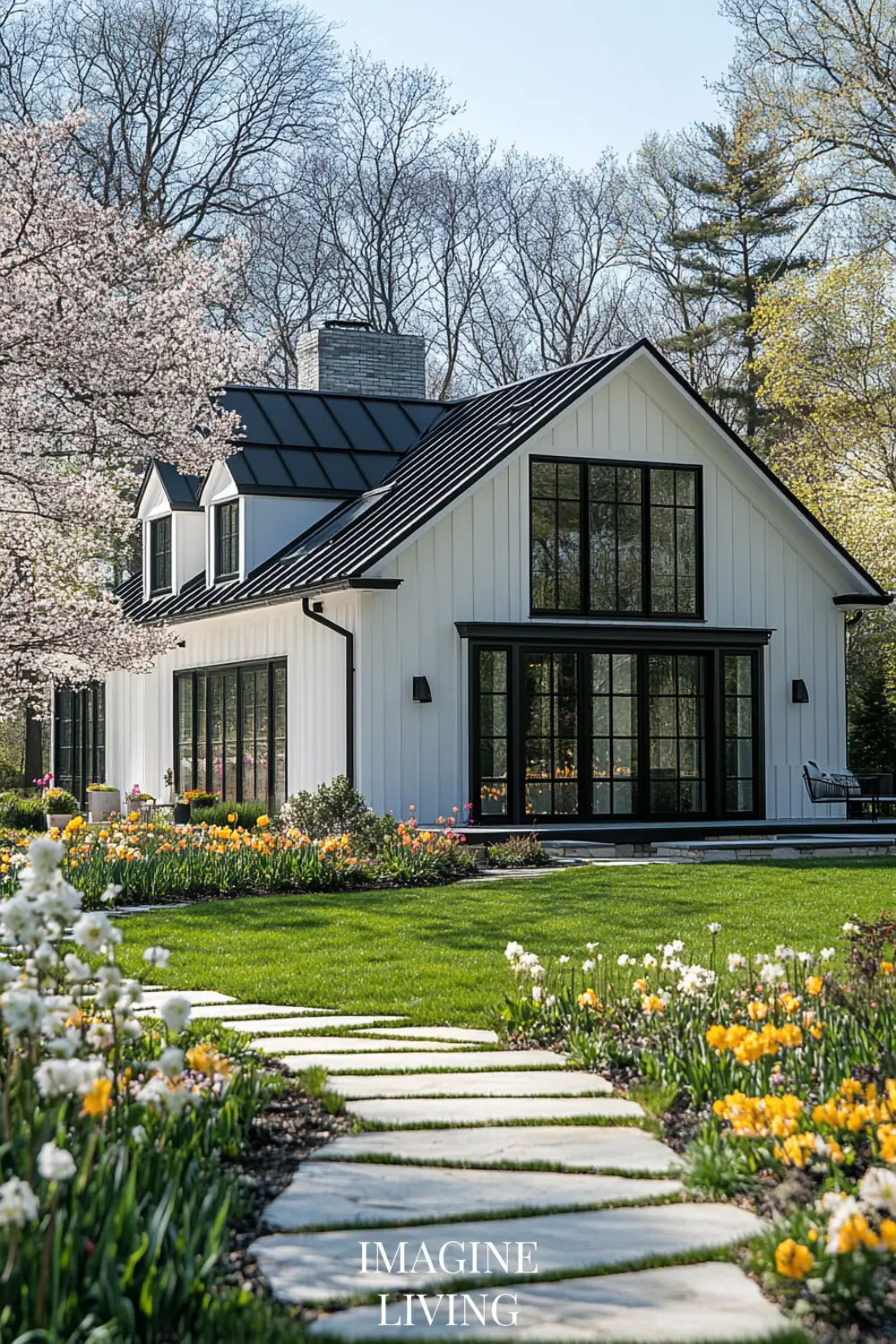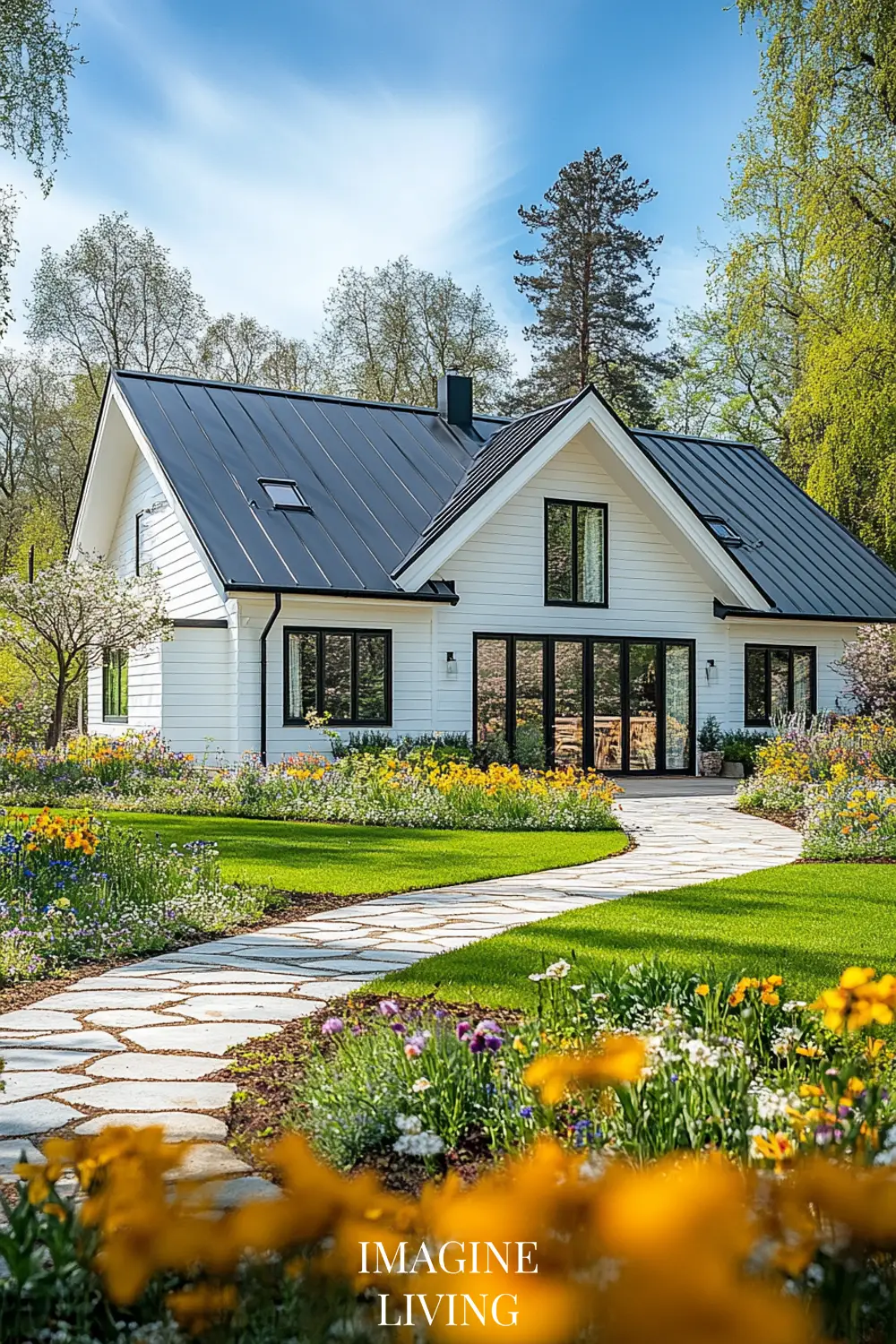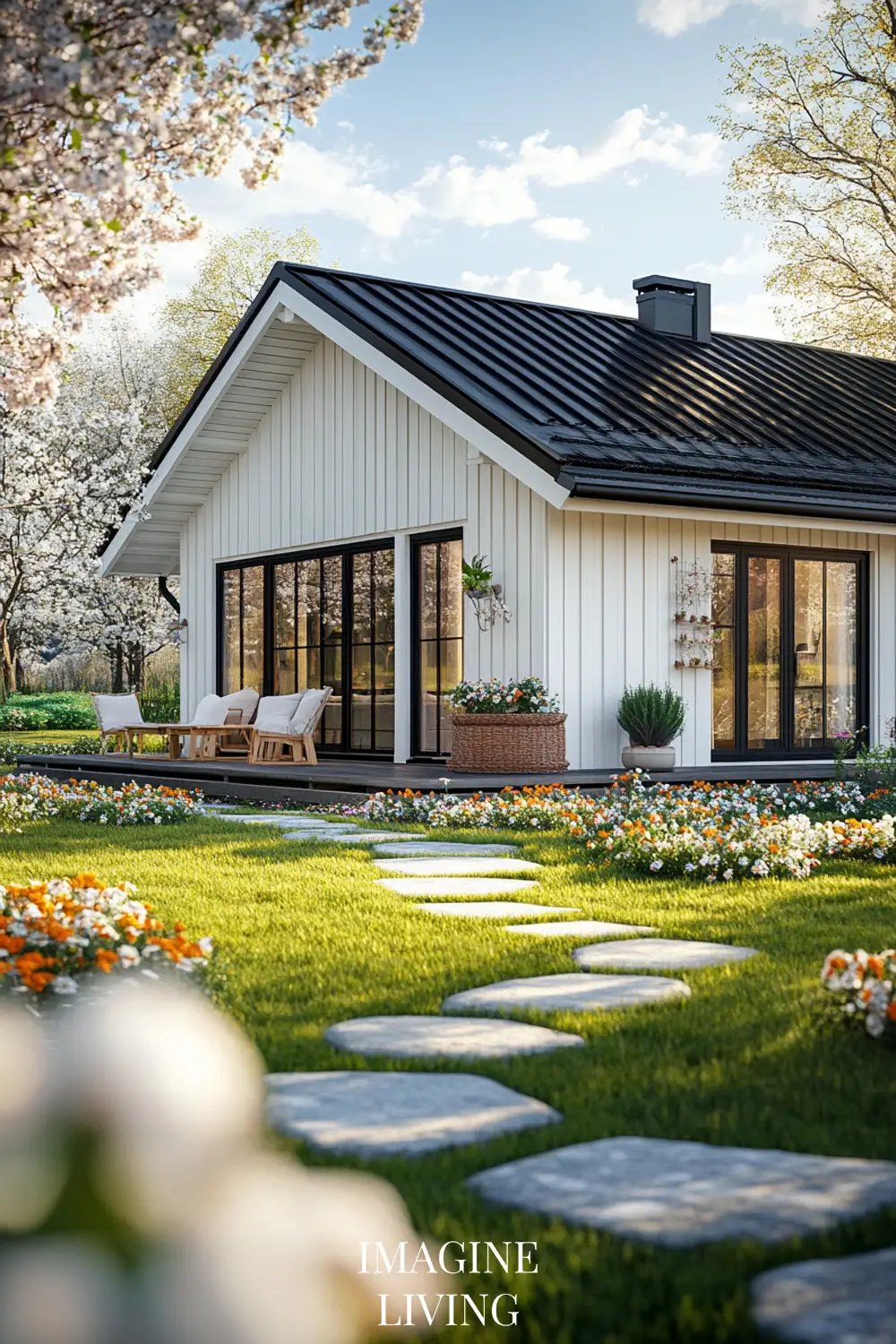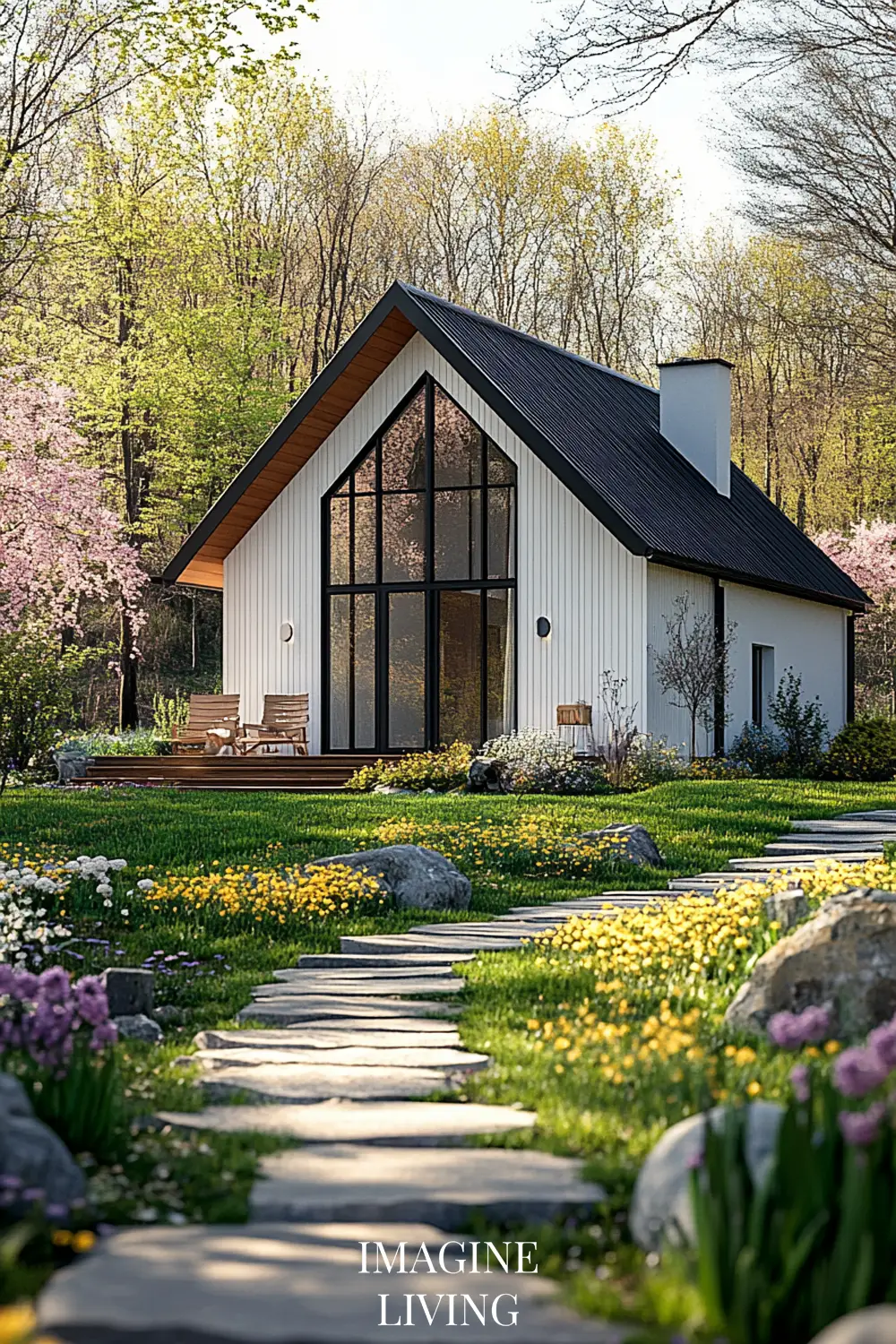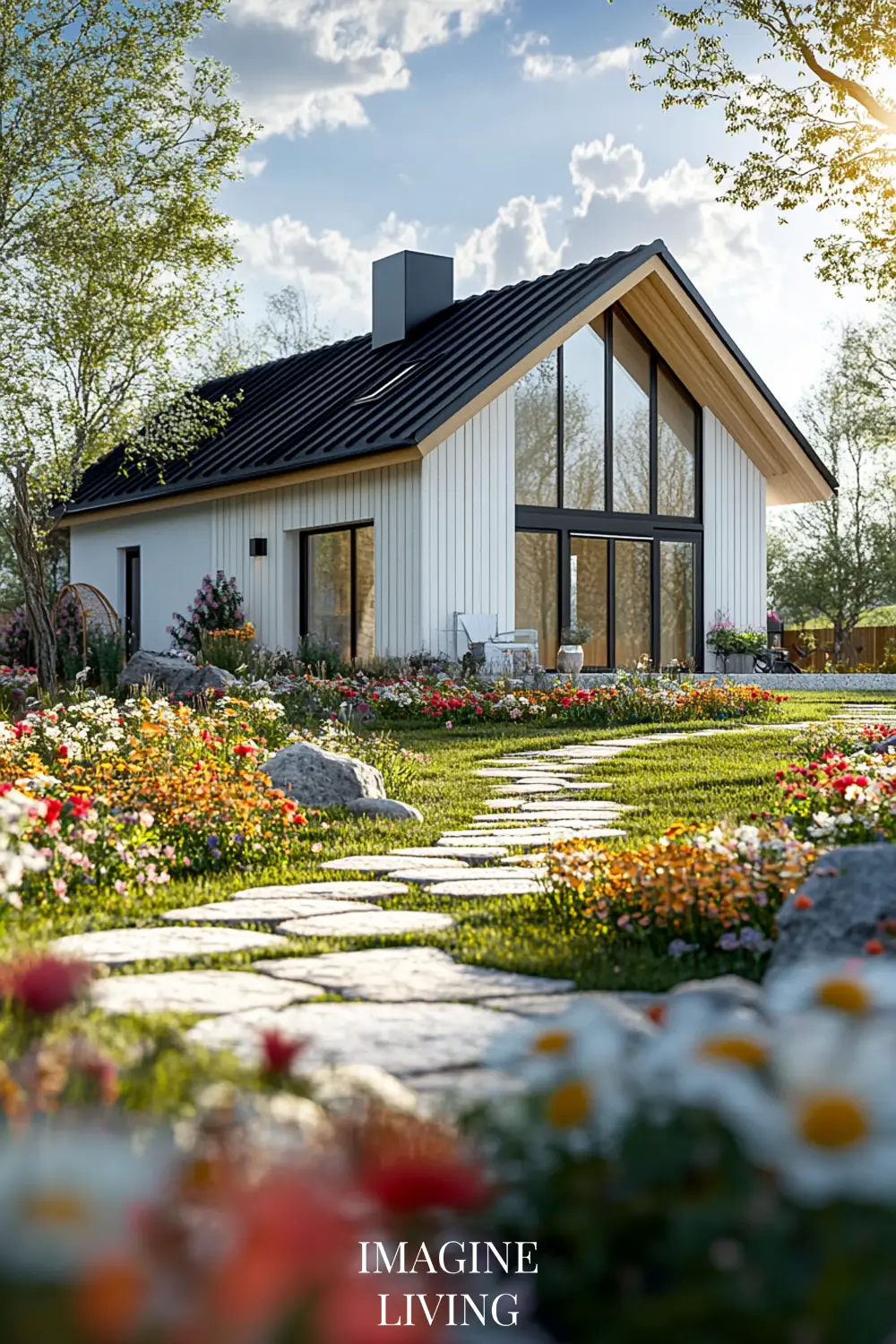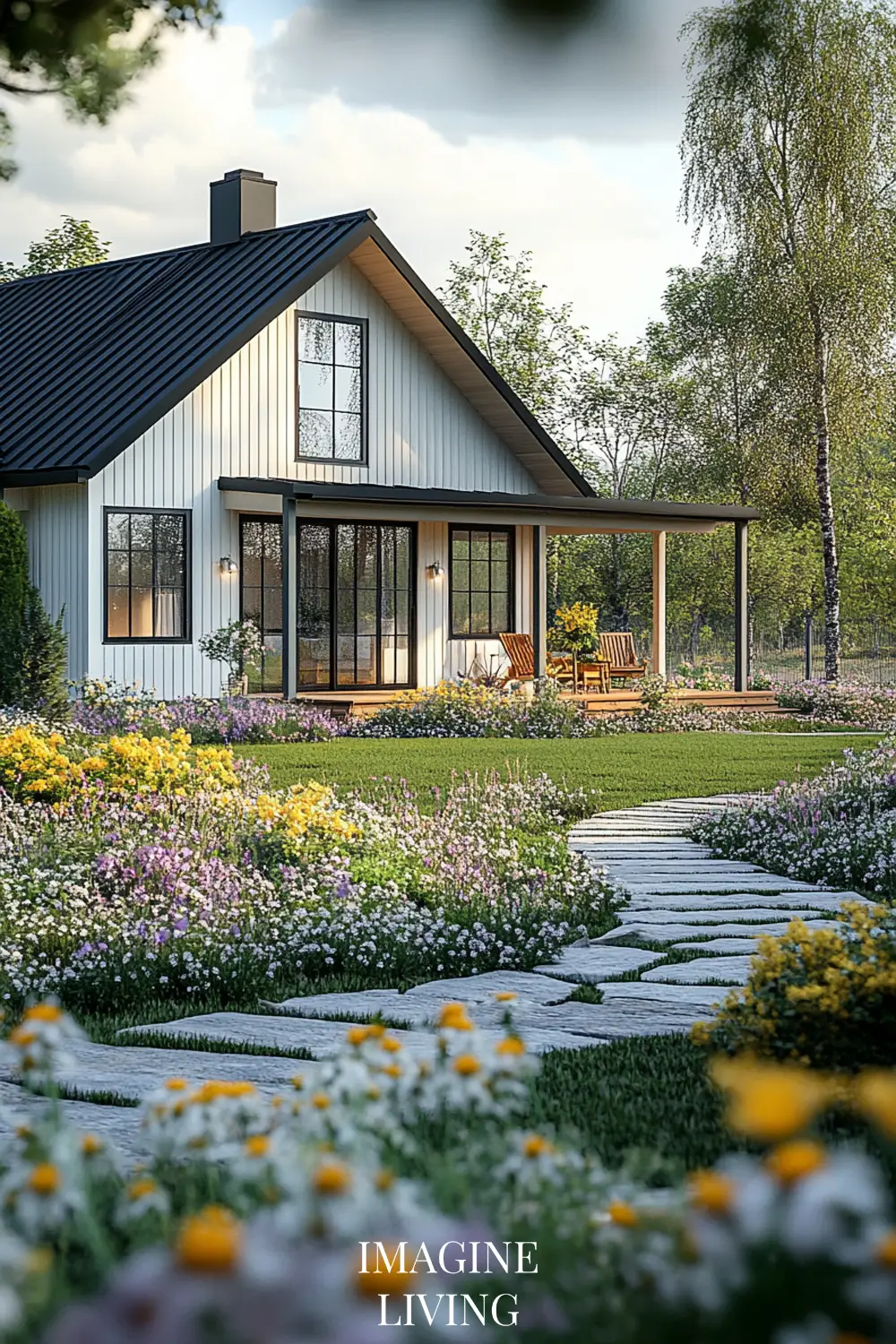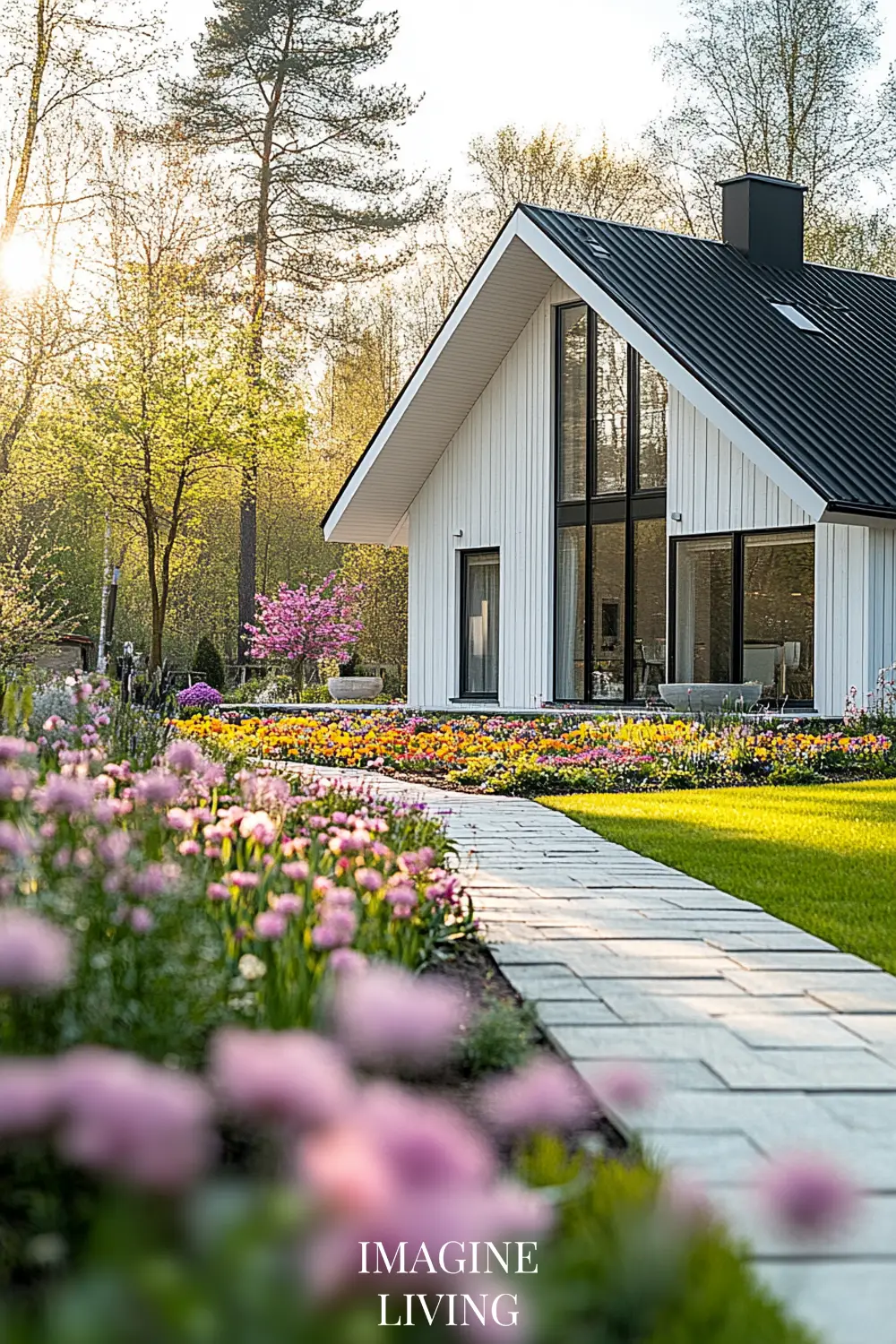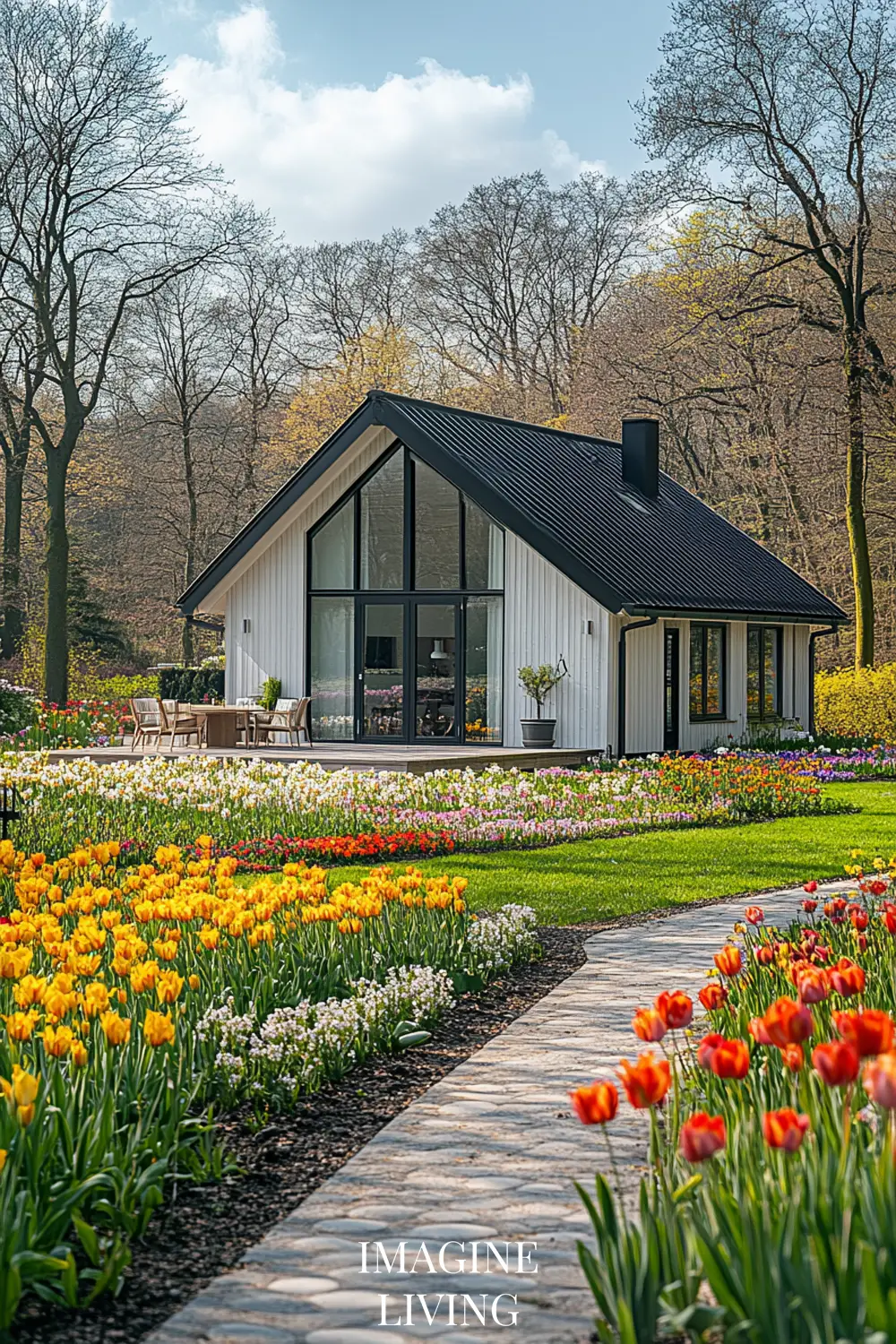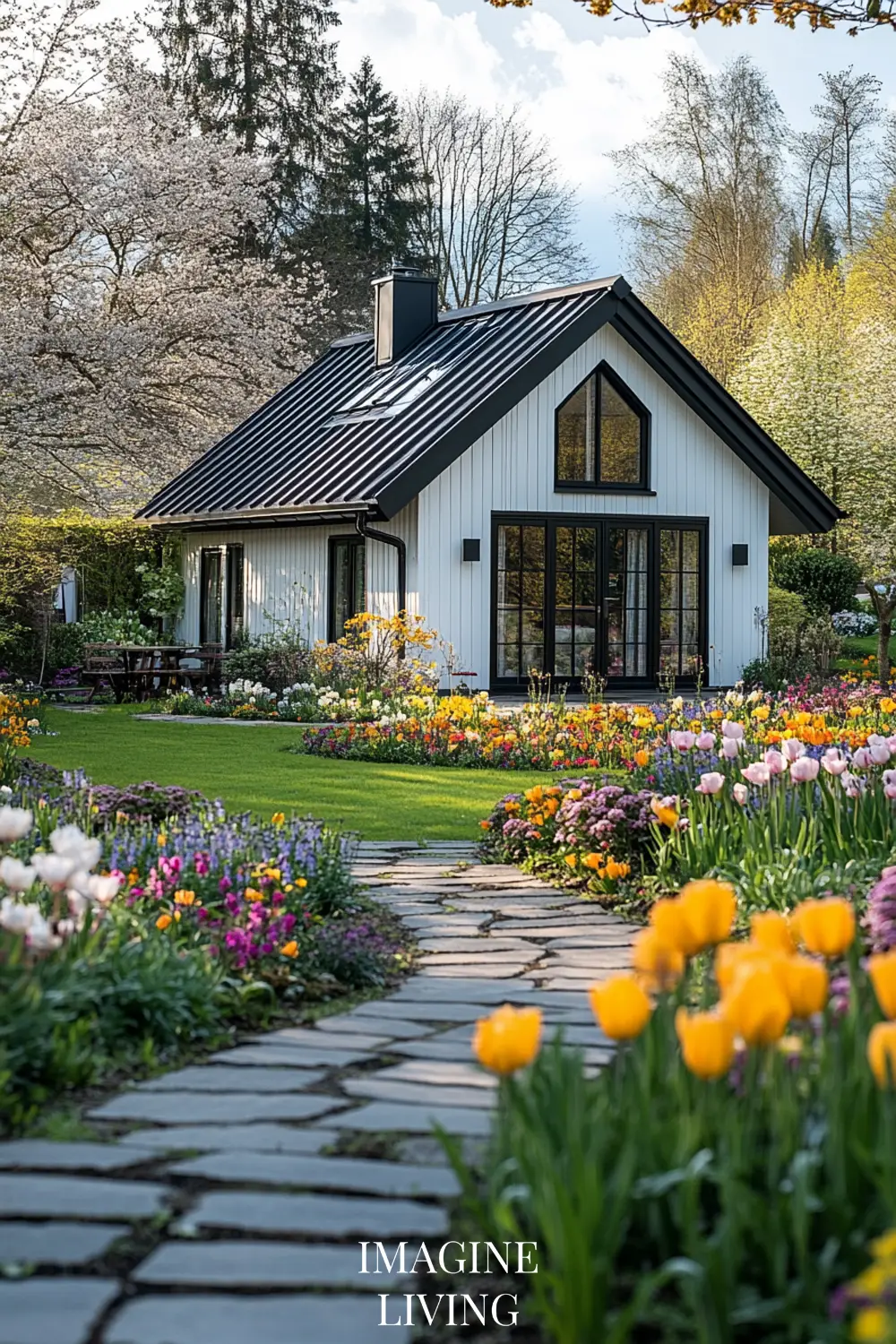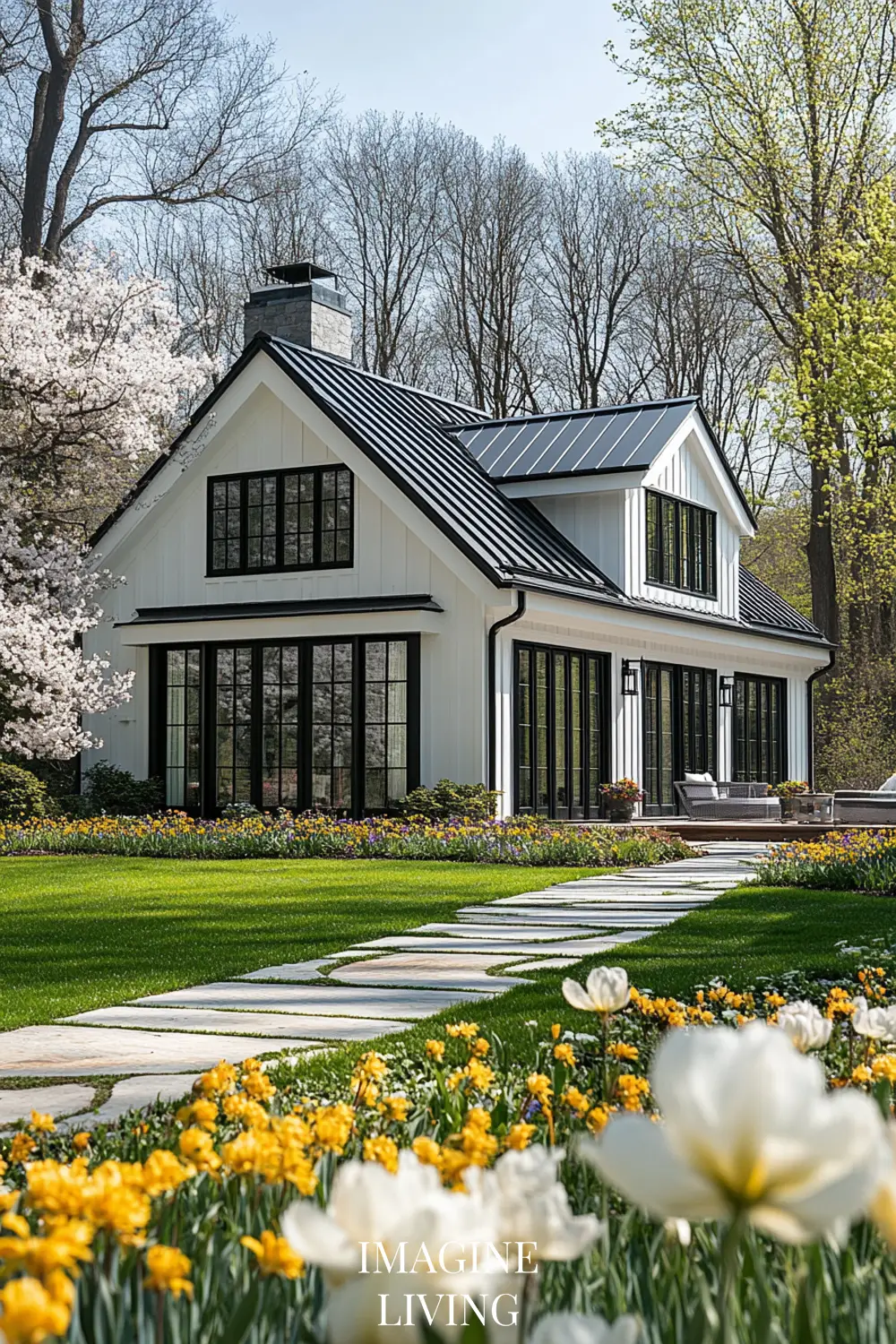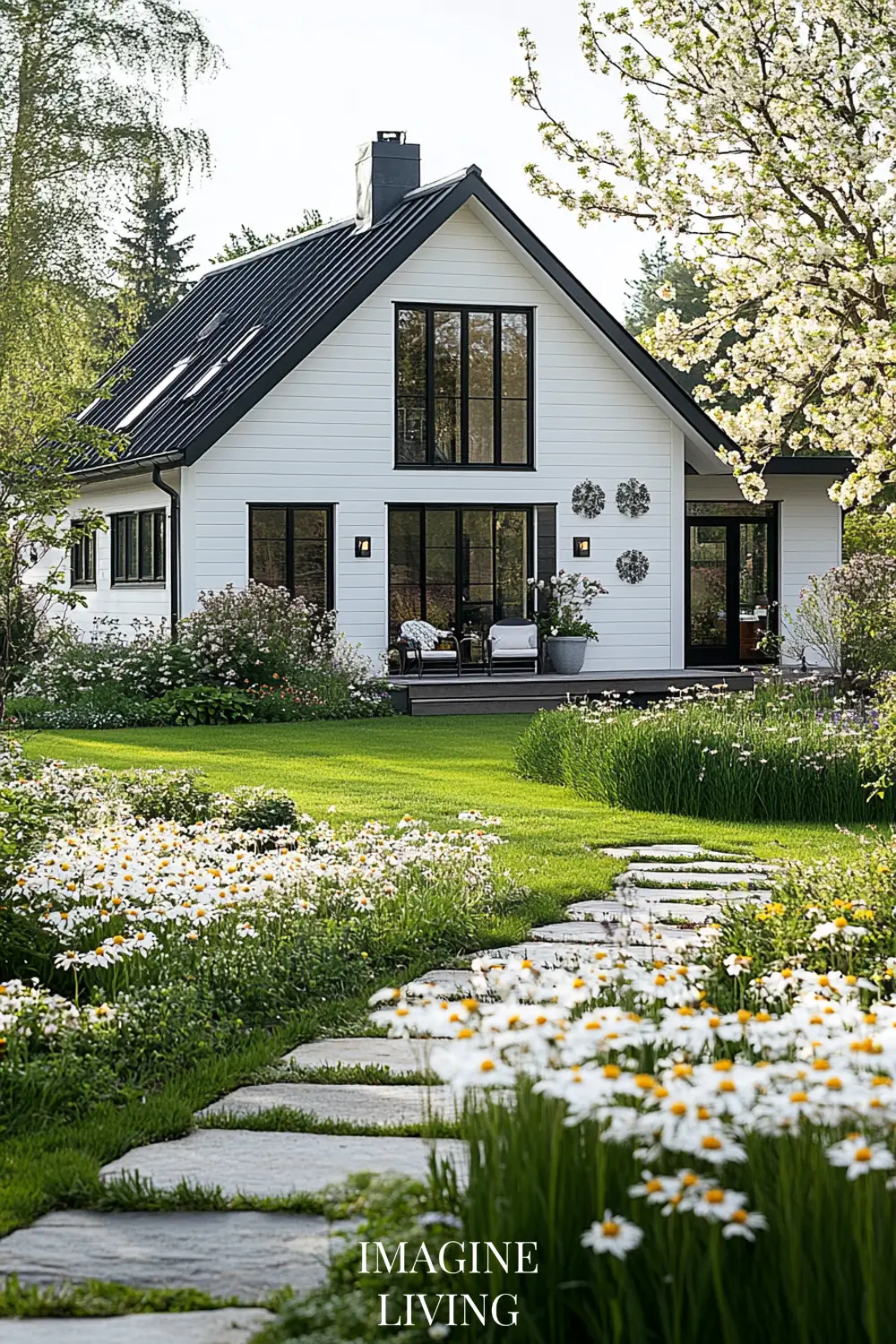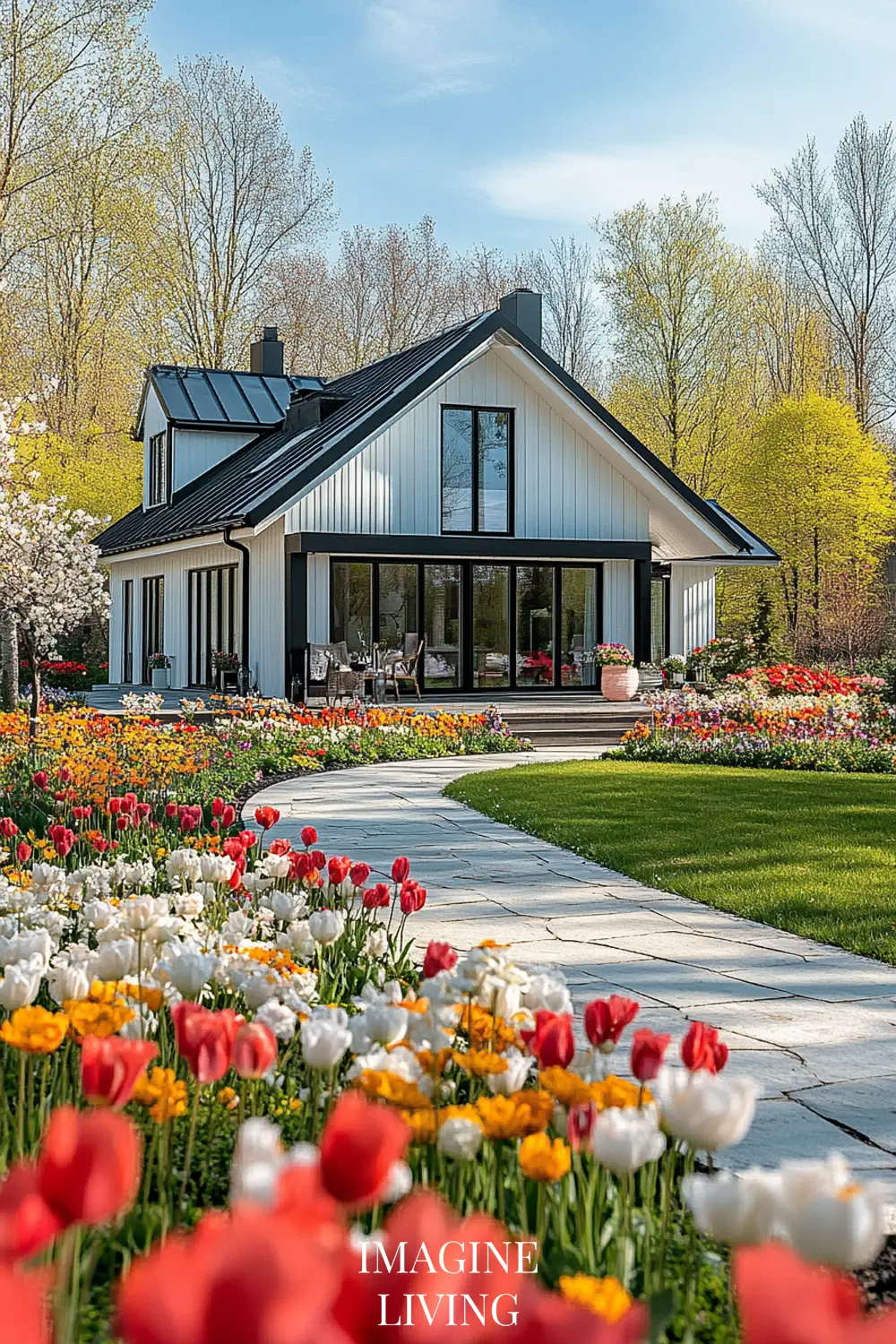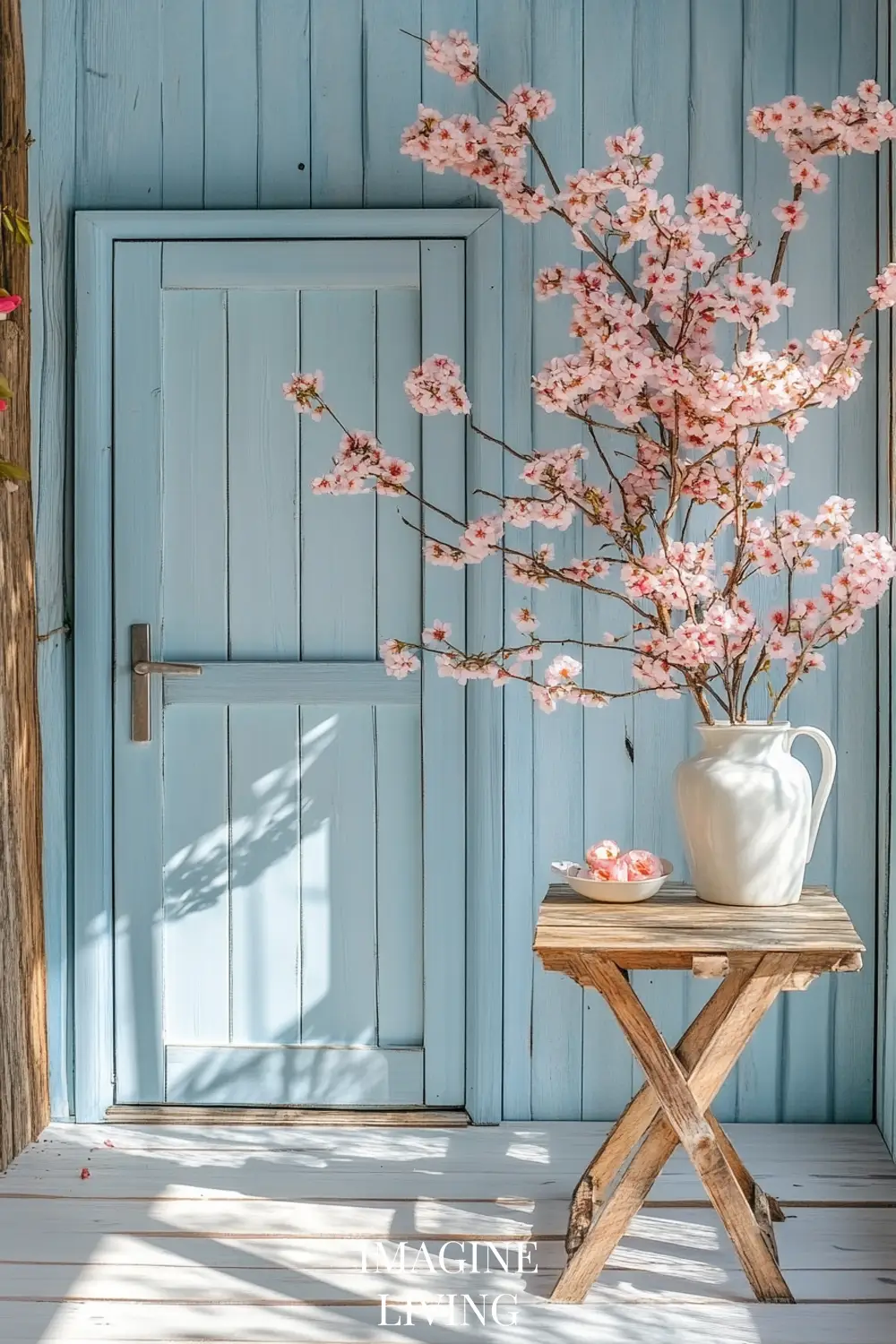
The Art of Simple Elegance
Scandinavian cottage exteriors embody a refined simplicity that feels both modern and timeless. They capture the essence of Nordic living—where nature is embraced, materials are kept natural, and outdoor spaces seamlessly blend with the surrounding landscape.
In spring, these homes take on an even more serene charm. White-washed facades, black metal or wood roofs, and clean lines are softened by gentle greenery and delicate blooms. The landscaping remains intentional yet unfussy, with neatly arranged flower patches, structured pathways, and natural stone elements that enhance the minimalist aesthetic without overwhelming it.
If you’re drawn to the effortlessly stylish, nature-connected appeal of Scandinavian design, here’s how to style your cottage exterior to reflect this distinct, calming beauty.
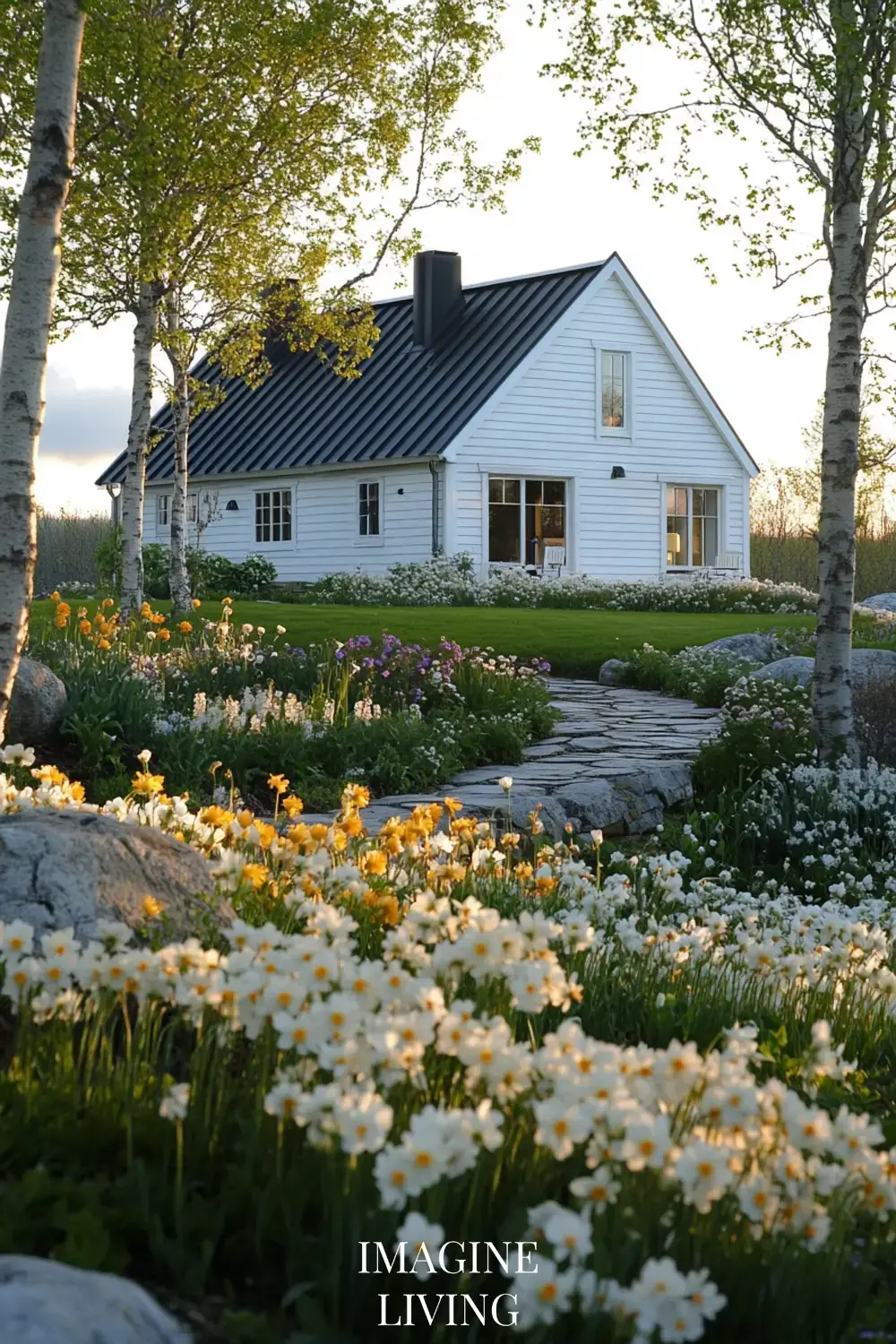
1. The Scandinavian Approach to Landscaping
Scandinavian gardens focus on structure, restraint, and an organic flow with nature. Unlike overflowing cottage gardens, the plant choices are deliberate, creating a well-balanced interplay of textures and tones.
Key Elements of a Scandinavian Spring Cottage Garden:
✔ Minimalist Planting: Flowers and greenery are arranged in intentional patches rather than blending into each other, allowing breathing space between plant groupings.
✔ Defined Pathways: Stone or gravel paths maintain clean structure, often leading towards entryways or seating nooks.
✔ Soft, Neutral Color Palette: White tulips, daffodils, and subtle yellows or soft pinks add gentle warmth against cool-toned facades.
✔ Ornamental Grasses: Low-maintenance grasses sway in the breeze, adding movement without visual clutter.
✔ Subtle Wildflower Integration: A touch of wildflowers is welcome, but they remain controlled—appearing along fences or between stone elements rather than dominating the space.
💡 Tip: Keep your garden beds structured with clear separation between plant types while maintaining a natural, slightly asymmetrical layout to prevent it from looking overly rigid.
Scandinavian landscapes are deeply connected to nature, designed to harmonize with the surrounding environment rather than overpower it. Whether it’s a coastal retreat, a forest hideaway, or a minimalist urban space, the landscaping approach prioritizes simplicity, function, and seasonal adaptability.

Regional Influences on Scandinavian Garden Design
- Coastal Gardens (Denmark, Southern Sweden, Norwegian Fjords)
- Characterized by wind-resistant grasses, hardy perennials, and sandy soil plants like sea thrift and beach roses.
- Stone pathways, wooden decks, and soft dunes integrate seamlessly with the natural shoreline.
- Furniture is often low-profile and weather-resistant, designed to endure the salty air.
- Inland & Forest Gardens (Sweden, Norway, Finland)
- Surrounded by pine, spruce, and birch trees, these gardens lean toward naturalistic layouts with moss-covered stones, ferns, and wildflowers.
- Firepits, wooden benches, and simple outdoor saunas create a cozy retreat within the landscape.
- Darker exteriors contrast beautifully against the snow in colder months, making white and black painted wood a common aesthetic.
- Urban & Small-Space Scandinavian Gardens
- In cities like Copenhagen or Stockholm, compact gardens make use of vertical gardening, potted plants, and multi-functional outdoor furniture.
- Balconies and terraces often feature wooden decking, lanterns, and potted hydrangeas or ivy to bring a natural feel to the space.
- Green roofs and climbing plants help soften modern architectural lines, keeping a close connection to nature.
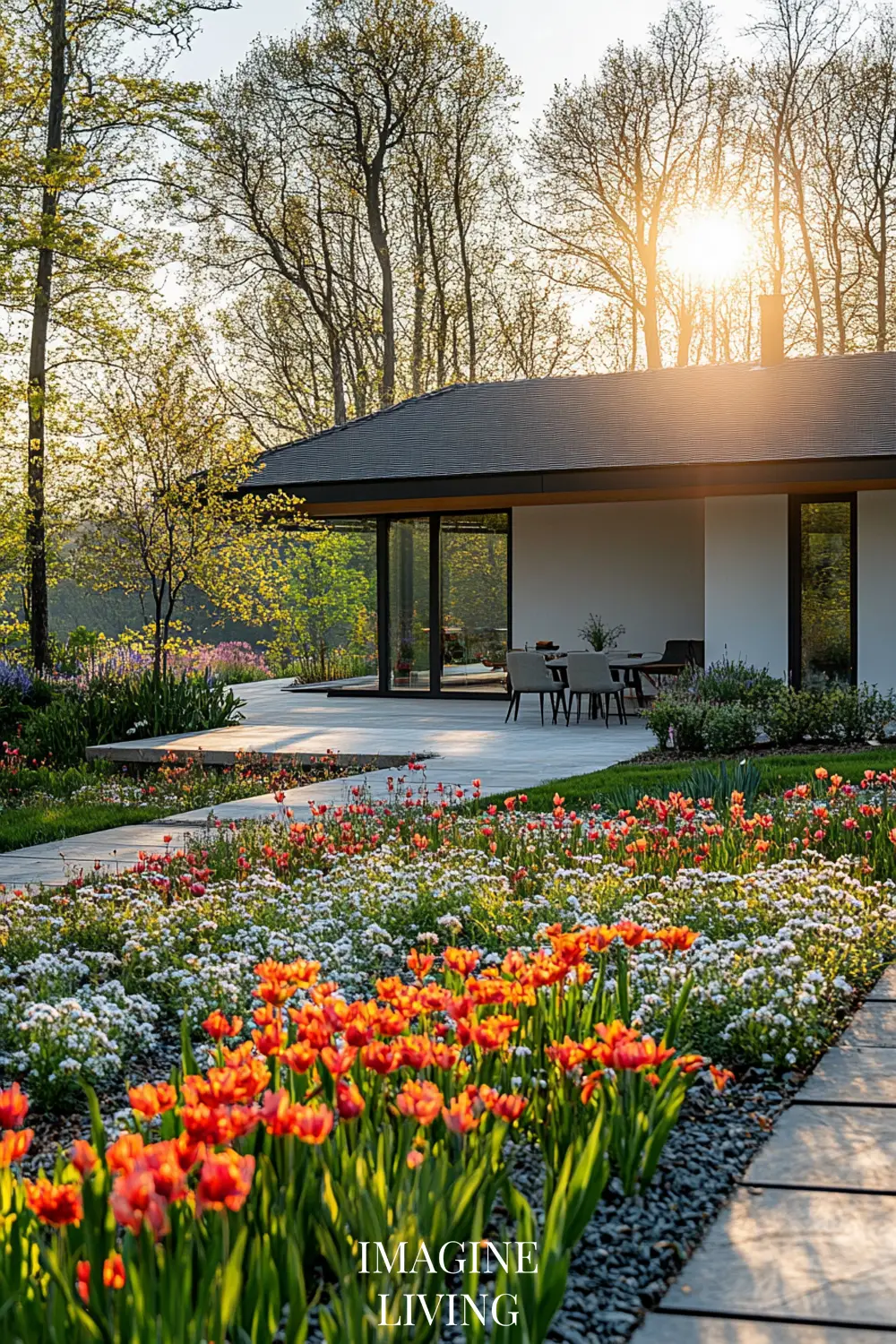
How a Scandinavian Garden Evolves Through the Seasons
Scandinavian gardens are designed to evolve gracefully across seasons, ensuring visual interest throughout the year:
- Early Spring: Snowdrops, crocuses, and hellebores bloom first, followed by daffodils and tulips in garden beds.
- Late Spring & Summer: The garden reaches its peak with lush greenery, structured hedges, and blooming perennials like peonies, lupines, and foxgloves.
- Autumn: Trees take on warm hues of amber and rust, while ornamental grasses and dried seed heads add movement to the landscape.
- Winter: Evergreens like juniper and boxwood provide structure, while bare branches and frost-covered stone paths create a minimal but poetic aesthetic.
💡 Tip: A true Scandinavian garden embraces imperfection—wildflowers, moss-covered rocks, and natural materials help create an organic, lived-in feel.
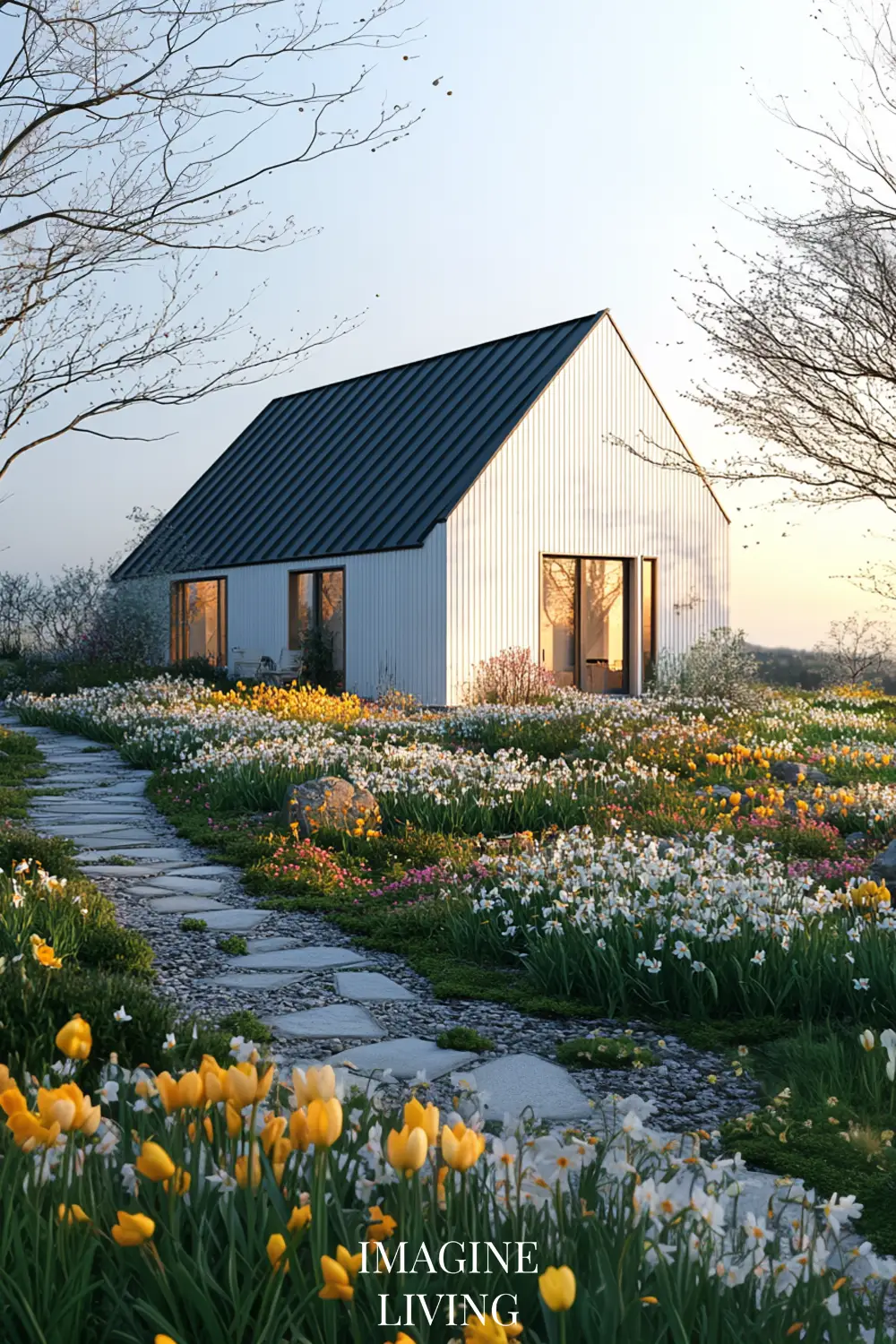
2. Must-Have Plants for a Scandinavian Spring Cottage
Scandinavian landscapes rely on a balance of evergreens, delicate perennials, and spring blooms to create a clean yet organic outdoor setting.
Ideal Flower & Plant Choices:
- Tulips & Daffodils: Spring classics that bring a soft touch of color without overwhelming the clean aesthetic.
- Lily of the Valley: A Nordic favorite known for its delicate white flowers and fresh fragrance.
- Ornamental Grasses: Karl Foerster grass or feather reed grass add gentle texture to structured beds.
- Boxwood or Yew Hedges: Provide neat, evergreen structure against the more relaxed flower beds.
- Birch Trees or Small Japanese Maples: Elegant yet understated, these trees complement the minimalist aesthetic.
💡 Tip: Stick to a cohesive, neutral-toned plant palette—soft whites, dusty greens, pale yellows, and delicate blues create a Scandinavian-inspired garden that feels effortless yet polished.
The beauty of Scandinavian gardens lies in their understated elegance, with plants chosen not only for aesthetics but also for resilience in cool climates. A mix of native species, structural greenery, and soft seasonal blooms creates a balanced and natural look.
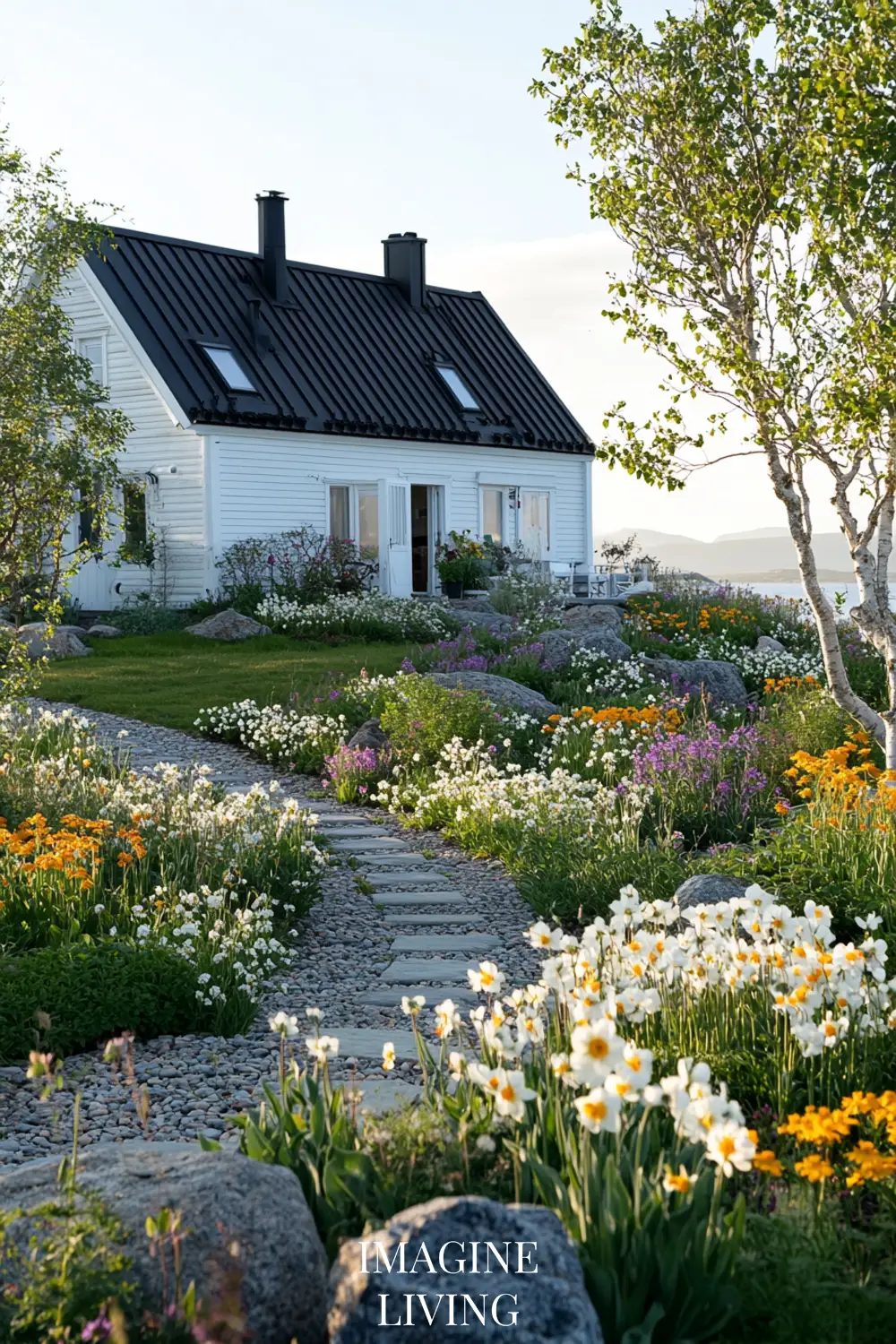
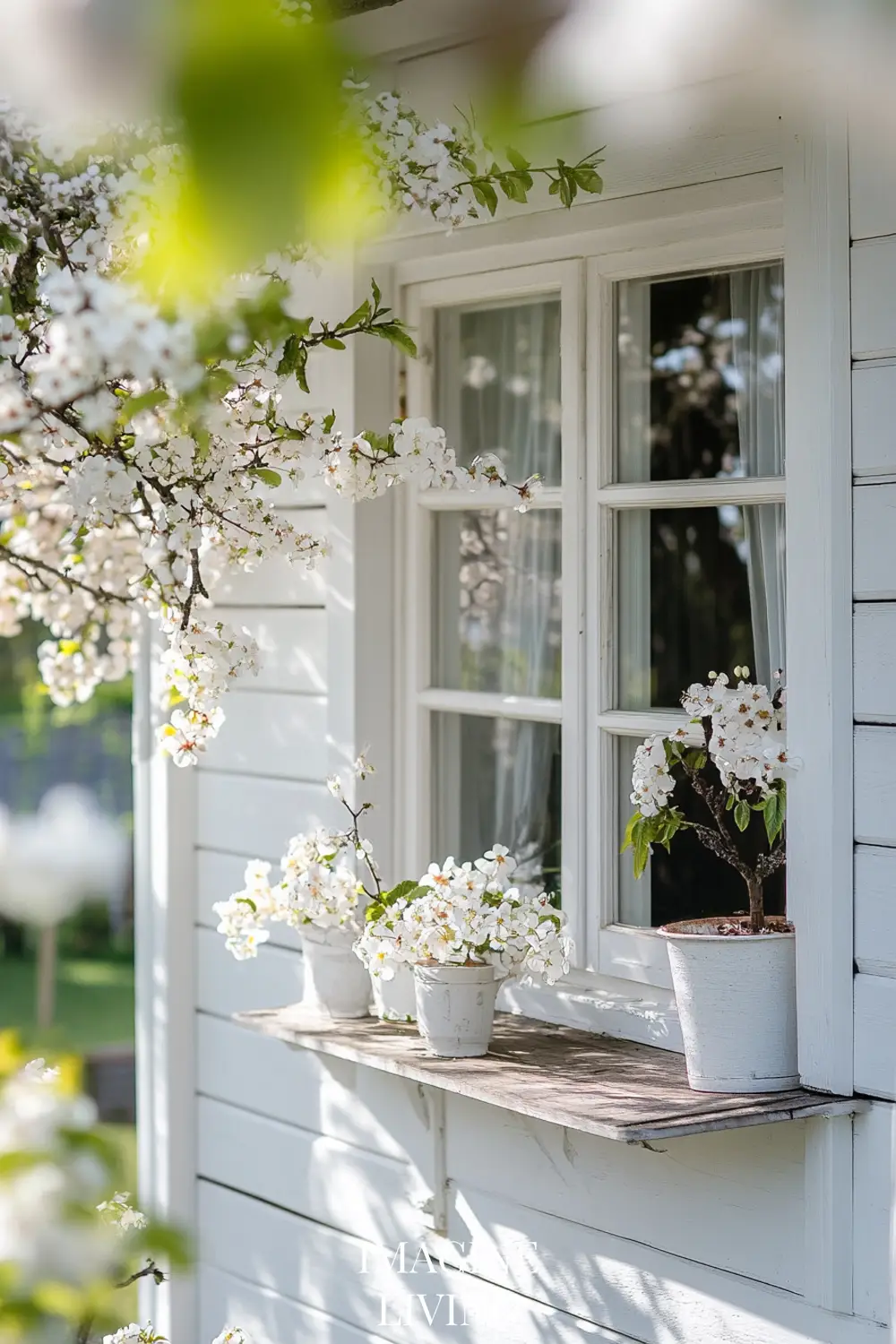
Essential Plants for a Scandinavian Garden
- Evergreens for Year-Round Structure: Juniper, boxwood, yew, and dwarf pine varieties provide depth and contrast even in winter.
- Soft Perennials: Peonies, lavender, hydrangeas, and anemones add romance and color while maintaining a natural, airy look.
- Native Wildflowers: Scandinavian meadows inspire cottage-style gardens with daisies, cornflowers, buttercups, and Queen Anne’s lace.
- Climbing Plants & Hedges: Clematis, honeysuckle, and traditional privet hedges create soft partitions and define outdoor rooms.
- Spring Bulbs: Tulips, daffodils, and alliums bring a seasonal touch without disrupting the garden’s overall simplicity.
- Low-Maintenance Ground Covers: Moss, creeping thyme, and sedum fill pathways and soften hard landscaping elements.
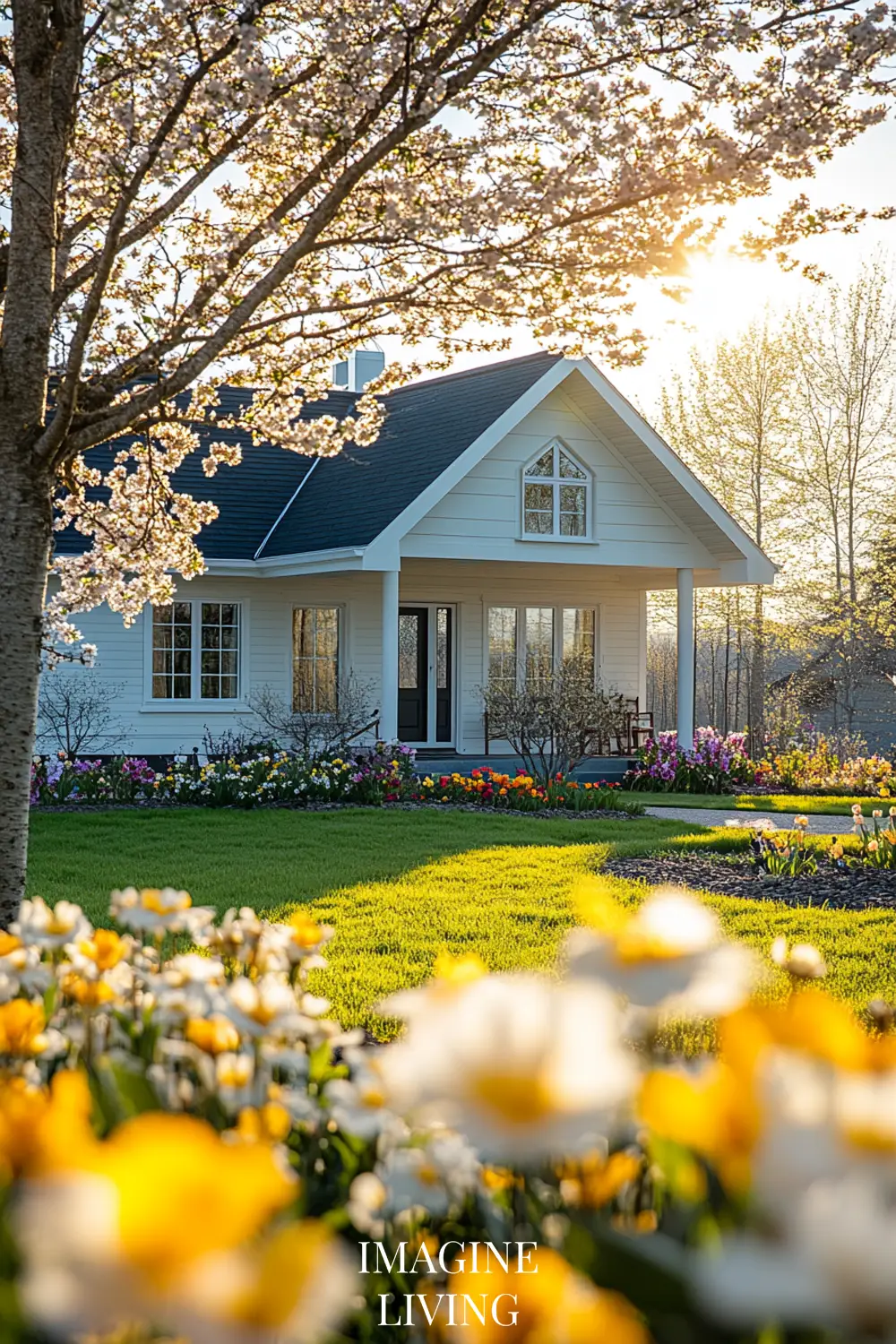
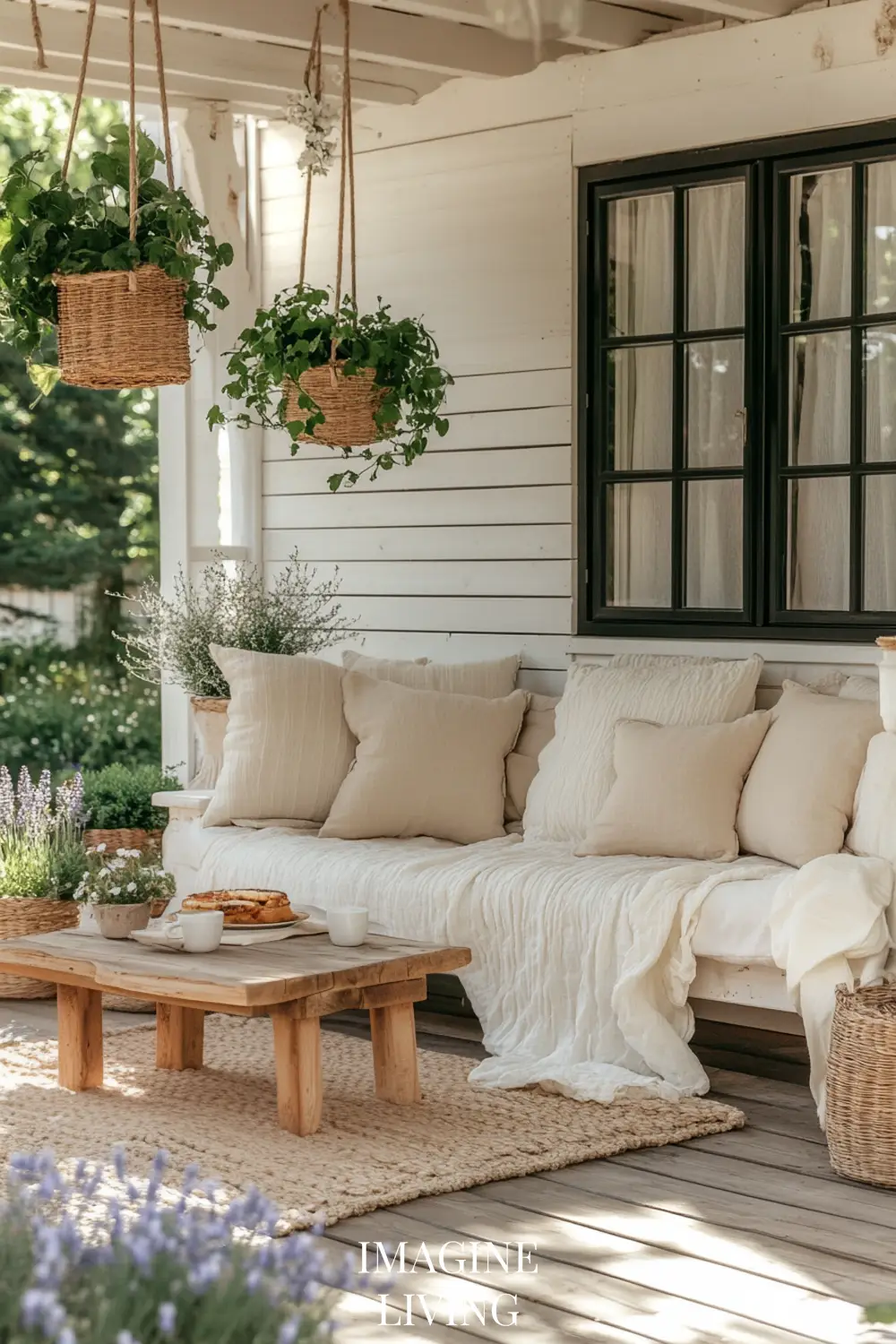
Planting Strategies & Soil Considerations
- Layering: Scandinavian gardens often feature a layered approach, mixing low-growing ground covers with medium-height perennials and taller ornamental grasses or shrubs to create depth.
- Companion Planting: Mixing evergreens with perennials ensures the garden remains structured even in colder months.
- Natural Pathway Integration: Plants often spill into gravel or stepping stone pathways, making the transition between hardscapes and softscapes feel effortless.
- Soil Considerations: Scandinavian soil tends to be sandy or rocky in coastal areas and loamy in forests, so choosing plants suited to specific conditions ensures longevity.
💡 Tip: Avoid overly manicured flower beds—Scandinavian gardens are meant to feel organic and slightly wild, with a “curated but not controlled” aesthetic.
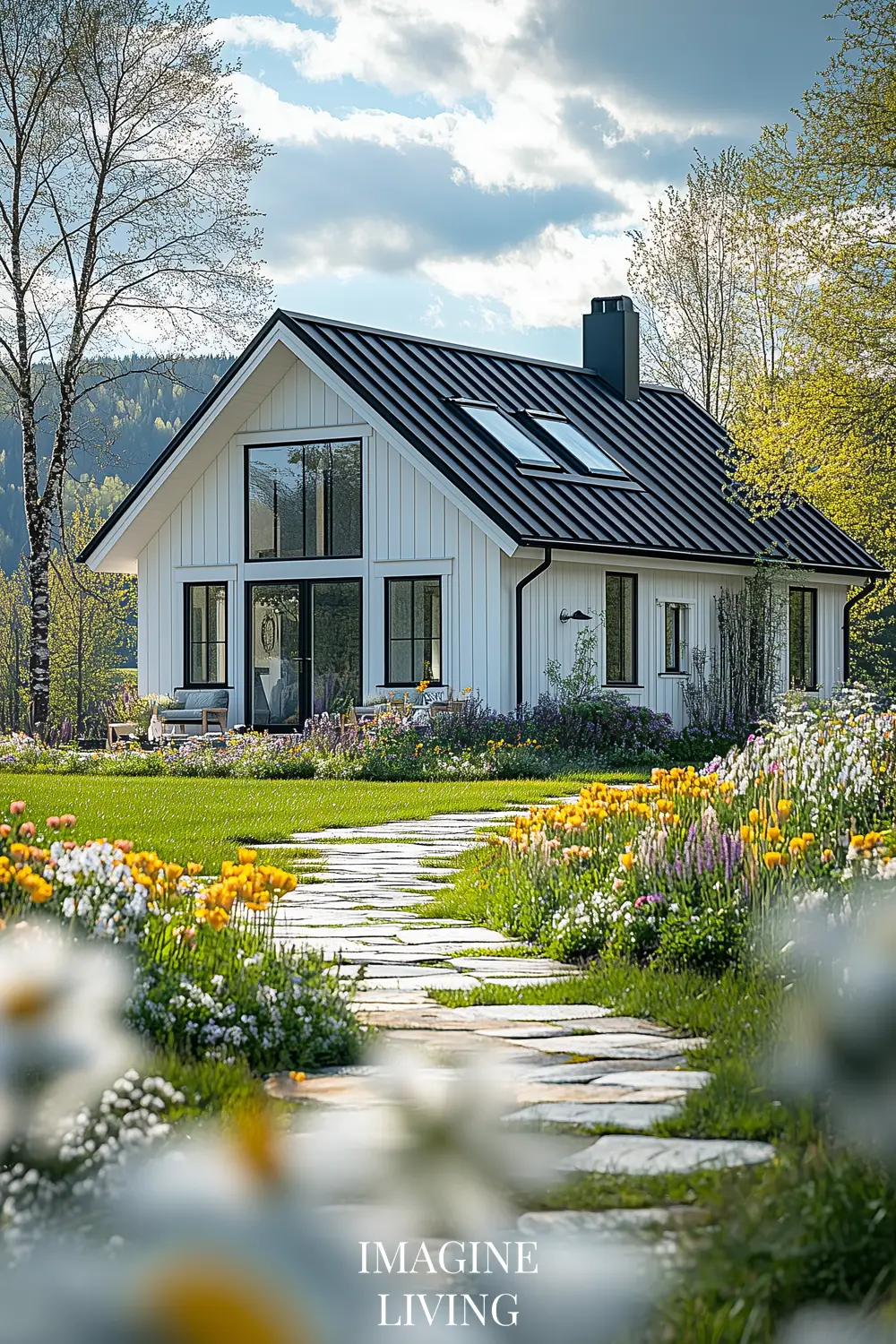

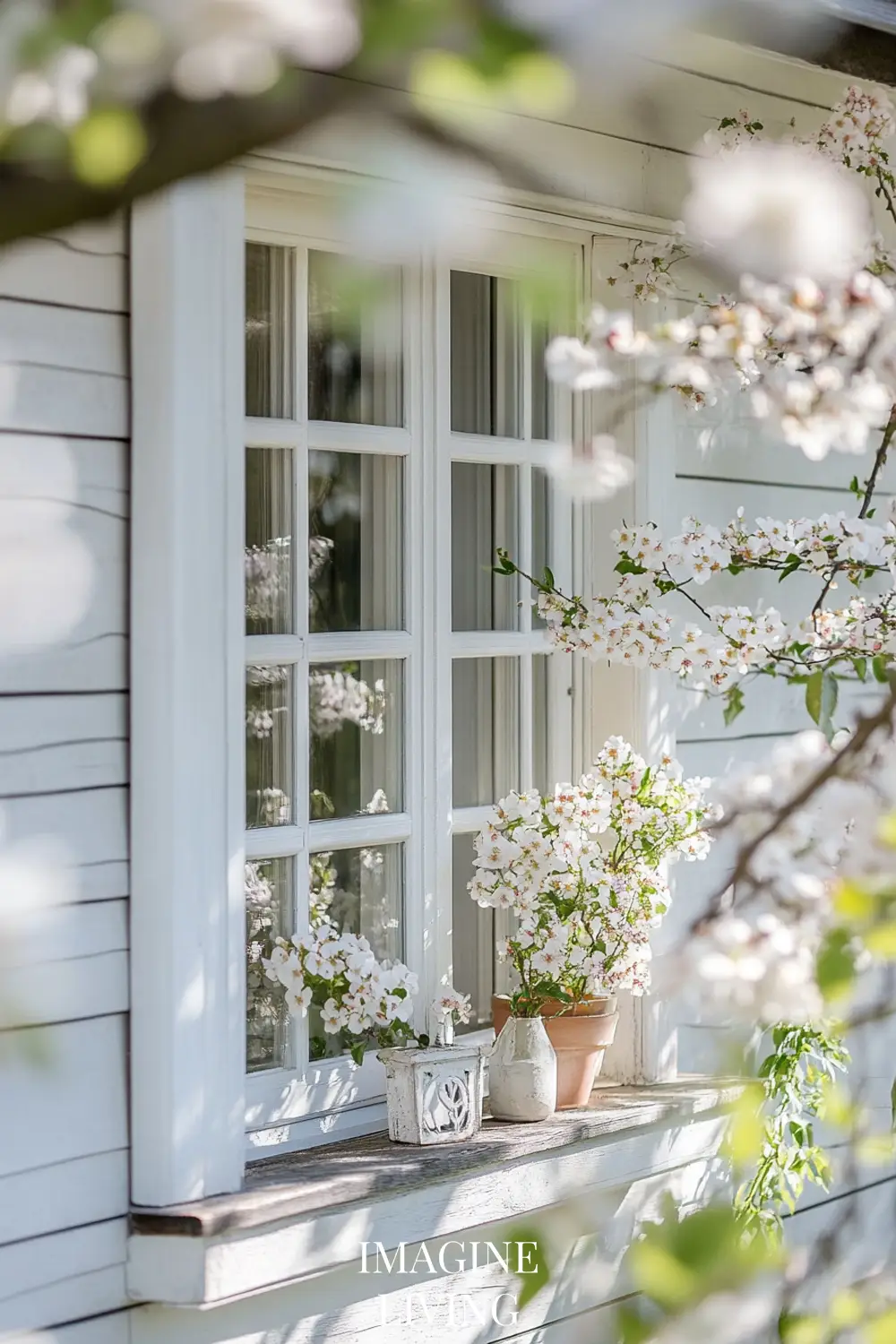
3. Architectural Details That Define the Look
The Scandinavian aesthetic relies on clean lines, natural materials, and subtle contrasts that highlight both the home and the surrounding landscape. The choice of materials and colors reflects a balance between functionality and beauty.
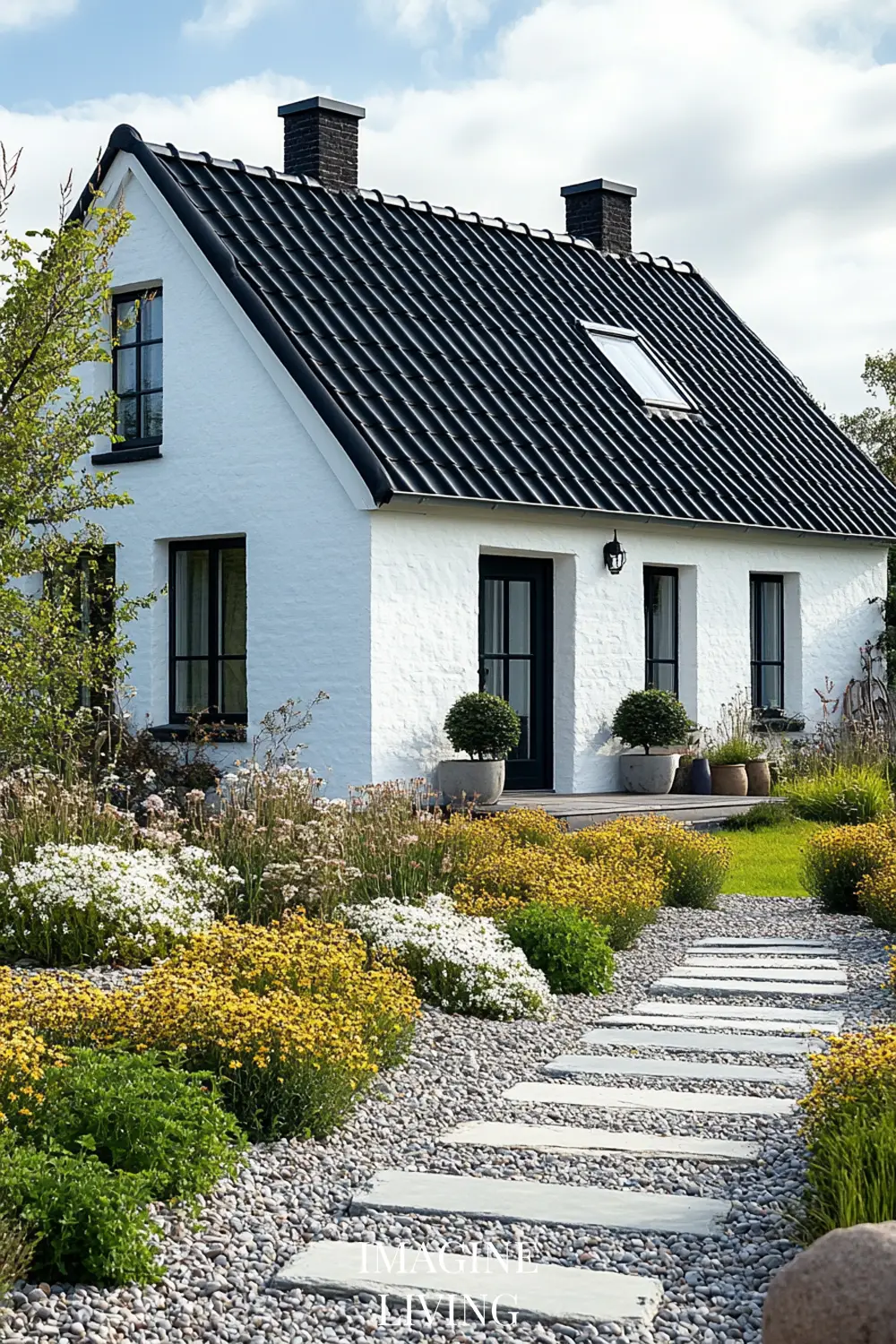
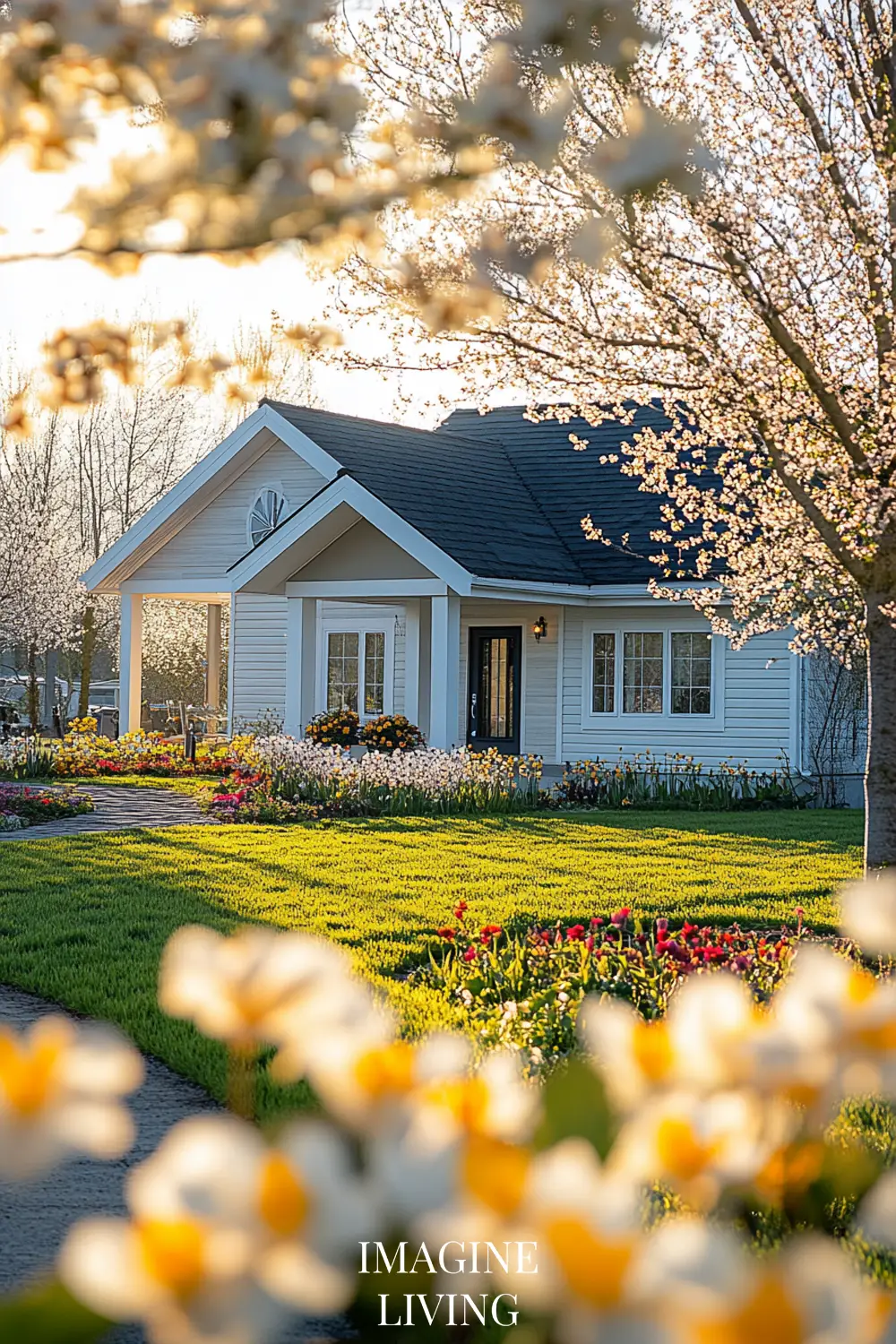
Common Materials for Scandinavian Cottage Exteriors
- Painted Wood Cladding:
- Traditional cottages in Sweden often have white, black, or muted pastel exteriors, while Norwegian homes lean toward deep reds or dark browns.
- Vertical wooden panels create a more modern look, while horizontal boards evoke a classic feel.
- Natural Stone & Brick:
- Many Scandinavian cottages use local stone for their foundations or chimneys, helping the home blend into its environment.
- Exposed brick or stone walls add texture, particularly in mountain or rural settings.
- Black Metal & Glass Accents:
- Windows and doors framed in black metal create a striking contrast against white or muted-colored facades.
- Large glass panes and minimal window trim let in as much natural light as possible, a key aspect of Scandinavian home design.

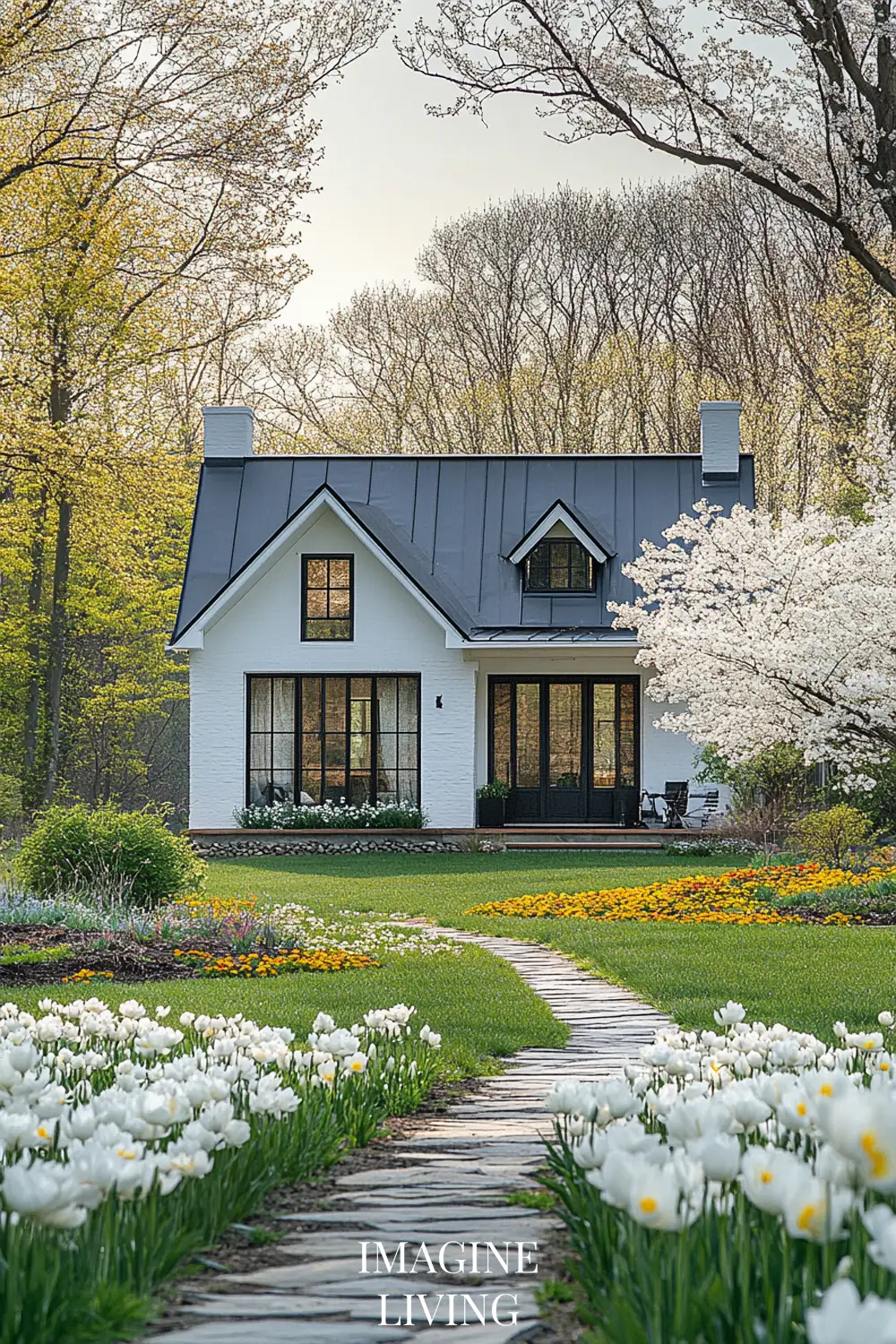
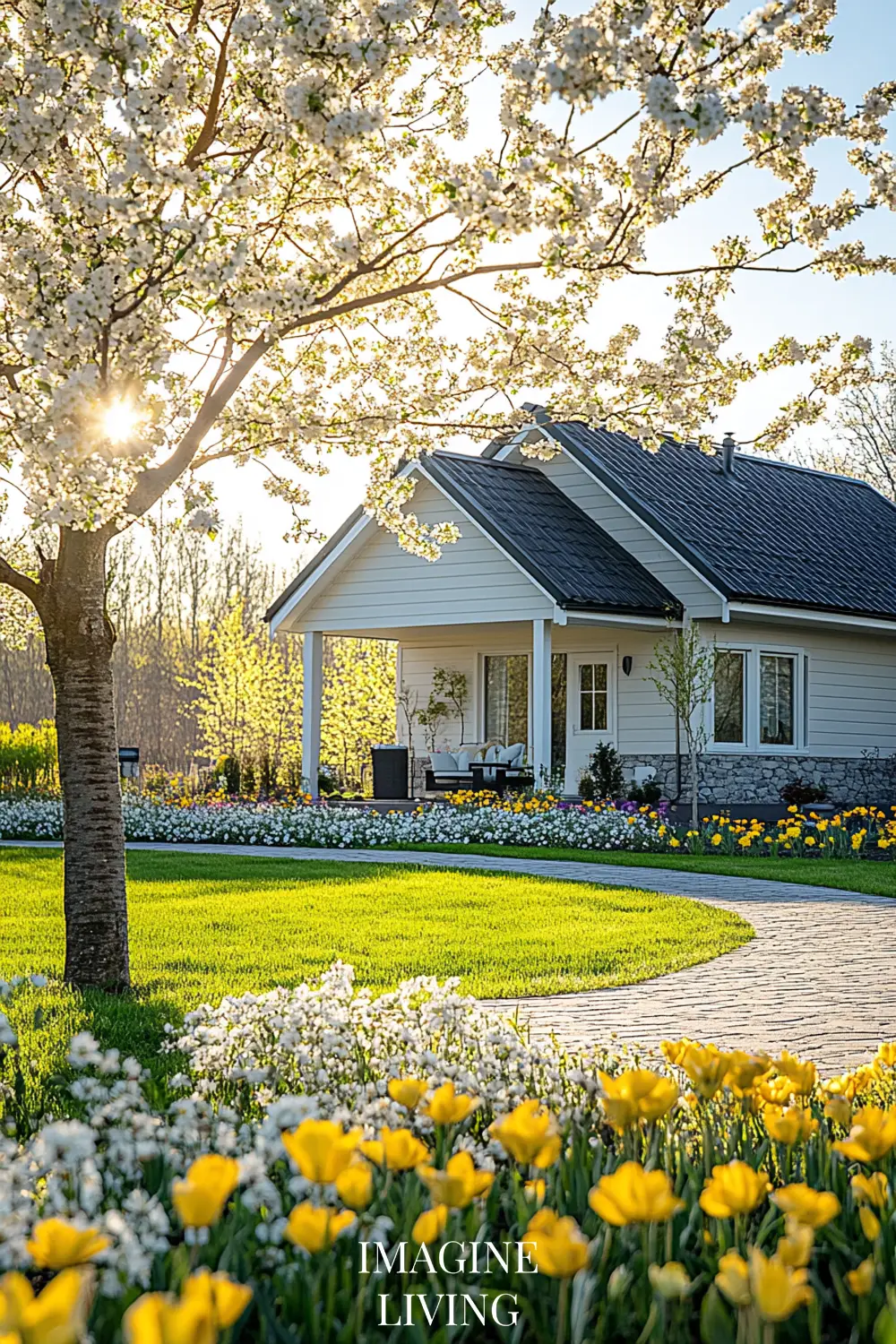
Doors & Windows: Traditional vs. Modern Scandinavian Cottages
- Traditional Scandinavian Cottages
- Symmetrical window placements, often with wooden shutters or small, pane-divided glass.
- Light-colored wooden doors with iron hardware.
- Often feature a small front porch with rustic lanterns and a simple wooden bench.
- Modern Scandinavian Homes
- Asymmetrical window placement, sometimes floor-to-ceiling glass walls.
- Sleek, minimalist doors, often black or natural wood.
- Large sliding doors leading directly to an outdoor terrace or patio, blurring the line between indoor and outdoor living.

Regional Variations in Scandinavian Cottage Design
- Norwegian Mountain Cottages:
- Heavily insulated, often with dark exteriors and grass-covered roofs for natural insulation.
- Stone fireplaces and timber interiors create a warm, rustic contrast to the snowy landscapes.
- Danish Coastal Homes:
- Thatched roofs, white-washed brick, and light-colored wooden exteriors define many seaside cottages.
- Soft, windswept gardens with beach grasses and driftwood elements.
- Swedish Countryside Homes:
- The classic Falu Red cottages with white trim remain a hallmark of rural Sweden.
- Often surrounded by soft meadows, painted picket fences, and layered perennial beds.
💡 Tip: The best Scandinavian cottage designs let the landscape take center stage. The home should feel like an extension of its surroundings, rather than a dominating structure.
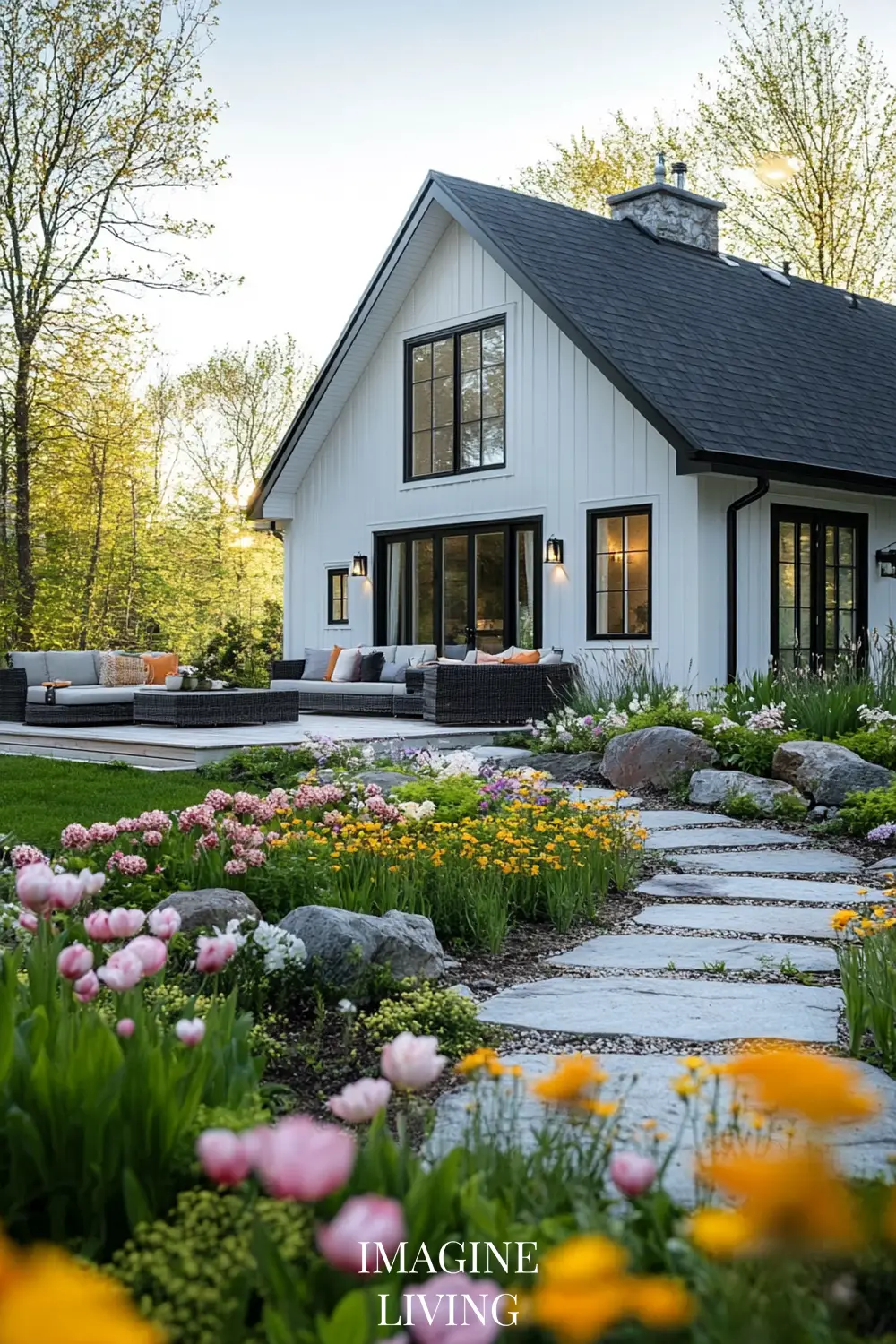
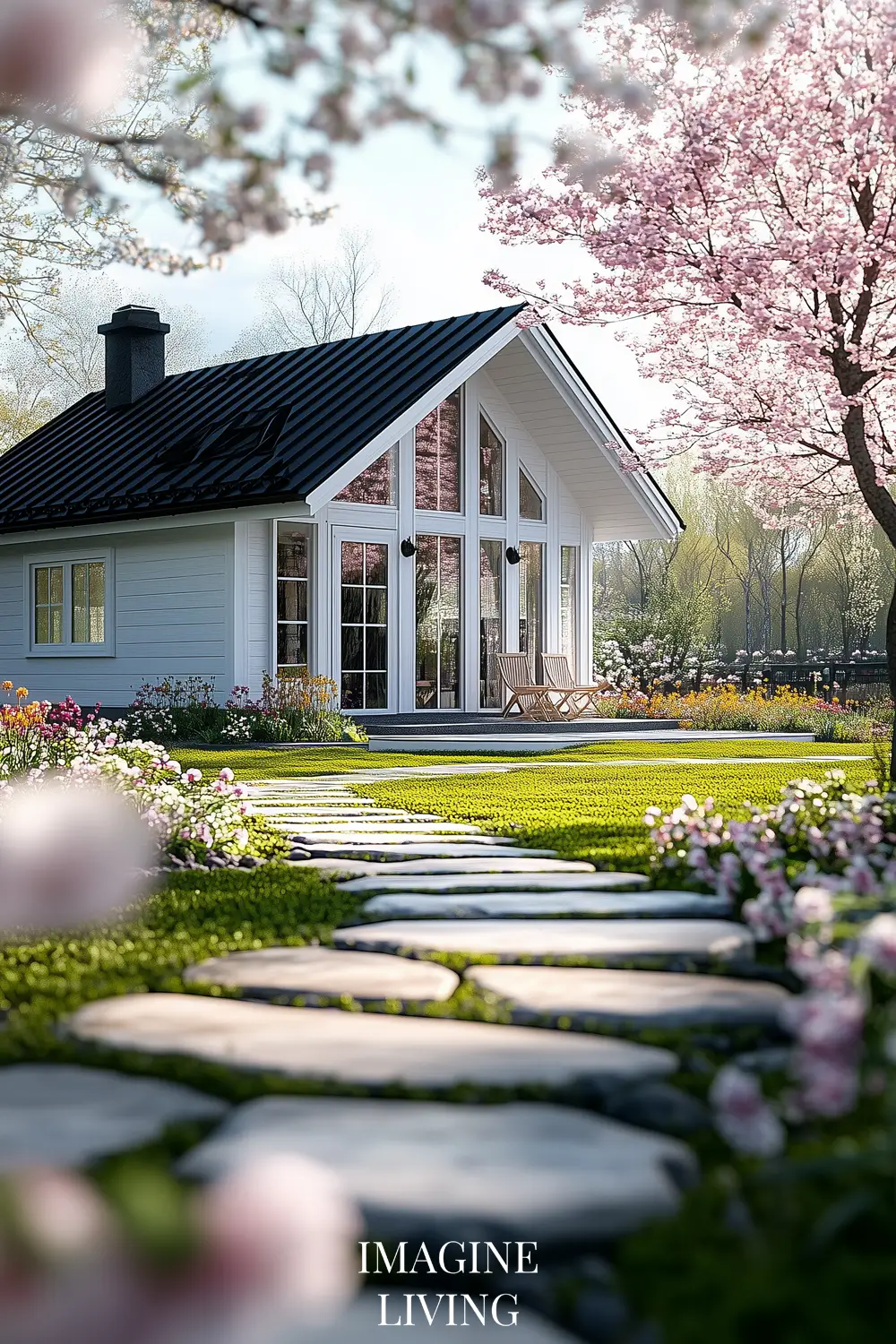
4. Scandinavian Outdoor Styling: Less Is More
Outdoor living spaces in Scandinavian homes are carefully curated to remain functional, inviting, and in harmony with nature.
How to Style a Scandinavian Cottage Exterior:
✔ Simple Wooden or Wicker Seating: Think minimalist wooden benches or woven rattan chairs placed on porches or near garden paths.
✔ Muted Textiles & Linens: A soft wool throw, linen cushions in neutral hues, or striped Scandinavian-inspired fabric for a subtle, cozy touch.
✔ Natural Light & Candle Lanterns: Black iron lanterns or simple hurricane glass candleholders add warmth during cooler spring evenings.
✔ Terracotta or Concrete Planters: Choose streamlined shapes with carefully placed greenery rather than overfilling with flowers.
✔ Fire Pit or Outdoor Wood Stove: Perfect for chilly Nordic nights, a small fire pit creates a cozy gathering space.
💡 Tip: Scandinavian outdoor spaces prioritize function. Keep furniture practical and weather-resistant, and avoid unnecessary clutter to maintain a fresh, clean aesthetic.
Scandinavian outdoor spaces embrace a minimal yet cozy aesthetic, where every element serves a purpose without overwhelming the natural surroundings. It’s all about quality over quantity, with a focus on natural materials, soft color palettes, and functional layouts. Whether you have a small balcony, a countryside terrace, or a lakeside deck, Scandinavian styling principles can transform your space into an effortlessly elegant retreat.
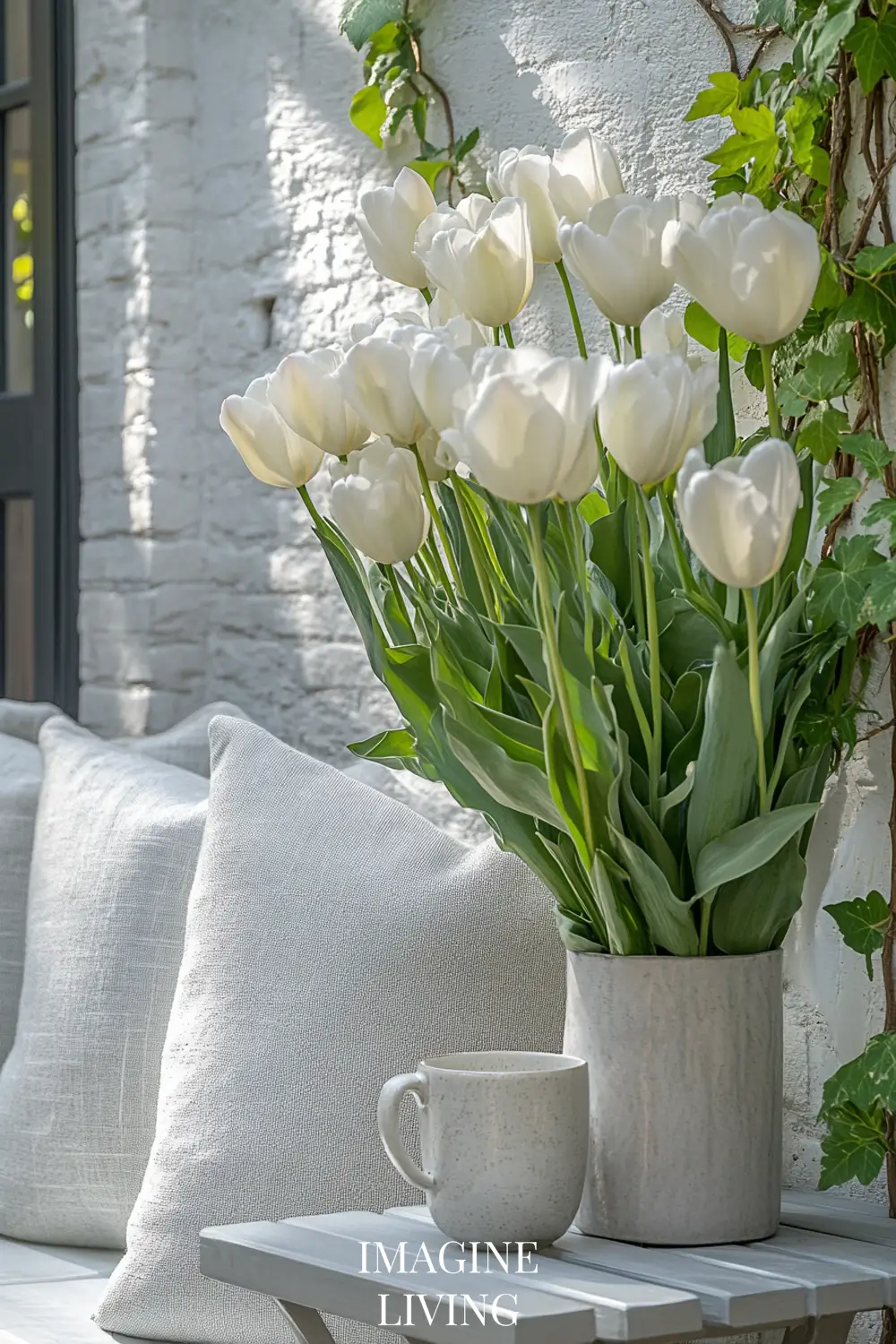
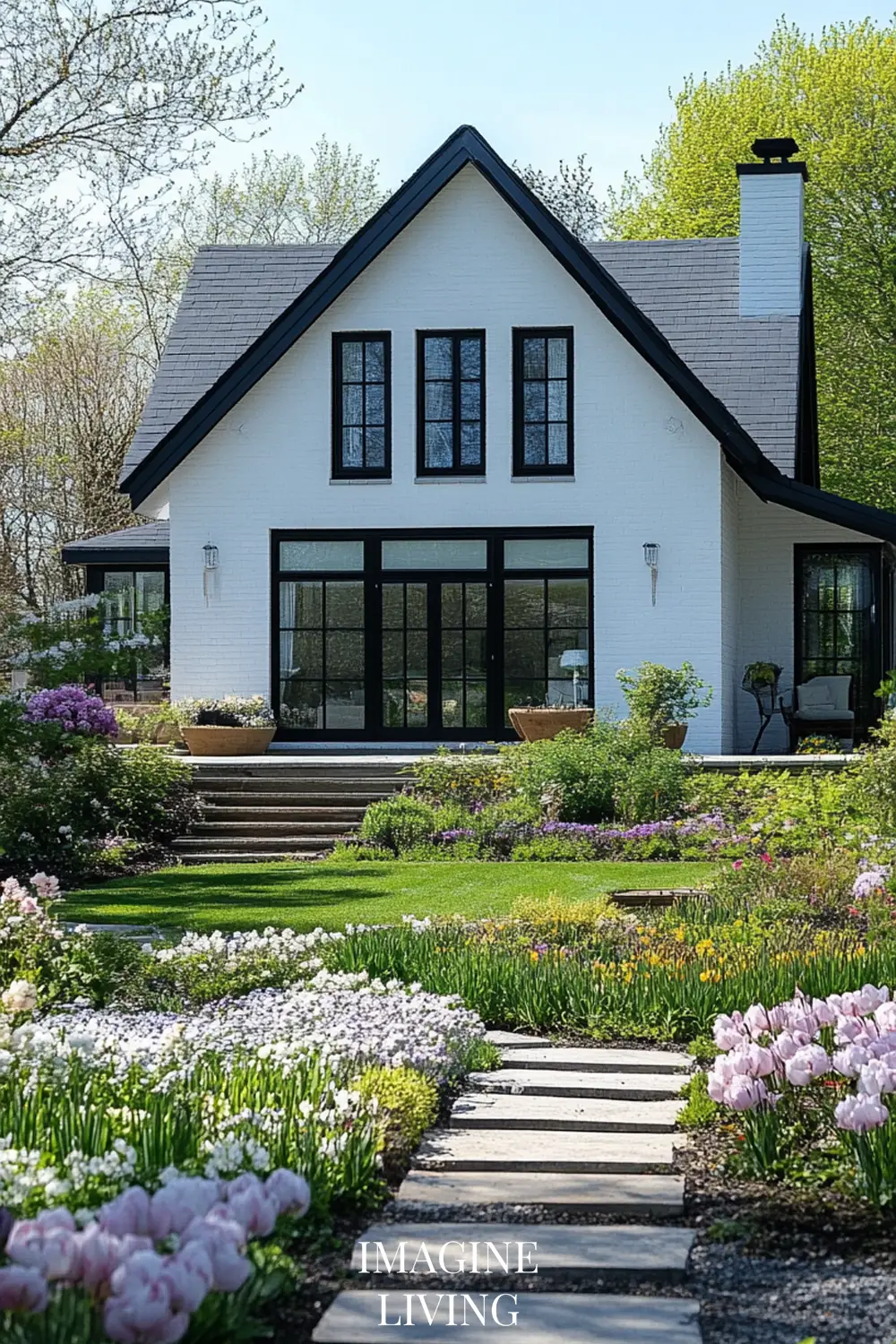
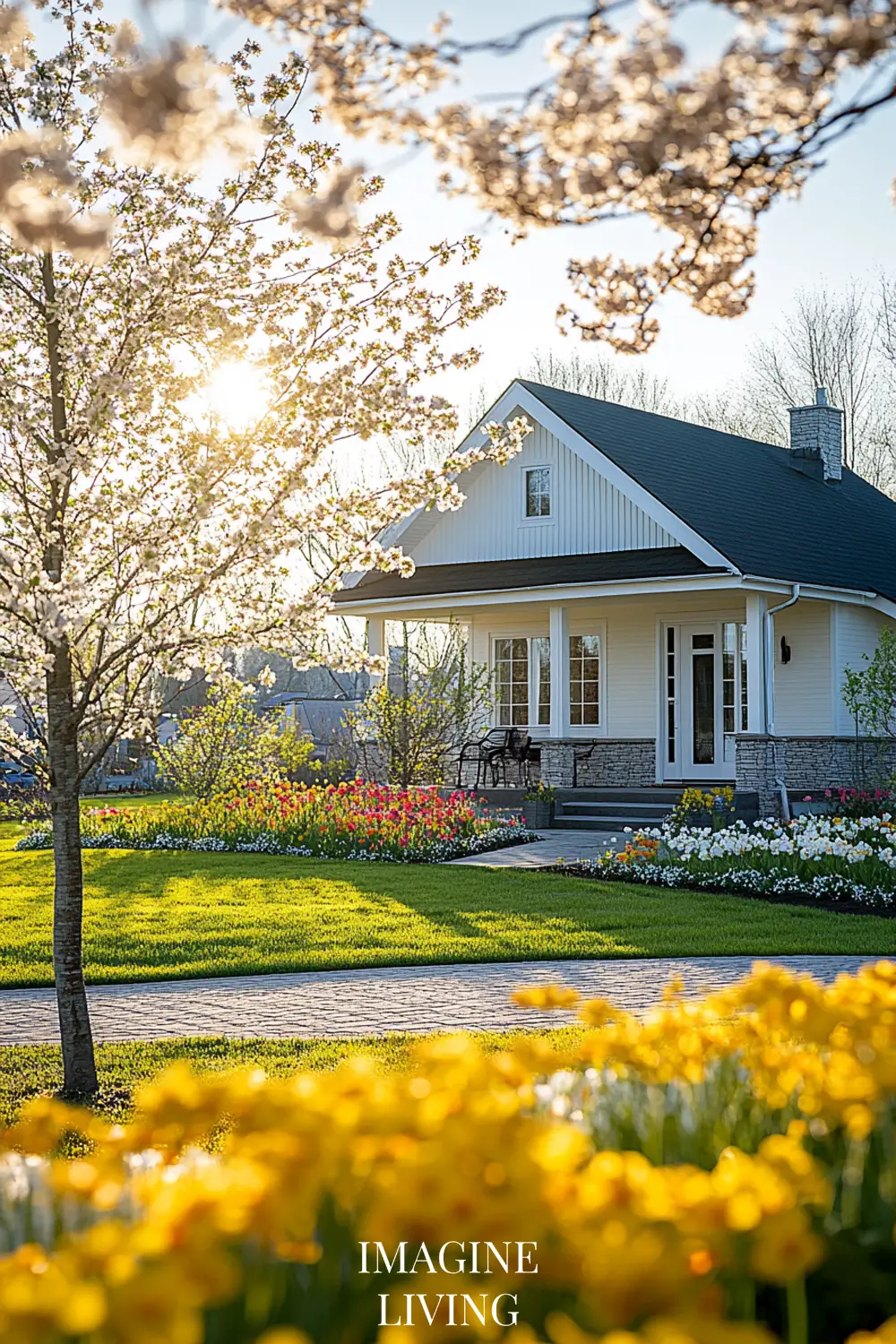
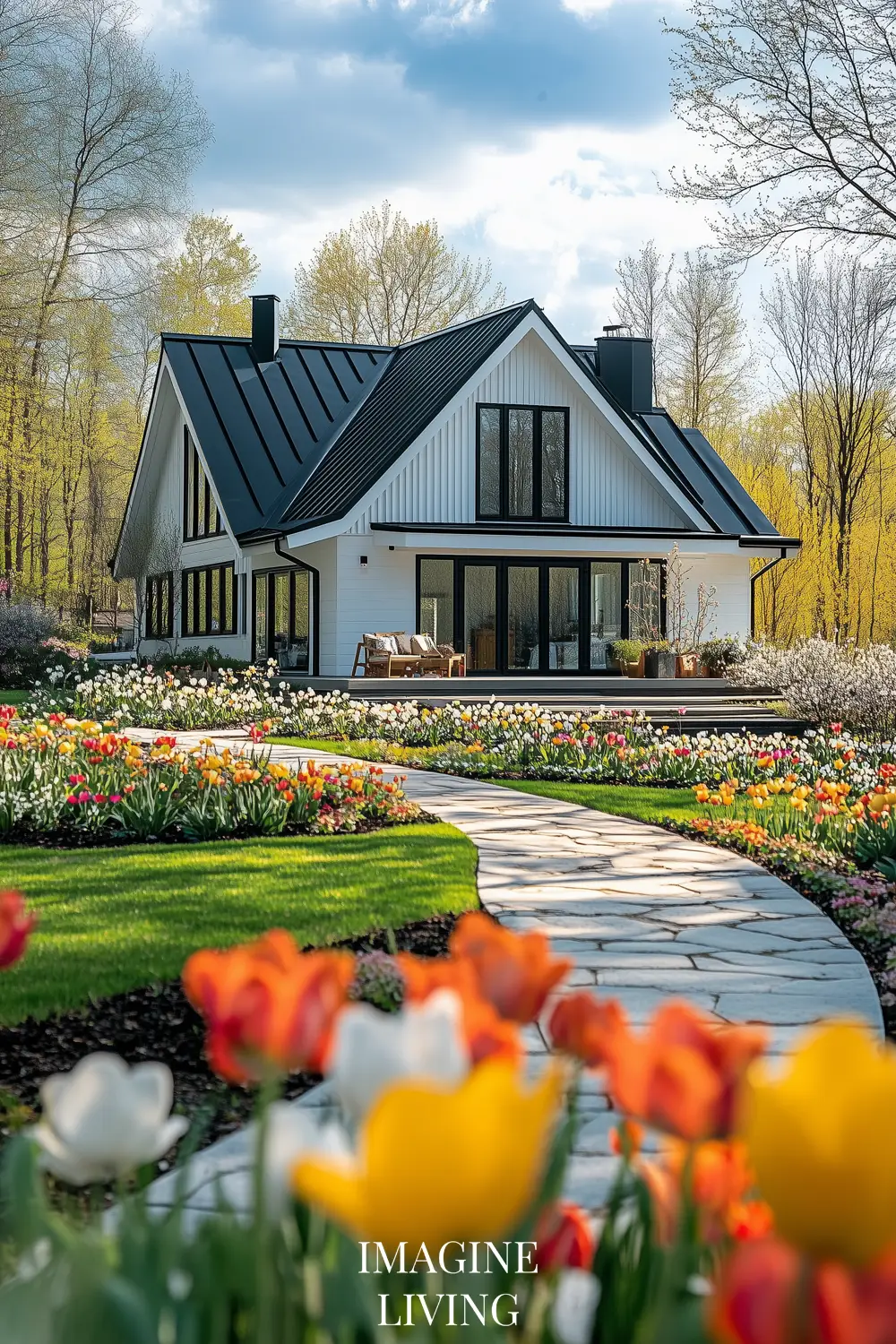
Key Elements of Scandinavian Outdoor Spaces
- Simplicity in Design
- Scandinavian styling avoids clutter. Outdoor furniture and decor are selected with intention, ensuring a clean, airy feel.
- Color palettes are neutral and earthy, with whites, beiges, soft grays, and muted greens blending seamlessly with nature.
- Minimal decor accents: A single ceramic vase with fresh-cut wildflowers, a simple linen throw on a chair, or a woven basket for storage keeps the space functional yet inviting.
- Natural & Sustainable Materials
- Wood: Used in everything from decking to furniture, untreated or lightly stained wood complements the organic surroundings.
- Stone: Scandinavian patios often feature gravel, slate, or concrete slabs for a natural, timeless look.
- Rattan & Wicker: Light and breathable materials that pair well with soft textiles like wool or linen.
- Metals: Black or weathered steel for minimalist lanterns, outdoor lighting, or even a sleek fireplace.
- Functional, Cozy Seating Areas
- Scandinavian outdoor spaces are meant to be lived in, so seating areas are both stylish and practical.
- Lounge areas with deep, cushioned sofas and rattan armchairs invite relaxation.
- Built-in wooden benches with soft seat cushions maximize seating without cluttering the space.
- A simple bistro set works perfectly in smaller spaces like a balcony or compact patio.
- Layered textiles like wool throws and linen cushions add warmth and contrast.
💡 Tip: Instead of overcrowding with mismatched pieces, choose a few high-quality, timeless furniture items and let the surroundings shine.
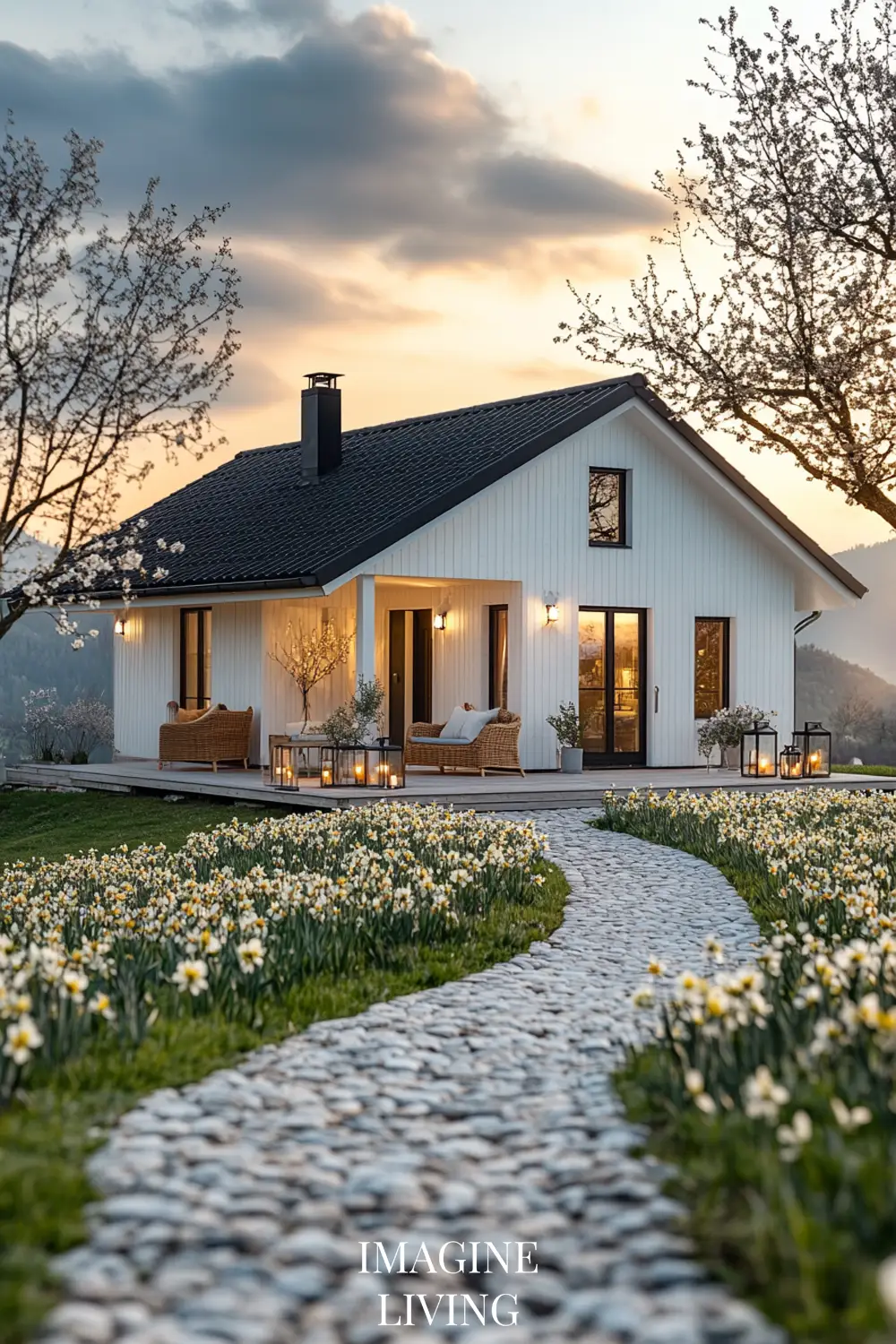
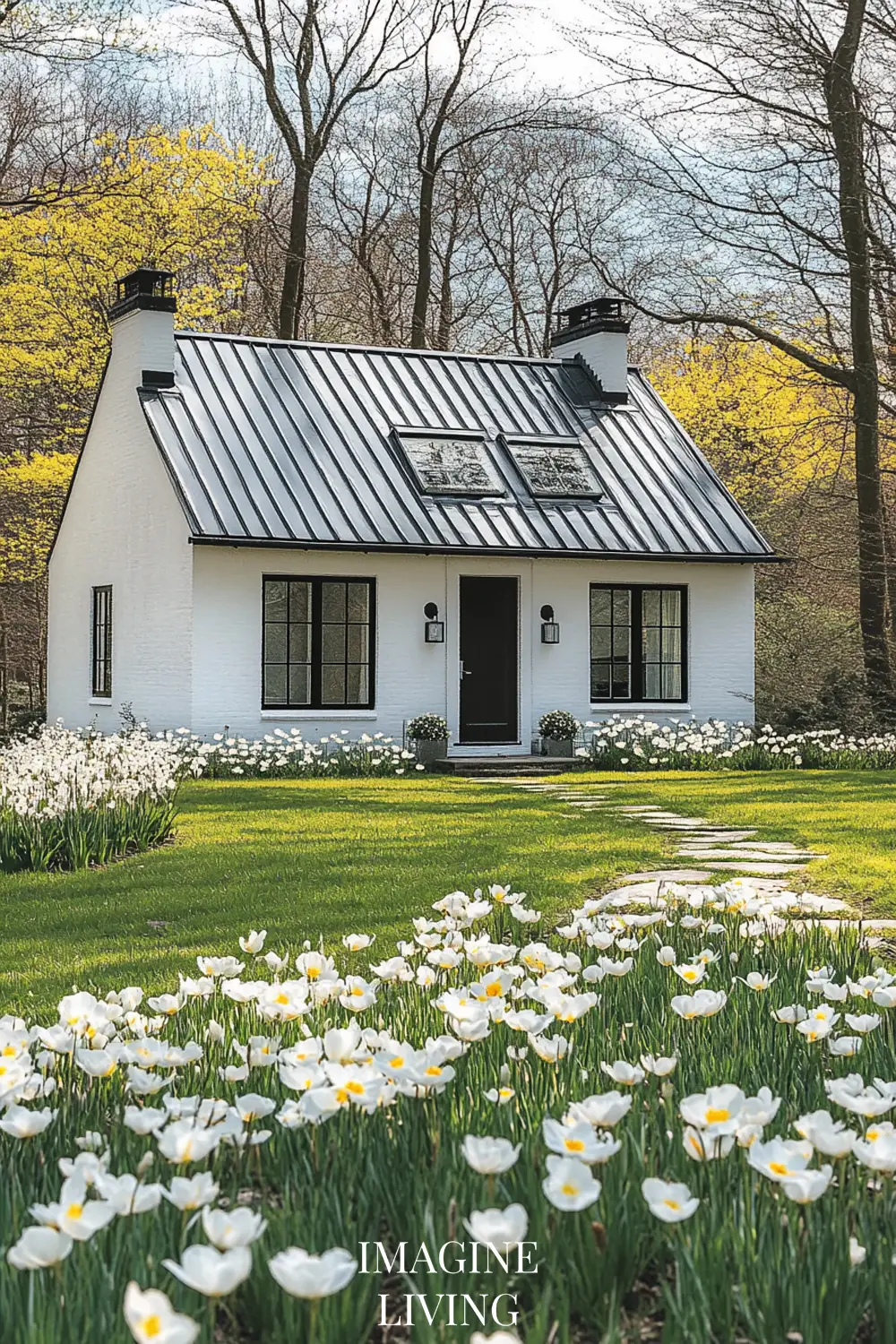
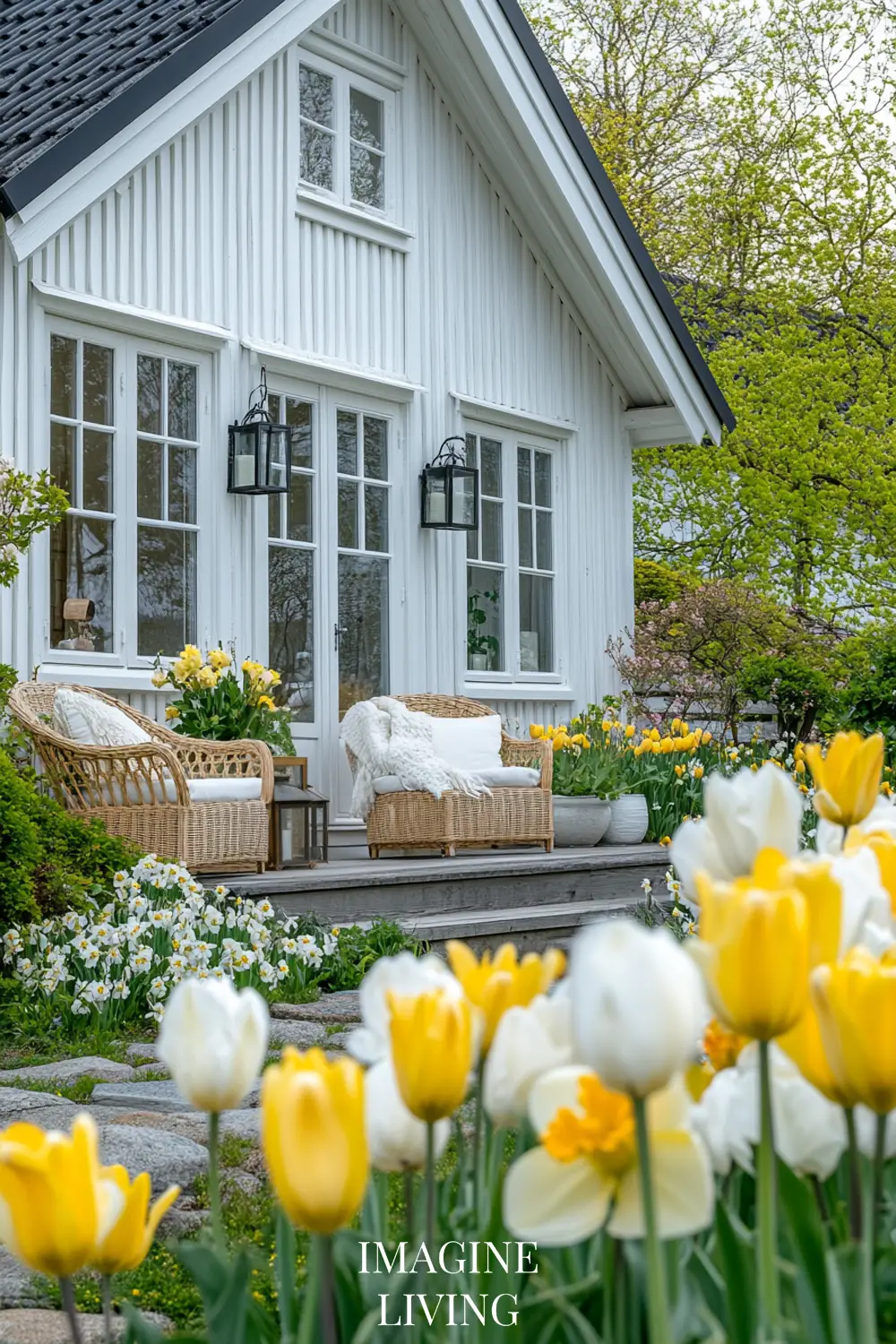

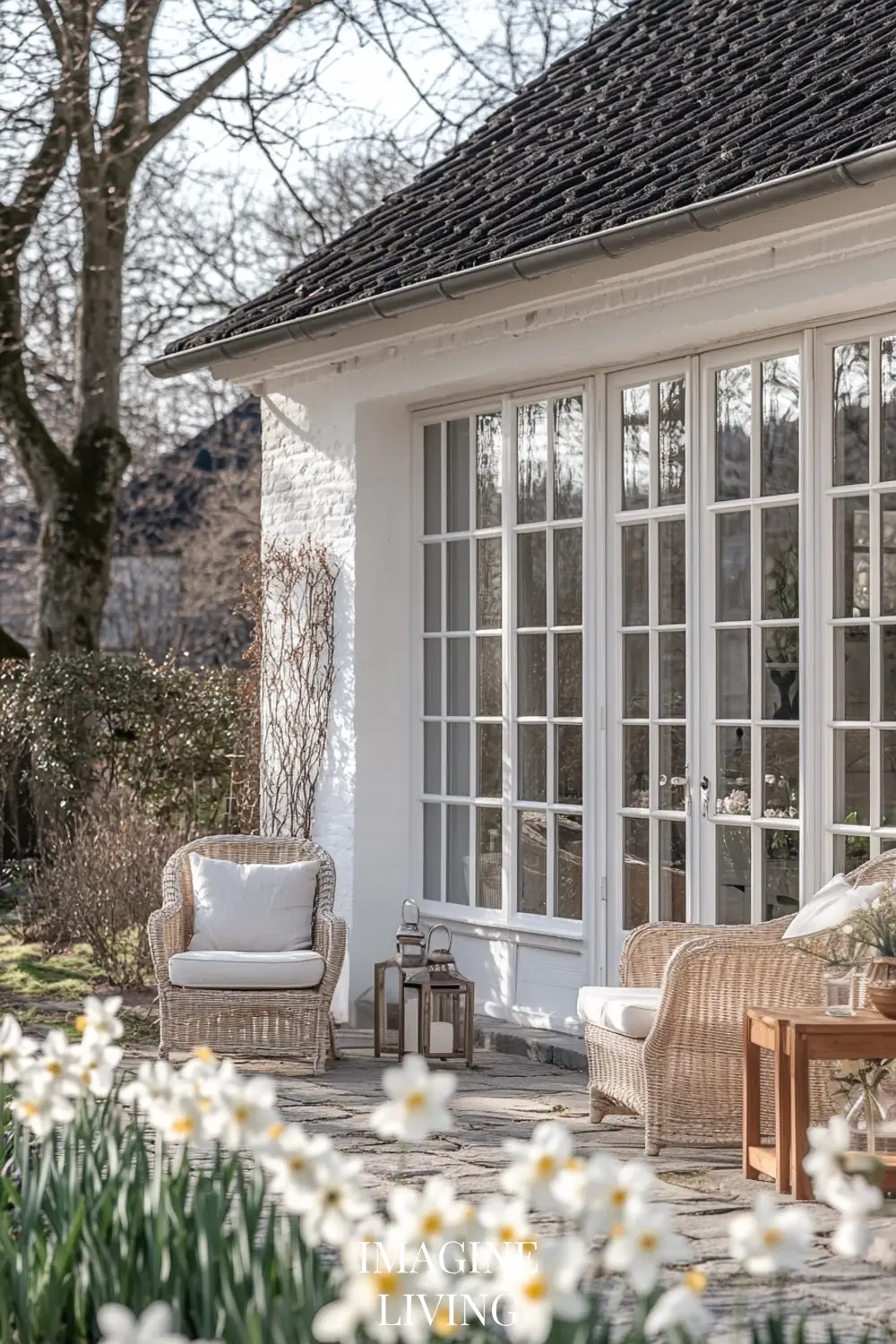
Scandinavian Outdoor Dining: Inviting Yet Minimalist
Outdoor dining in Scandinavia is about embracing the elements, whether it’s a midsummer feast under the midnight sun or a crisp autumn brunch by a crackling fire.
What Defines a Scandinavian Outdoor Dining Space?
✔ A Long, Sturdy Table
- Often made from reclaimed or unfinished wood, blending effortlessly into the landscape.
- If space is limited, opt for a simple foldable wooden table with minimalist chairs.
✔ Neutral Dinnerware with Organic Textures
- Stoneware, ceramic, or handmade pottery plates complement the natural setting.
- Wooden serving boards and linen napkins add softness and warmth.
✔ Unstructured Centerpieces
- Instead of formal floral arrangements, Scandinavians prefer wildflowers in simple glass or ceramic vases.
- Candles and lanterns create a cozy glow, making outdoor dining enjoyable even on cooler evenings.
✔ Connection to Nature
- A Scandinavian dining setup isn’t about perfection—it’s about effortless elegance.
- Tables are often set directly on the lawn, deck, or gravel, without rigid borders.
- Rustic wooden benches or woven chairs complete the look without overwhelming the space.
💡 Tip: Keep the table setting low-maintenance—a few well-placed candles, soft linen runners, and natural textures create a welcoming yet refined ambiance.

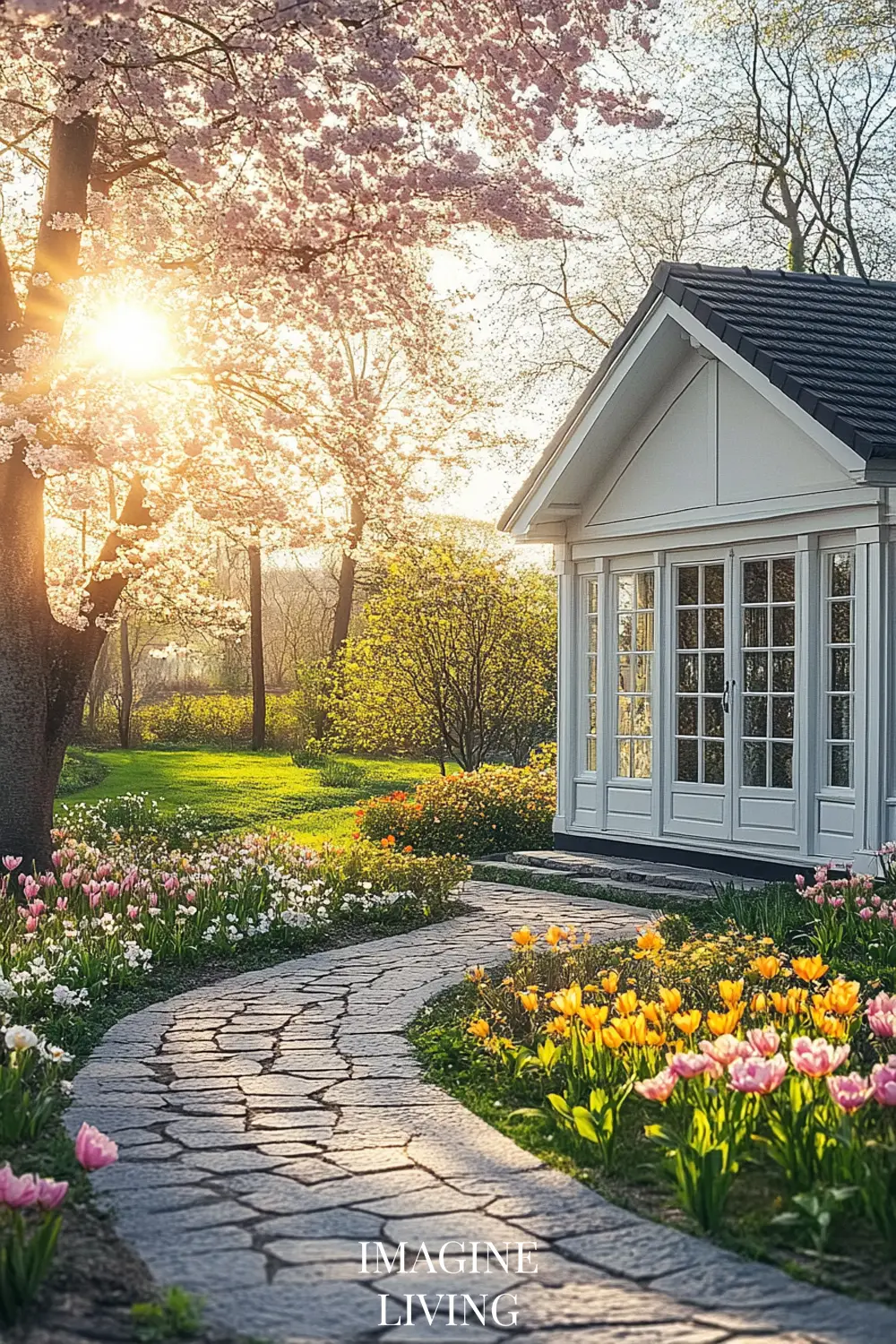

Fire Pits & Heating: Extending Outdoor Living into the Cooler Months
Scandinavians are known for embracing outdoor living year-round, even in colder temperatures. Fire pits, warm textiles, and strategic heating elements help create a cozy retreat for crisp evenings.

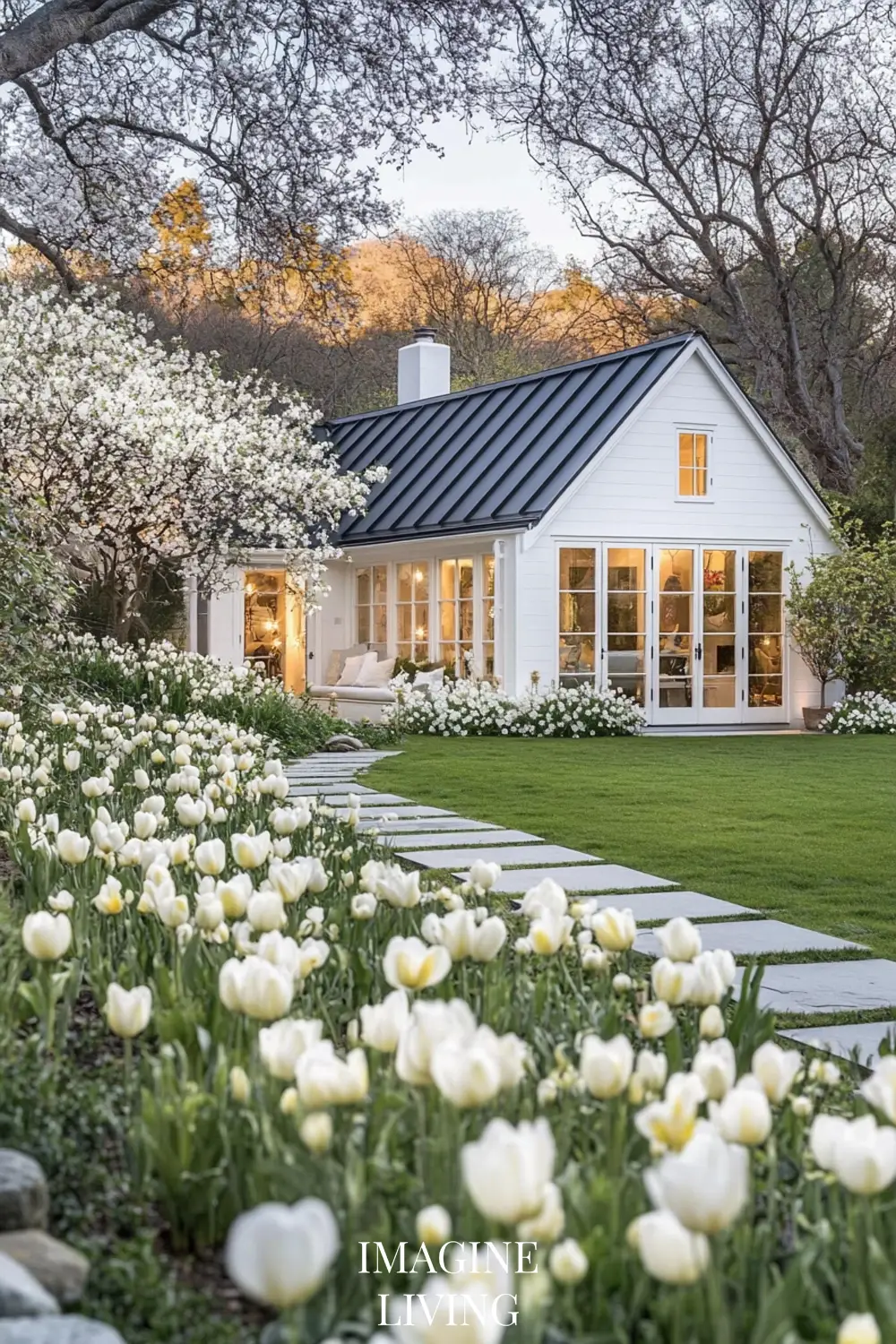
Best Ways to Add Warmth to a Scandinavian Outdoor Space
✔ A Central Fire Pit
- A black steel or stone fire bowl is a common Scandinavian feature, adding both function and minimalist beauty.
- Can be positioned on gravel, stone slabs, or a deck, surrounded by wooden stools or built-in seating.
- Wood-burning options offer a more rustic, natural ambiance, while bioethanol fire pits provide a sleek, smoke-free alternative.
✔ Outdoor Heaters
- A sleek wall-mounted infrared heater works well for small balconies or patios.
- Freestanding heat lamps blend well with modern Scandinavian designs and provide adjustable warmth.
✔ Layered Textiles & Throws
- Thick wool or faux fur blankets draped over benches or lounge chairs invite lingering outdoors.
- Outdoor rugs made from natural fibers like jute or wool create a warm, enclosed feel.
💡 Tip: Place lanterns, fairy lights, or candles around your fire pit or seating area for a softer, inviting glow as the sun sets.
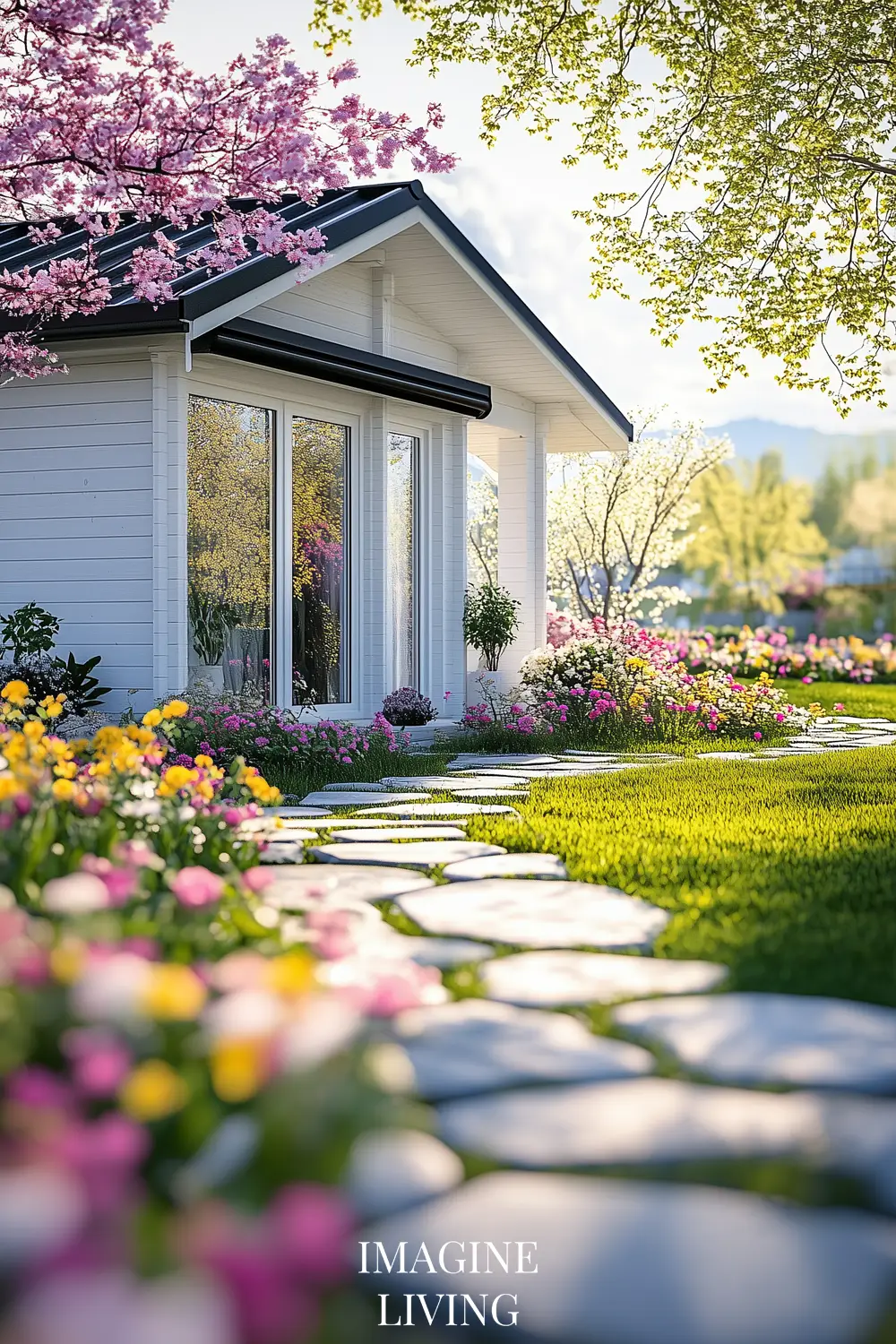
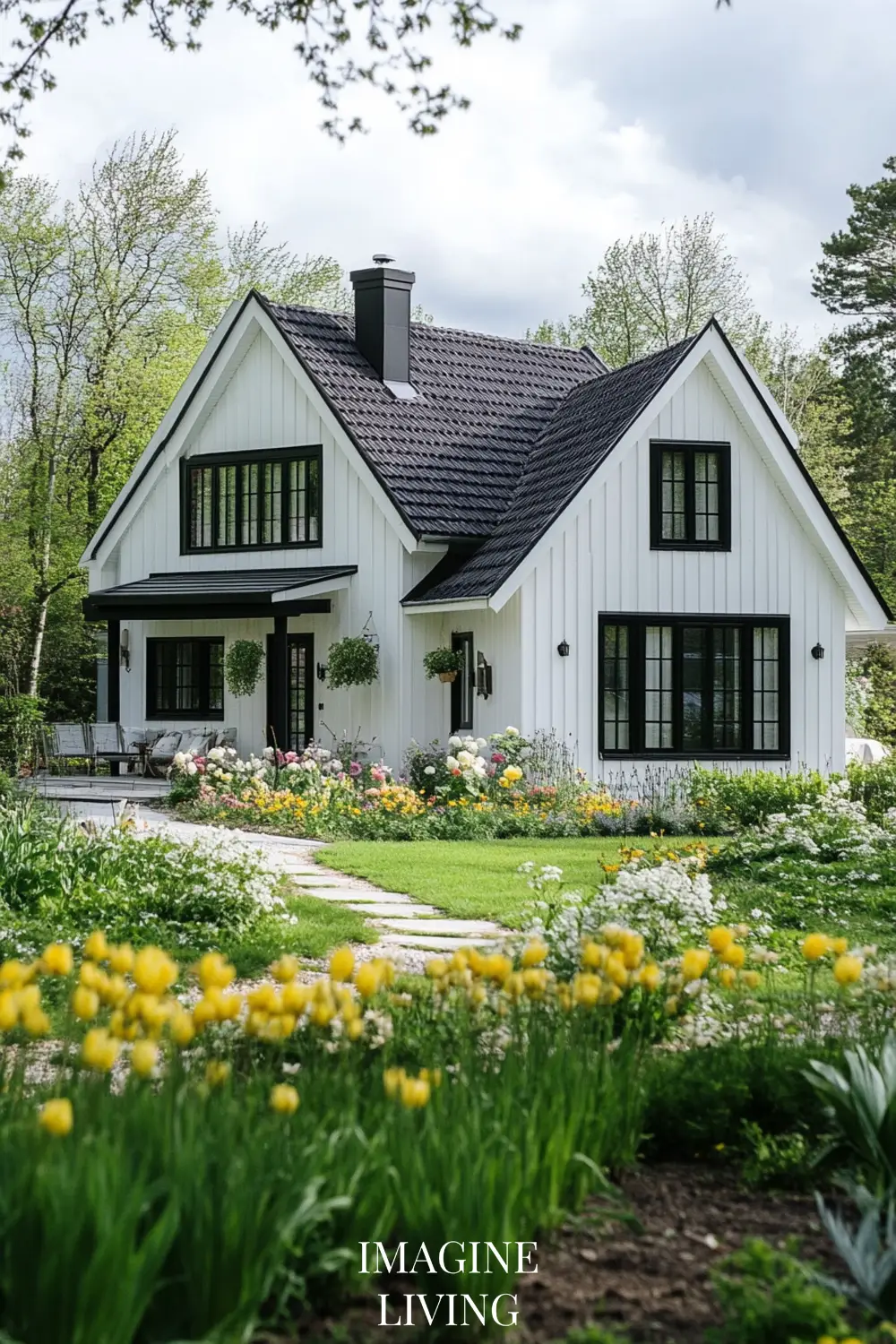

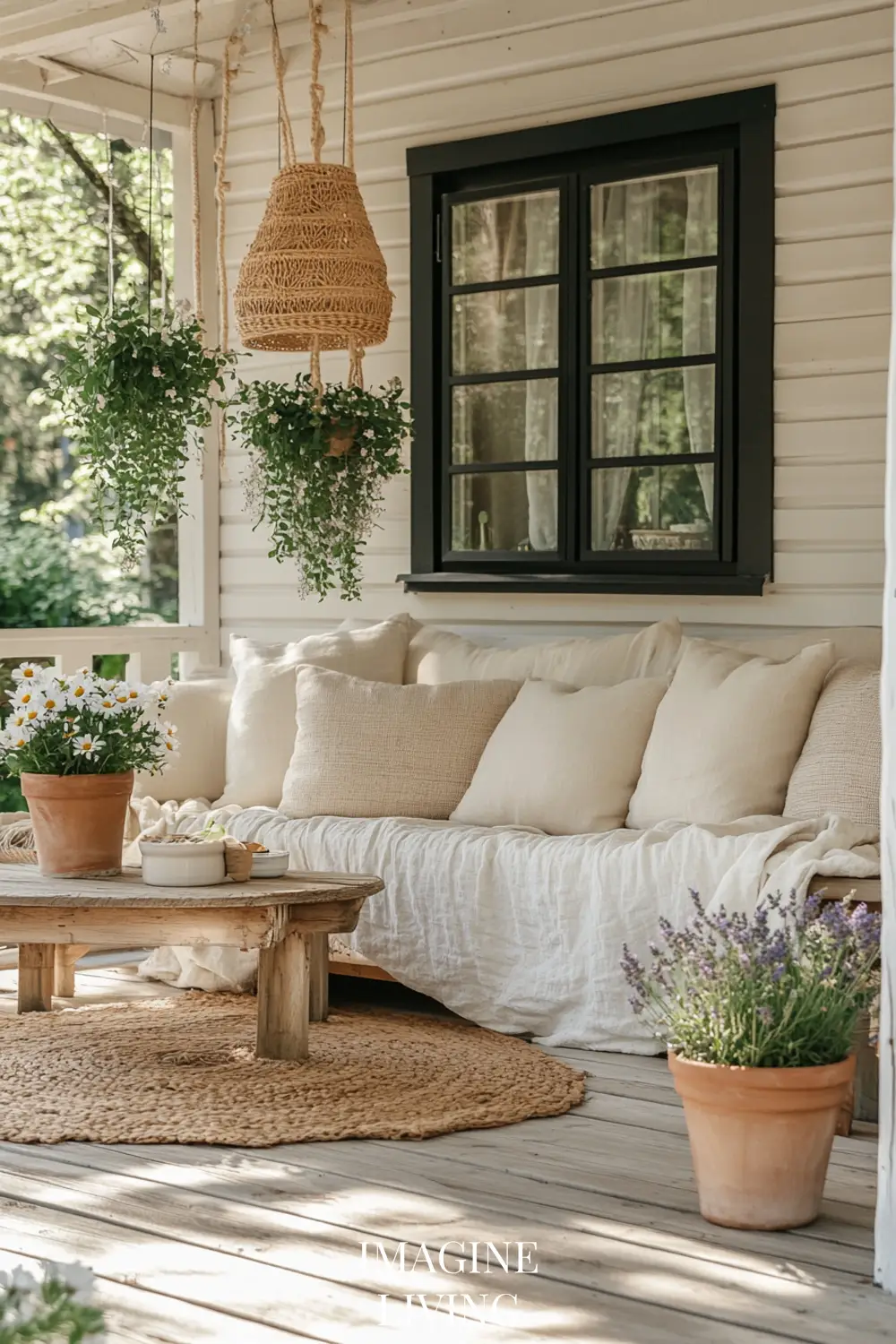
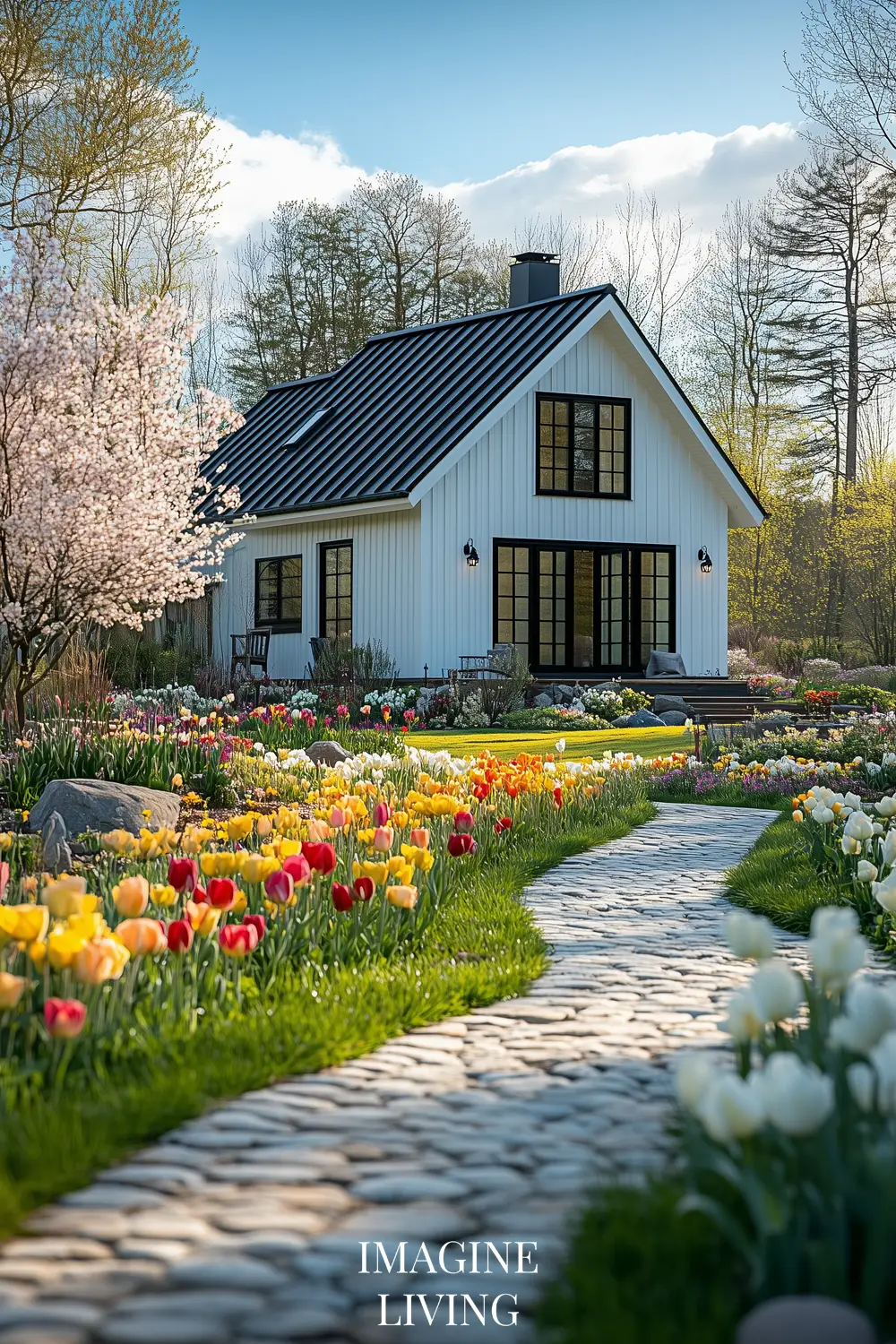
Eco-Conscious Choices in Scandinavian Outdoor Styling
Scandinavian design has sustainability at its core, favoring durable materials, minimal waste, and eco-friendly solutions that enhance rather than disrupt the environment.
✔ Sustainable Furniture Choices
- Opt for FSC-certified wood or reclaimed timber for outdoor furniture.
- Wicker and rattan pieces should be ethically sourced and treated with natural oils instead of harsh chemicals.
✔ Energy-Efficient Outdoor Lighting
- Solar-powered lanterns and LED string lights are widely used in Scandinavian outdoor spaces to reduce energy consumption.
- Motion-sensor path lighting ensures functionality without excess electricity use.
✔ Eco-Friendly Planting Strategies
- Using native plants reduces water consumption and ensures better adaptation to the climate.
- Permaculture principles guide Scandinavian gardens to be both functional and regenerative.
💡 Tip: Invest in timeless, high-quality pieces rather than trend-based decor—this reduces waste and ensures your outdoor space remains stylish for years to come.
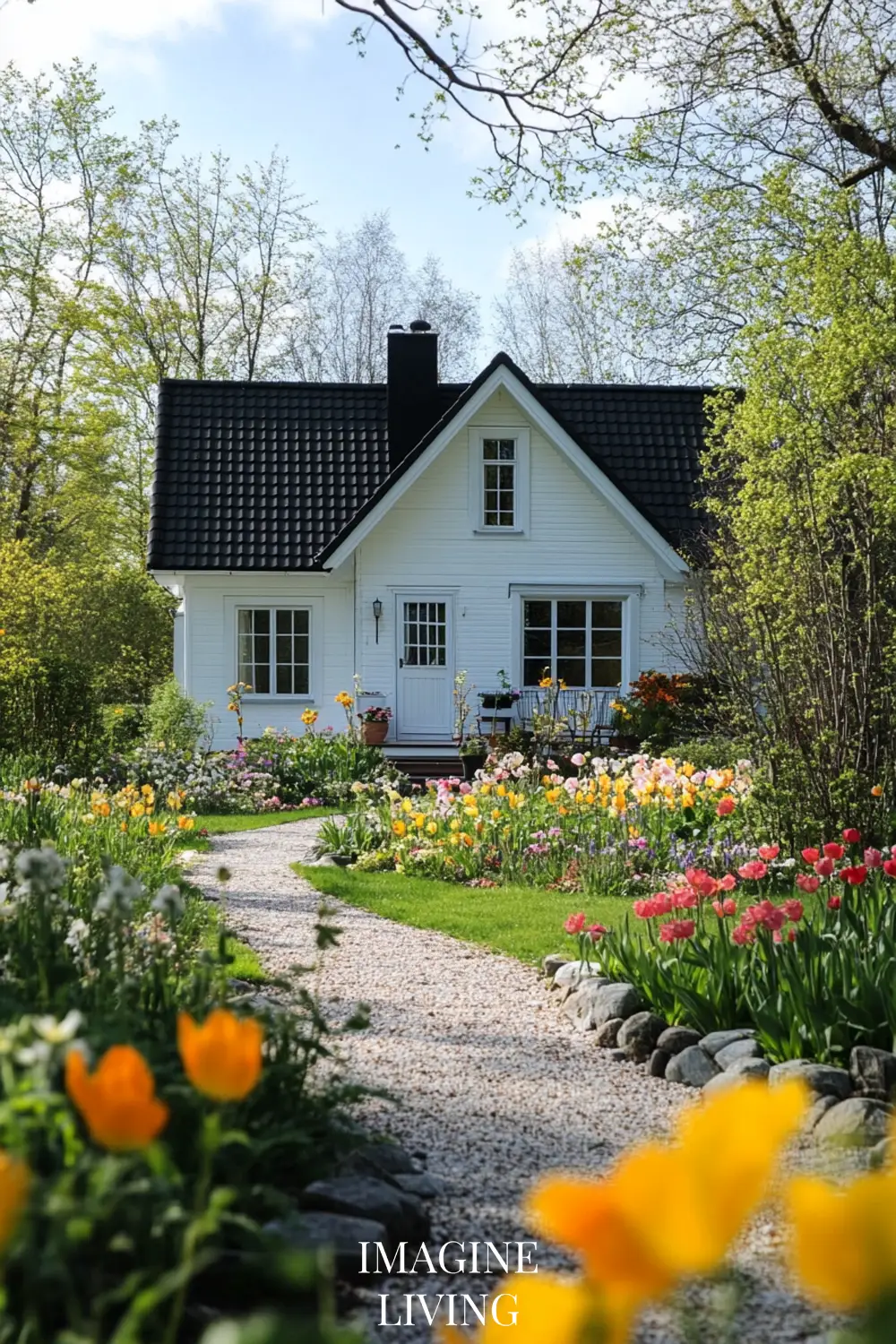

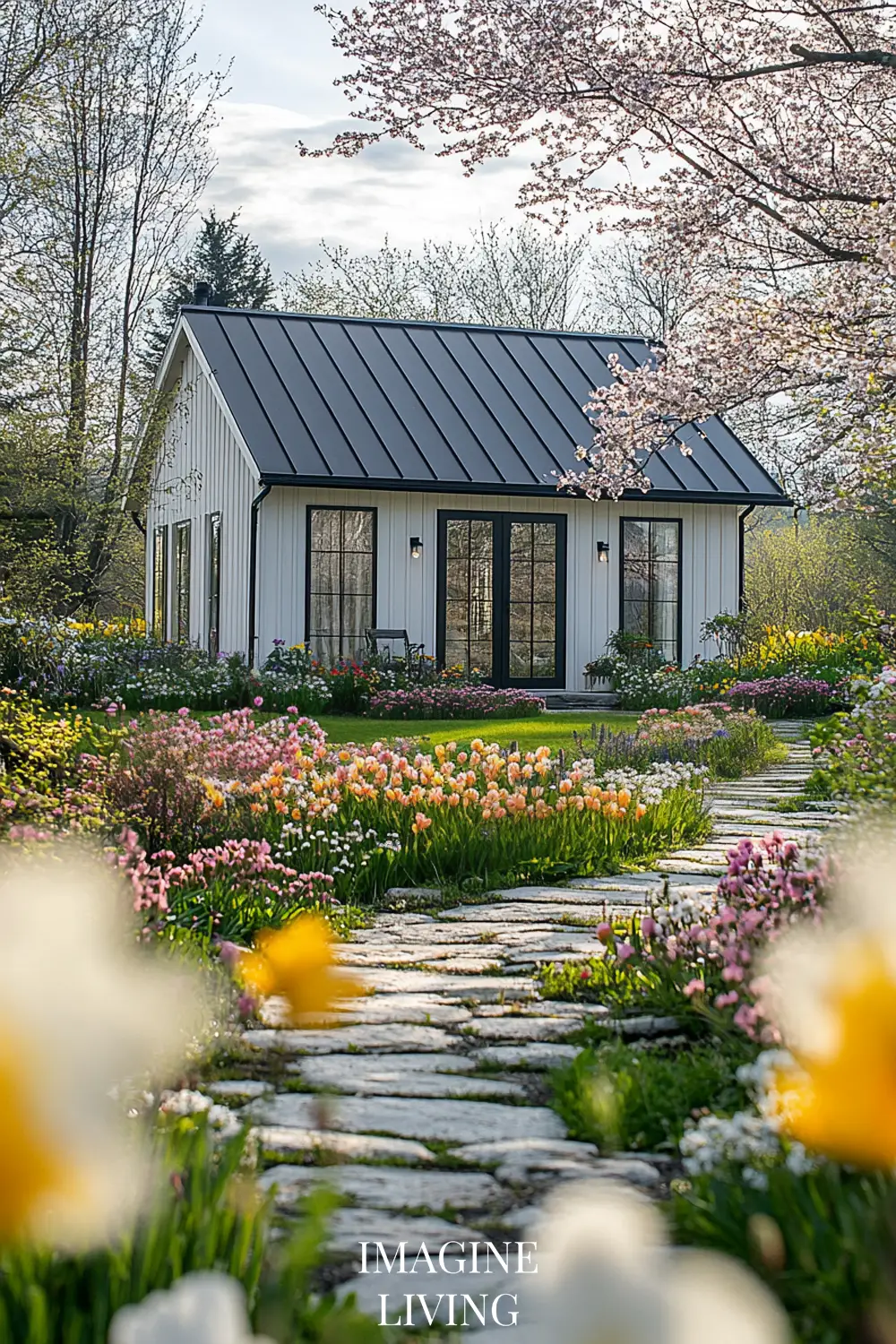
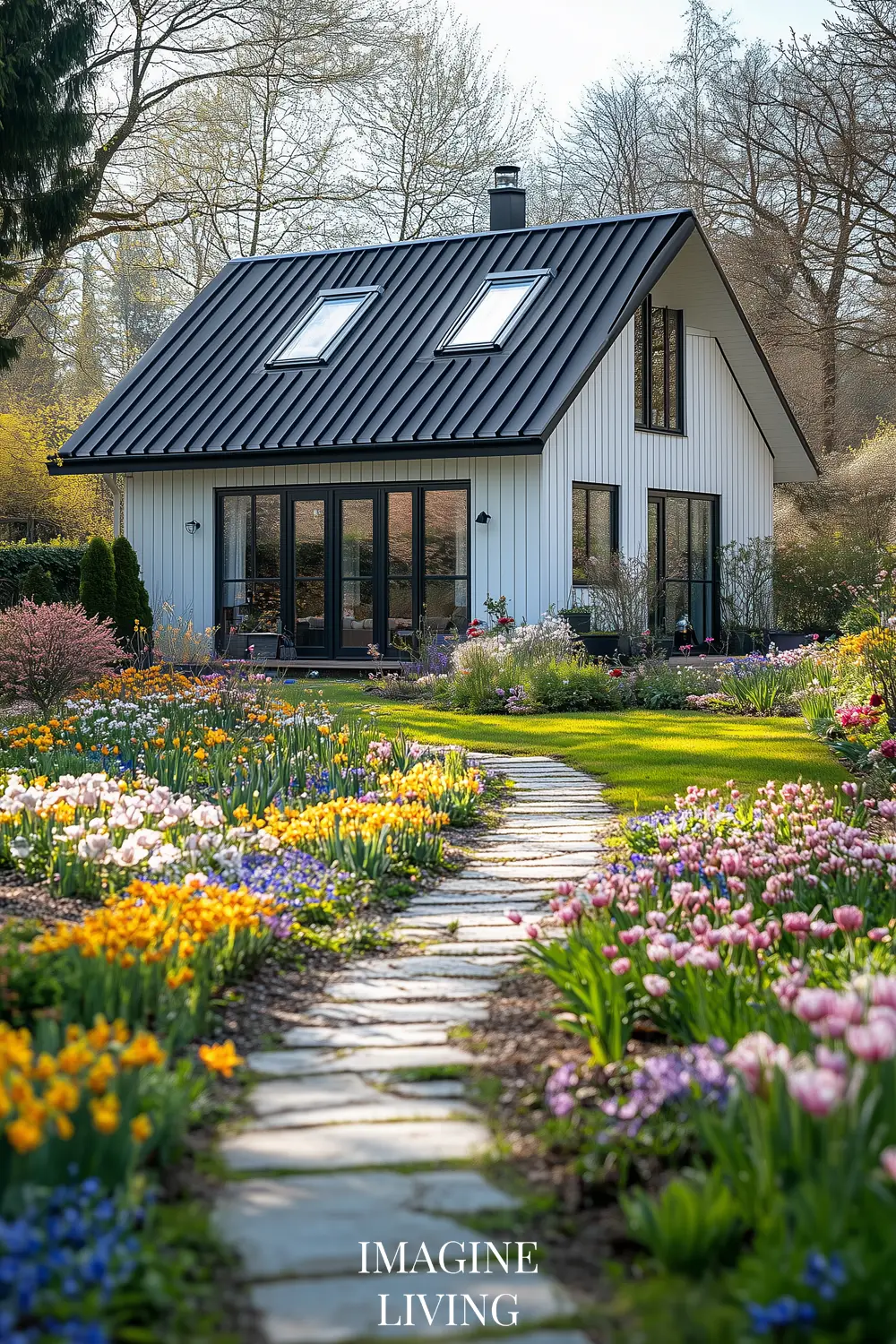
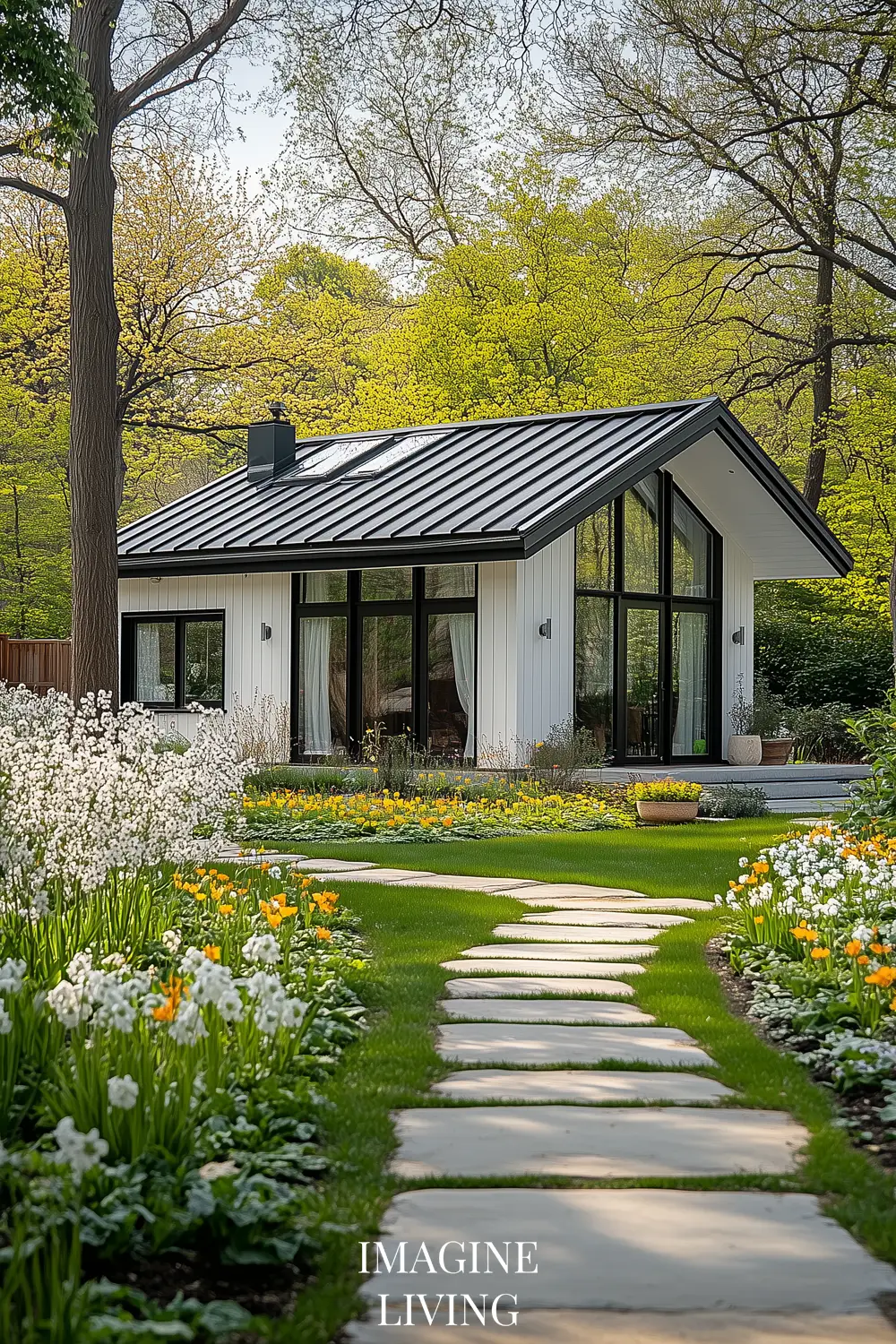
5. Color Palette & Finishing Touches
Unlike the bright florals of traditional cottage gardens, Scandinavian-inspired spaces lean into earthy, understated hues with subtle contrast.
Recommended Color Pairings:
✔ Classic Black & White: A signature look, pairing whitewashed facades with black-trimmed windows and doors.
✔ Soft Greys & Muted Blues: These colors work beautifully in both the exterior and decor elements like planters and seating.
✔ Warm Woods & Stone Tones: Introduce natural materials to balance out the modern elements.
✔ Dusty Pastels for Accents: Soft blush, sage green, or pale yellow for a hint of warmth in planters or fabrics.
💡 Tip: Keep colors understated and natural. Even seasonal flowers should feel muted and harmonious with the overall setting.

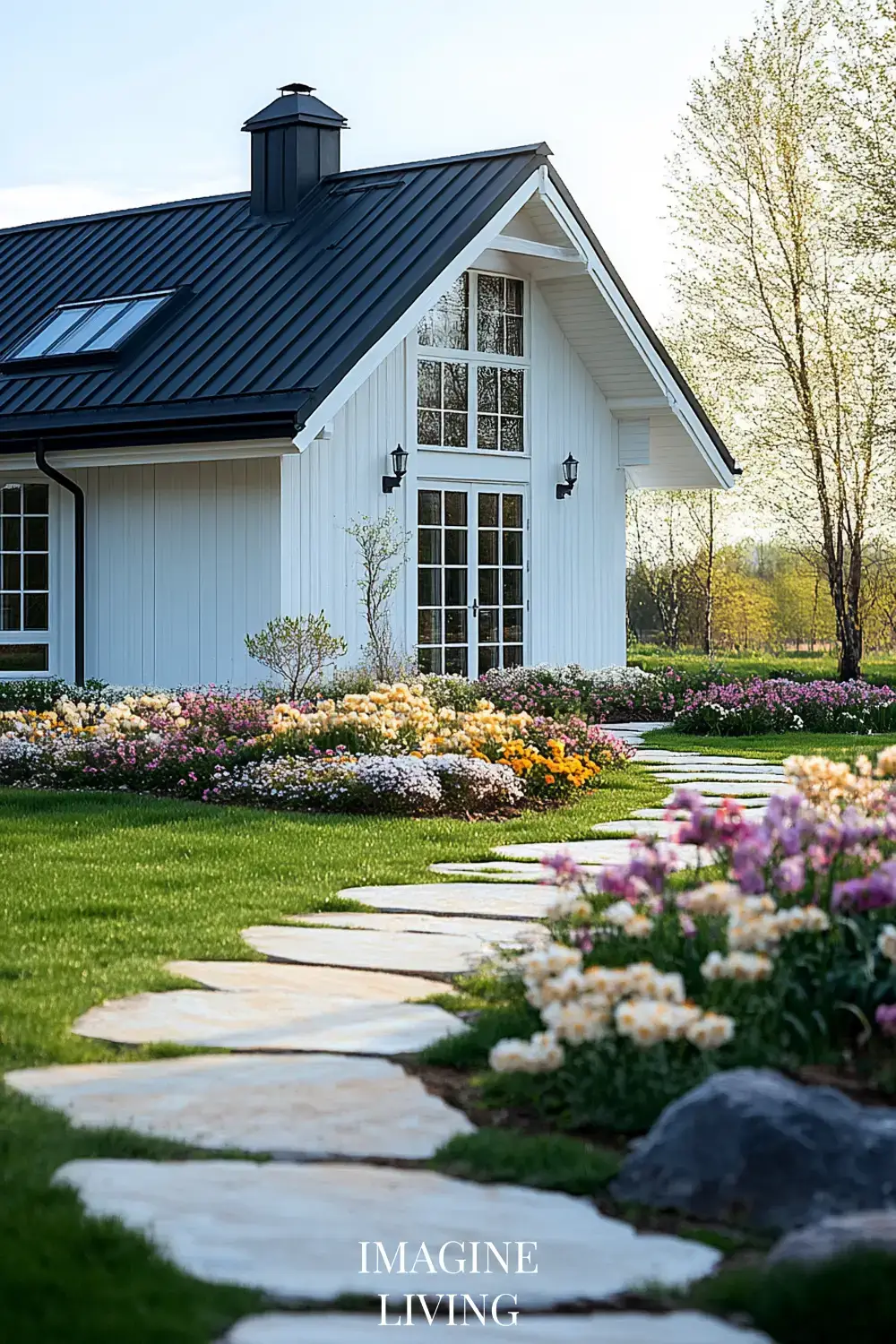
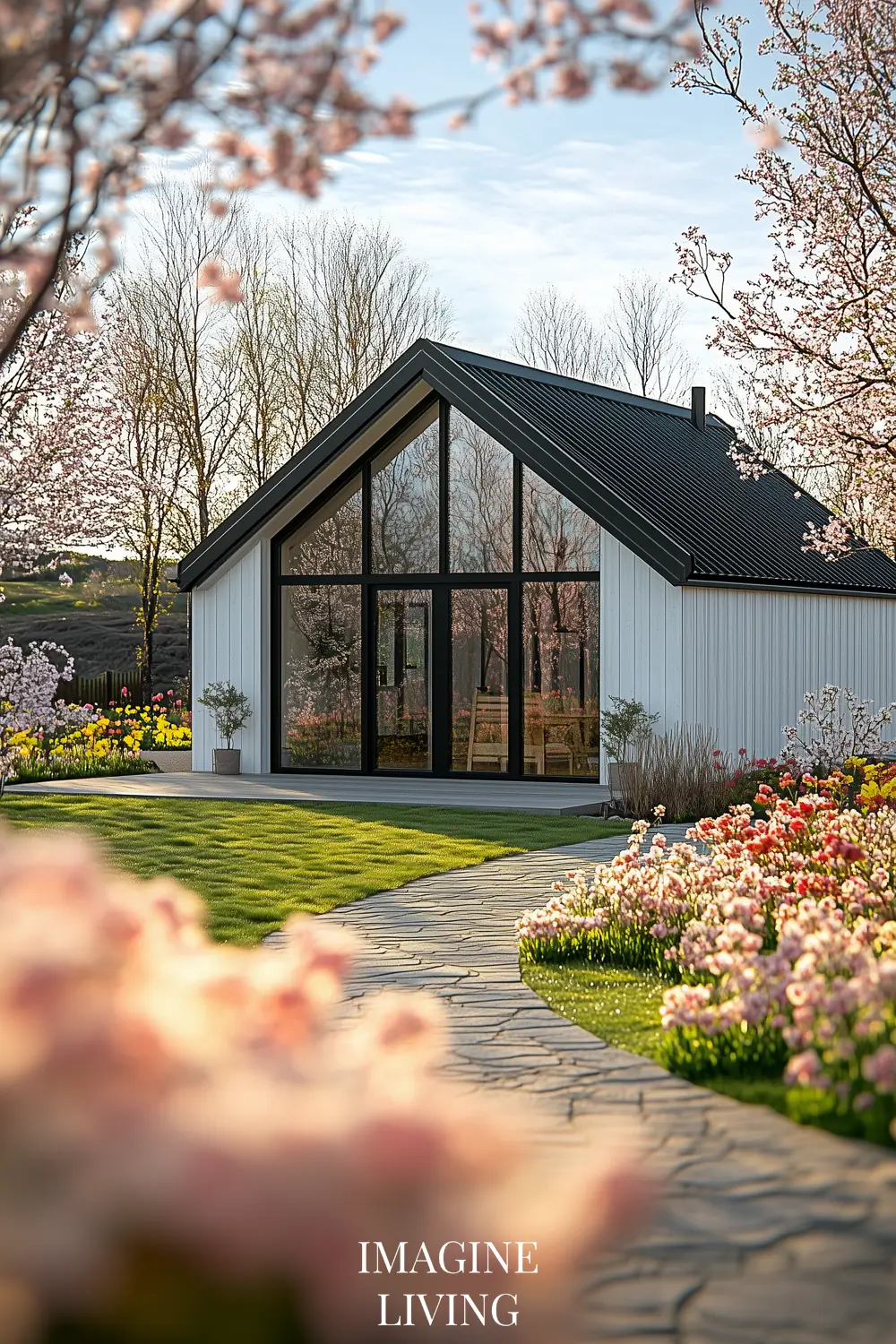
Common Mistakes to Avoid in Scandinavian Gardens
Even though the Scandinavian style thrives on simplicity, certain mistakes can disrupt the overall balance. Here’s what to avoid—and how to fix it.
1. Over-Complicating the Layout
- Mistake: Trying to force too many elements (furniture, decor, plants) into one space.
- Fix: Step back and assess what’s truly necessary. Scandinavian gardens focus on flow—leave open space for movement and let the landscape breathe.
2. Choosing the Wrong Plants for the Climate
- Mistake: Using delicate, high-maintenance plants that don’t withstand cold Scandinavian nights.
- Fix: Stick to hardy perennials like lavender, sedum, and juniper that thrive in cool temperatures and require minimal upkeep.
3. Over-Trimming & Over-Structuring
- Mistake: Pruning plants too neatly, losing the effortless, natural feel.
- Fix: Allow some areas to grow wild and free, using gentle shaping rather than rigid hedging.
4. Selecting Non-Weather-Resistant Furniture
- Mistake: Choosing materials that degrade quickly in wet or snowy conditions.
- Fix: Use powder-coated steel, treated wood, or high-quality rattan to ensure durability through seasons.
5. Ignoring Seasonal Transitions
- Mistake: Designing a garden that only looks good in summer.
- Fix: Incorporate evergreens, ornamental grasses, and structural plants to maintain visual interest in colder months.
💡 Quick Fix: If your garden feels too rigid or cold, soften it with warm textiles, unstructured plantings, and organic decor.
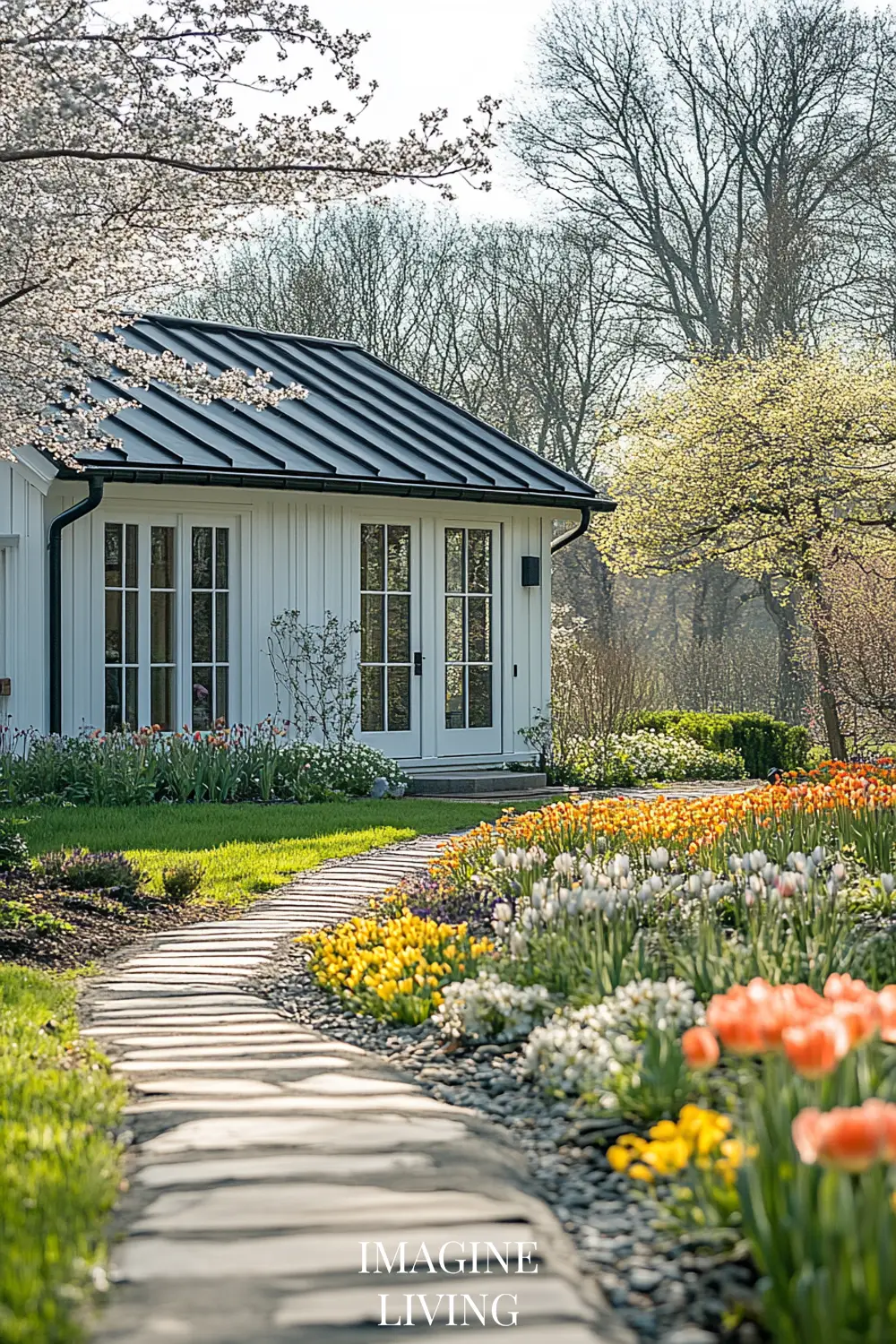
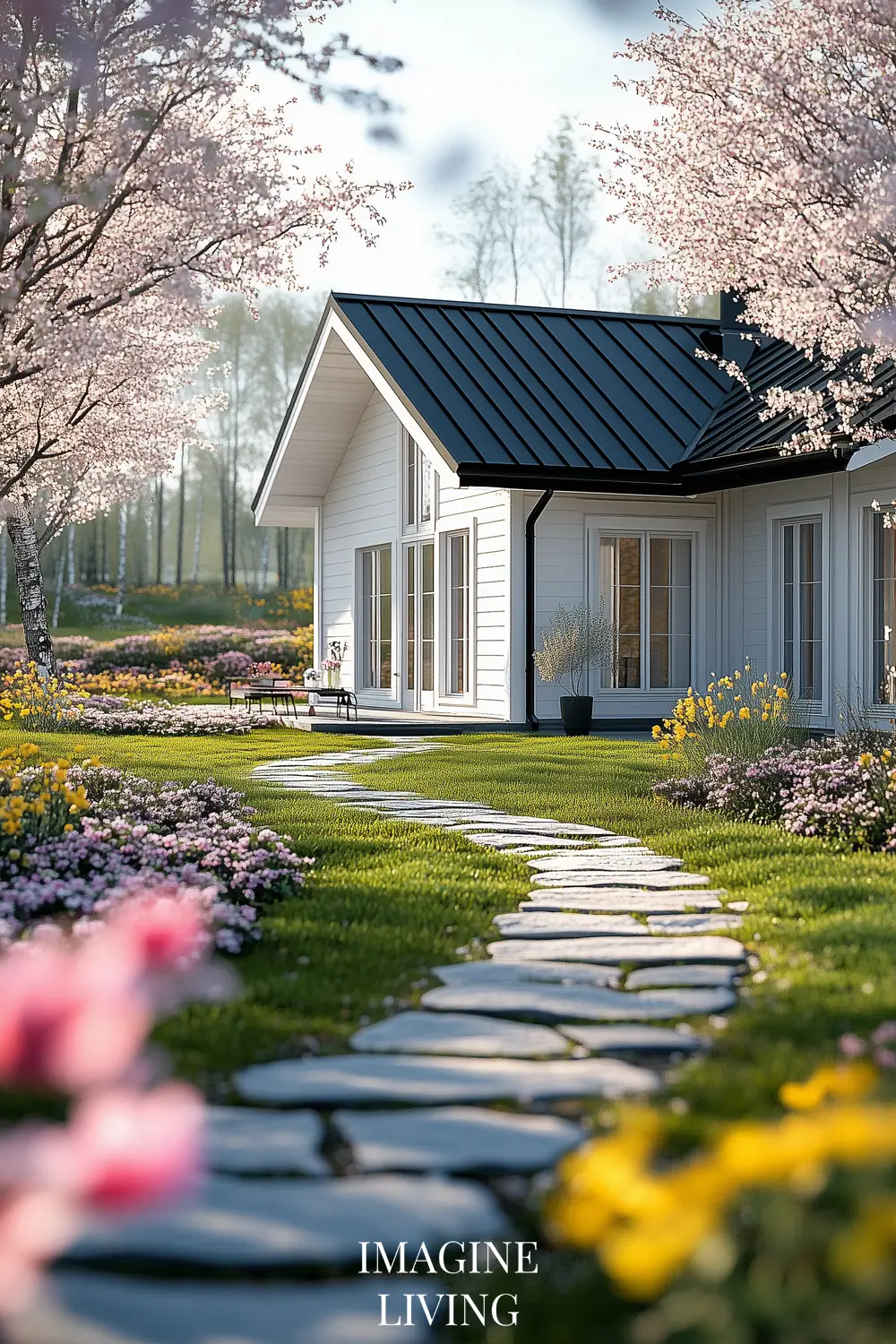
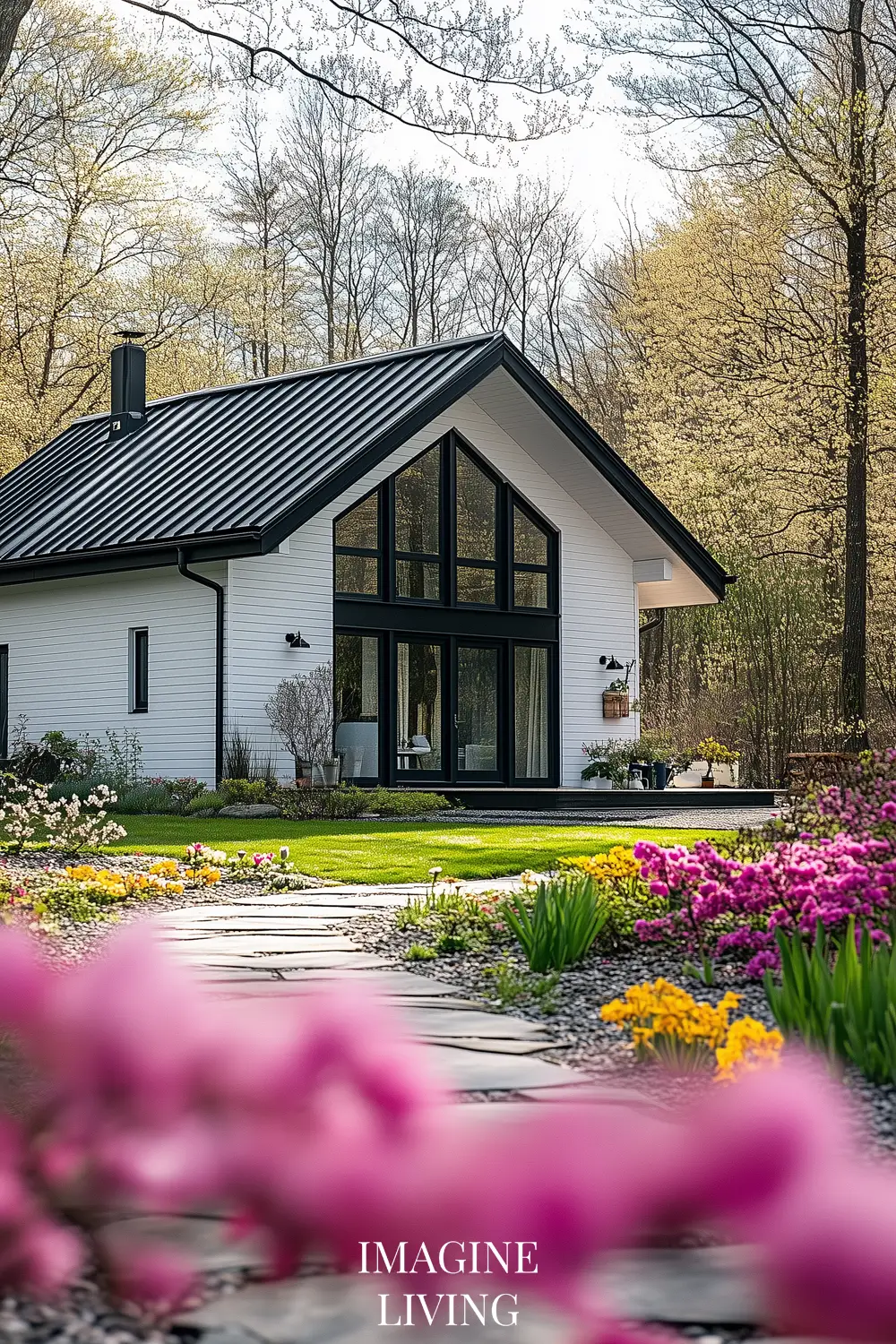
Conclusion: Scandinavian Simplicity with a Springtime Touch
A Scandinavian-inspired cottage is all about balance—clean, structured elements softened by the beauty of nature. By embracing minimalist design, curated landscaping, and a refined color palette, your home can exude the effortless elegance that defines Nordic charm.
Whether you’re working with a small patio or a sprawling countryside home, the Scandinavian approach to spring cottage styling is about making the most of what’s natural, simple, and serene. With intentional choices and a mindful approach, your cottage exterior can feel like a tranquil escape, seamlessly blending the modern with the organic.
